- Bookfox Academy (All Courses)
- Write Your Best Novel
- How to Write a Splendid Sentence
- Two Weeks to Your Best Children’s Book
- Revision Genius
- The Ultimate Guide to Writing Dialogue
- Your First Bestseller
- Master Your Writing Habits
- Writing Techniques to Transform Your Fiction
- Triangle Method of Character Development
- Children’s Book Editing
- Copy Editing
- Novel Editing
- Short Story Editing
- General Books
- Children’s Books

15 Boardgames to Help Writers
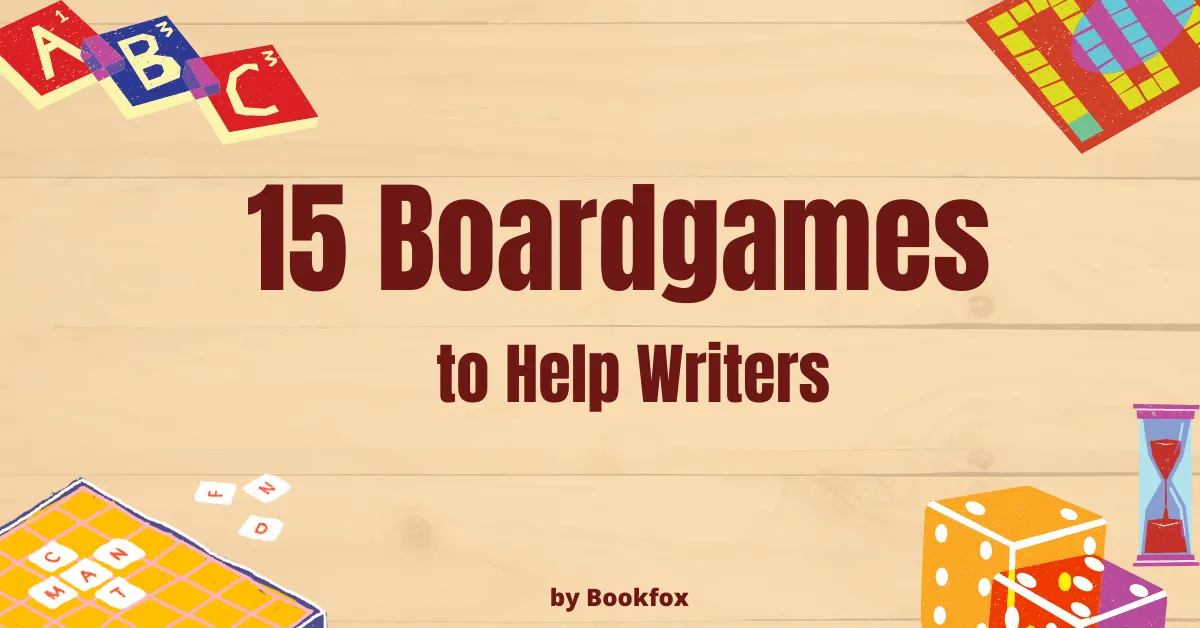
How to play:
1. The storyteller picks a card from their deck and describes it any way they want to.
2. The other players choose a card that they think also fits that description.
3. The cards are turned over and the players must pick the card that they believe to be the storyteller’s.
How it helps writers:
This game helps writers practice their descriptive skills. You’ll use figurative devices instead of relying on concrete details since you have to find a way to hint at the image rather than plainly describing it.
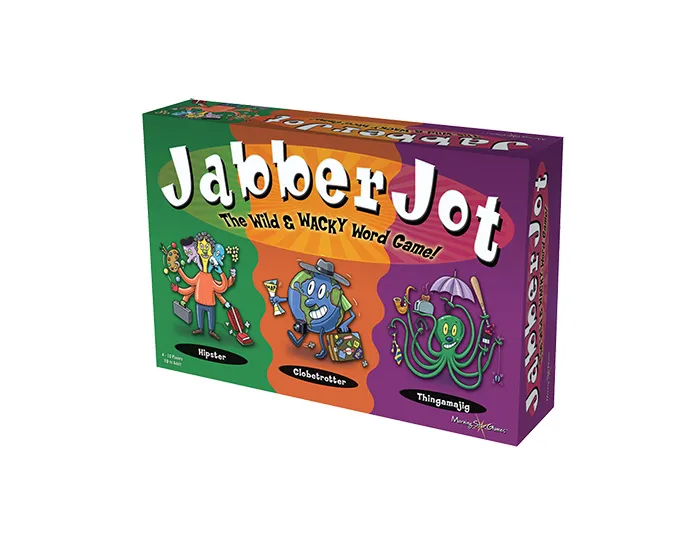
1. Each player must invent a story based on three pictures, three words, and a theme.
2. Once time has run out, one player reads all the stories out loud and selects their favorite one.
90 seconds to write a short story? What a trip! Writing under pressure will develop the crucial writing skill of working under deadline. You’ll have to think quick and use humor to win the round.
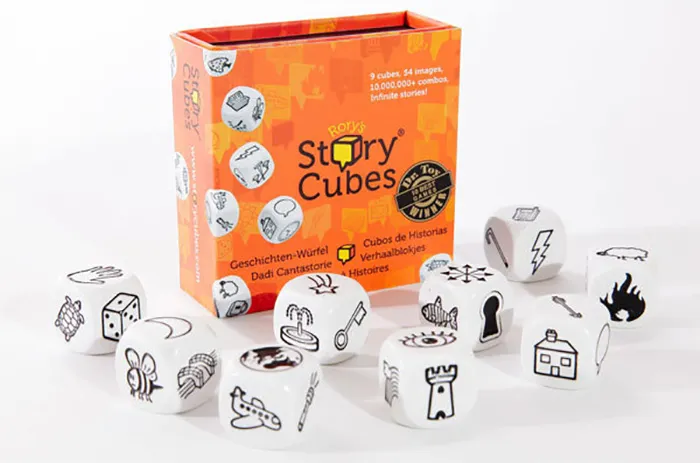
Story Cubes
1. Each player must roll the nine cubes and use all nine icons to tell a story.
2. You must begin by saying “Once upon a time,” but after that the story that follows is completely up to you.
This game is great if you find yourself stuck with a bit of writer’s block as it allows you to really engage with your imagination. Try using the cubes to help come up with fun new characters or adventurous new settings!
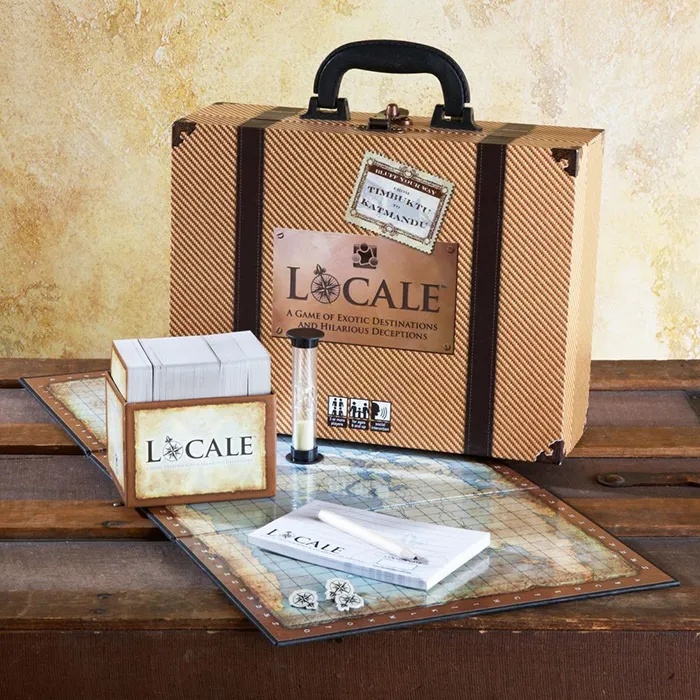
1. Players must create a story by describing and explaining as much as they can about a location.
2. Players win points for having the most believable story and fooling the other players.
How it helps Writers:
This game helps writers improve their description and imagery skills by forcing them to rely heavily on the classic “show don’t tell” rule. You will have to use figurative language and sensory details in your story to win the game.
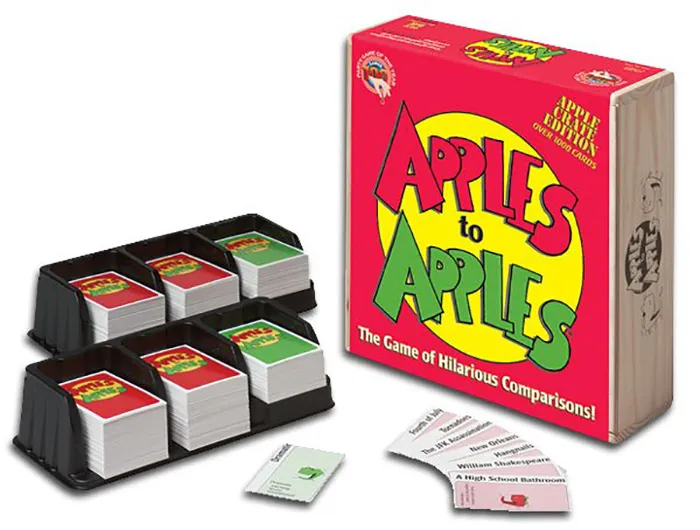
Apples to Apples
1. Instead of playing the normal way, substitute the red apple cards with a notepad and write down your own original response.
2.This response can be anything you want, but one way to play is to write a one sentence story that responds to the description word given by the green apple card.
This is a great way to practice short story and flash fiction writing! The time limit forces you to write a story that responds to the description word while still being entertaining enough to win. It’ll really help you learn how to make every word count; an essential skill in short story and flash fiction writing.
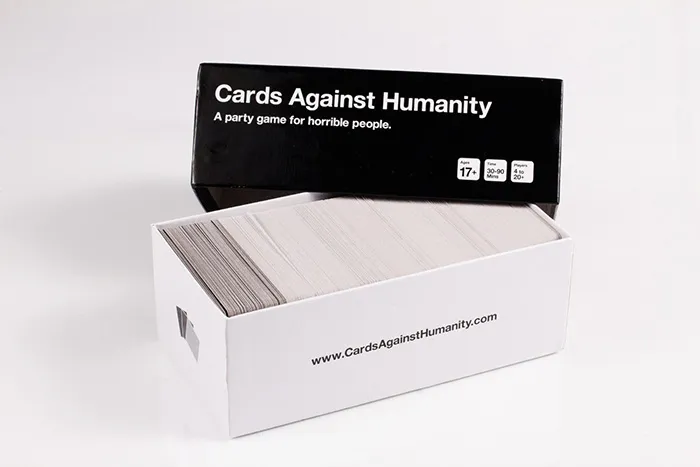
Cards Against Humanity
1. Instead of using the original game, buy blank cards and create your own version!
2. You can create your own cards that follow the same basic themes as Cards Against Humanity, or you can start from scratch.
3. One idea is to completely start from scratch and, on blank cards, write a one sentence story with some vital components missing and then either create response cards that will fill in the blanks, or allow players to write their own responses as you play.
You might want to avoid playing this one with the whole family… but regardless of how you choose to customize this game, creating your own cards will help you practice using comedic devices, plot writing skills, and coming up with interesting situations that you might not normally think of!
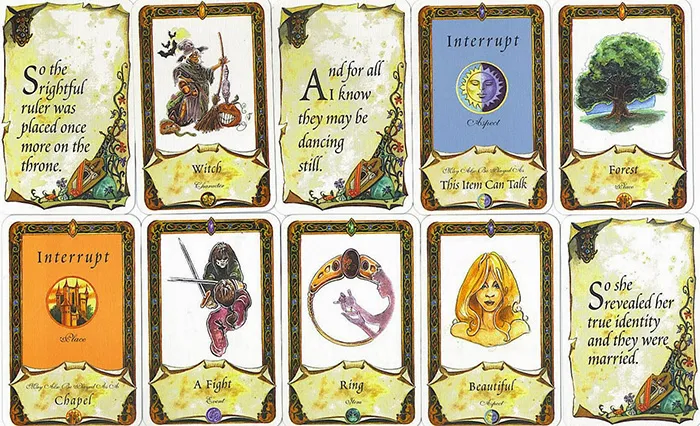
Once Upon a Time: The Storytelling Card Game
1. The storyteller will tell a story using the elements on their cards and try to finish the story with their ending.
2. Other players must try to interrupt the storyteller and take over the story.
3. The player who manages to use all of their cards and end the story wins the game.
Use this game to really put your plot writing skills to the test. While trying to steal the story away from other players, attempt to make use of flashbacks, plot twists, backstories, and maybe even try to create stories within the story.
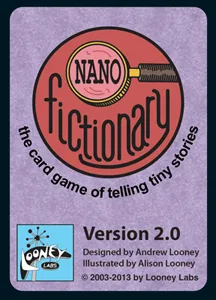
Nanofictionary
1. Each player takes cards from four separate decks in order to form a story.
2. Each player will continue to take and discard cards each round until they are happy with their story.
3. At the end of the game, each player has one minute to pitch their story. The player with the most votes, wins.
Whether you find yourself stuck with trying to come up with a decent pitch for your creative projects or you’re having trouble writing the introductory hook for your novel, this game will definitely help you practice your pitching abilities and refine your hook making skills.
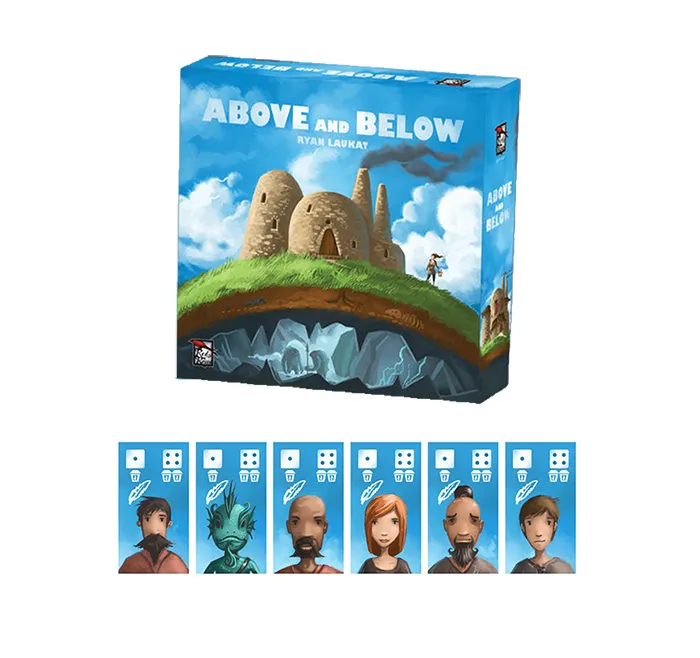
Above and Below
1. This game is a combination of storytelling and town building where the main objective is to use all aspects of the game to help your characters create the most successful village they can make.
2. During the game you’ll be using an encounter book that dictates what happens to characters during the game. You will be given a situation by the book but you will be able to choose the way your character responds to the situation.
This game will truly take you on an incredible journey and is a great way to experience different plot developments. But, if you’ve played the game enough and want to experience a new story line or just want to push yourself and practice plot development, why not write your own encounter book? You certainly don’t have to make it as long or intricate, but creating your own storyline for the game is a fun way to get creative!
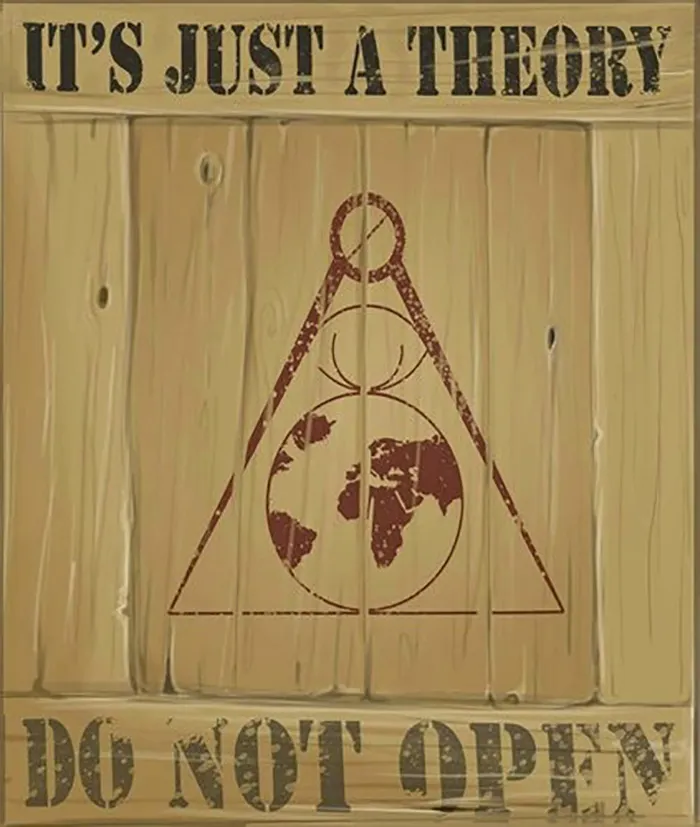
It’s Just a Theory
1. One player is the lead conspiracy theorist and will start the game by using their cards to come up with a conspiracy theory.
2. The other players must interrupt the lead theorist’s theory in order to take it over and challenge the theory.
3. The player that guides the theory towards his or her own ending and puts down their propaganda card first wins the round. The player who has ended theories as well as put down the most cards wins the game.
This game, like Once Upon a Time , helps players practice story structuring as well as plot writing! While trying to shift a theory away from another player, you will have to invent plot twists, backstories, events, and situations that you can use and further develop in your own writing.

1. There are four ways to play this game, but the one we will be focusing on is the story method.
2. Each player is dealt five cards face up and must then tell a short story using the five cards that they are dealt in the order that they appear.
3. Once all the players have told their story, everyone votes for their favorite and the player with the most votes wins.
This game is fun for the whole family and great for introducing children to story structuring skills! This game helps players of all ages with character development, and making use of plot devices.
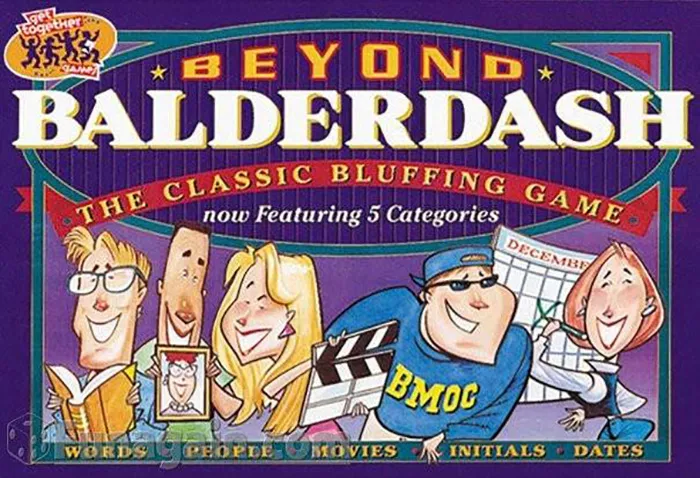
Beyond Balderdash
1. While Balderdash is a game where you try to fool the other players into believing your made up definition for unknown words, Beyond Balderdash contains new categories: movies, dates, people, and initials.
2. The objective of the game is to write your own answer for the category chosen by the leader and to fool the other players into picking your response as the true answer.
The new categories are what make this a fantastic writing exercise as well as a funny and entertaining game. Beyond Balderdash is great for helping players refine their plot development skills, character building, backstories, and help with creating situations that could be used in their own creative projects.
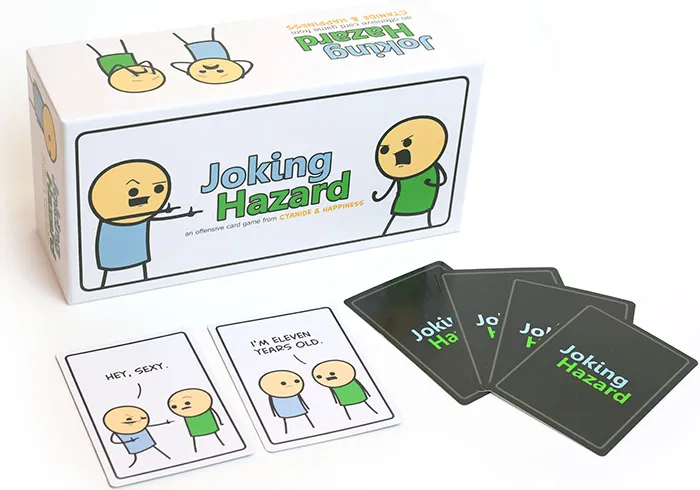
Joking Hazard
How to play: 1. Two cards are placed face up in order to create the start of a three panel comic strip.
2. Each player must put down a third card to complete the punchline of the comic strip, the judge will then pick a winner.
3. If you want a bit more of a challenge, why not try drawing and writing your own final card to finish the comic strip’s punchline?
This game is loads of fun with a similar tone to Cards Against Humanity (I wouldn’t recommend bringing this out at a family dinner unless, of course, you think your family would enjoy it!) and is great if you want to improve your comedic writing as it forces you to make use of any and all comedic devices. It also allows you practice using different comedic styles. Try making use of dry humor or maybe even play around with a slapstick situation.

The Book Game
1. In order to play this game you will need access to either your home library or you can just go on the book section of amazon.com in order to find books to use for the game, but make sure you are able to read the first sentence of the book if you are on amazon.
2. The moderator must find a book and then read out the title and blurb of the book to the other players.
3. The players will then come up with what they think the first sentence of the book would be, and write it down on a piece of paper with their name on it.
4. Players will then vote on which sentence they think belongs to the book. Players get points for each vote they get.
How it helps: This game will leave the whole family crying with laughter and is not only a great exercise in writing introductory hooks and opening sentences for stories, but also a great way to explore different writing styles that you might not normally use. Don’t be afraid to really go for it and branch out.
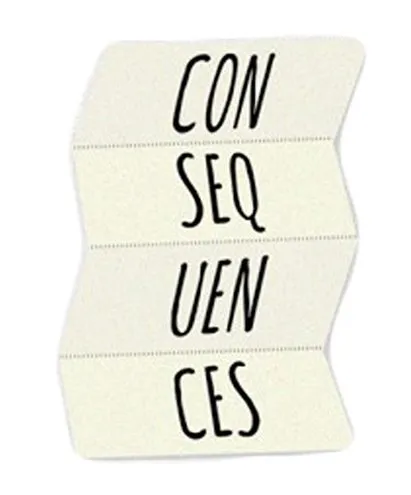
Consequences
1. You will need at least three players and a piece of paper each. Each player starts off by writing down a man’s name, and then folds the paper so that the name cannot be seen and then passes it to the next player.
2. The next player will then write down “met” and then a woman’s name, and once again folds the paper and passes it along.
3. The next step is to write “in” or “at” and the location where these two characters meet and, again, fold and pass.
4. Next write a line of dialog starting with “He said,” fold and pass.
5. Write another line of dialog, this time starting with “she said,” fold and pass.
6. To end it the player will then write a consequence: a result of everything that was said and done, for example “and they lived happily ever after,” or “so she left him trapped there (the location they met) and walked away never to be seen again”. The paper will be passed once more before each player takes turns to read the stories out loud. There is no need for a winner in this game but feel free to vote for your favorite story!
This game is a fun and engaging way to introduce children to story telling techniques as well as to help players of all ages with creating dialog. It’s also a really entertaining way to practice and examine different ways of incorporating plot twists into a story since you never know what another player is going to write!
Related posts:
No related posts.
Leave a Reply Cancel reply
Your email address will not be published. Required fields are marked *
One thought on “ 15 Boardgames to Help Writers ”
Great blog! I loved reading your blog and have also shared with others for reading. Keep sharing such blogs in future too.

Every writer NEEDS this book.
It’s a guide to writing the pivotal moments of your novel.
Whether writing your book or revising it, this will be the most helpful book you’ll ever buy.
- Skip to primary navigation
- Skip to main content
- Skip to primary sidebar
- Skip to footer
Helping Busy Moms Balance Diapers and Deadlines
Lisa Tanner Writing
Helping Moms Balance Diapers and Deadlines
Last Modified on October 26, 2023 By Lisa Tanner
10 of the Best Writing Board Games for Kids
This post may contain affiliate links. If you click through and make a purchase, I may receive a small commission at no extra cost to you. You can find my full disclosure page here .
If you’re a freelance writer, you likely want to pass your love of writing on to your kids. One way to do that is to play writing-themed board games together. Here are some to pull out for your next family game night.
In our homeschool, we often learn through board games. They’re an excellent way for kids to practice what they’ve been learning and try out new skills.
You can find board games for nearly any subject area, including writing and language arts. So if you’re looking for fun ways to practice these skills, the writing board games for kids below might be a great fit.
For each, I share a quick synopsis of the game, plus tips on how to use it to help your child develop their writing skills. You’ll even find some creative ways to play.
With these tips, you can pull out the game and let your child play solo – practicing critical skills while you get some work done.
And if you don’t have some of the games, they make great gifts! One of our family Christmas traditions is to get each of our kids three gifts each. One of them is something they can enjoy with their family. We often select a game we know they’d love for that gift, which is how we got several of these titles.
But whether you’re buying them for a Christmas gift or just because these writing board games for kids are a lot of fun!

1. Rory’s Story Cubes
Creative storytelling is an essential aspect of writing. You need to be able to think through your story and use your imagination to make things happen. Rory’s Story Cubes is a great game to help your children in this area.
You get three different Rory’s Story Cubes sets if you purchase the version listed above. It’s a fun way to add variety and mix things up. But feel free to pick out one to start with.
How to Play
This game doesn’t have many rules per se. On your turn, you roll the dice. Then, you use the pictures as inspiration to tell a story.
You can play independently, or take turns telling stories with others. You could even interrupt each other and take over the story. It’s pretty open-ended, which is a fantastic way for kids to play.
While playing, you can change the images to fit your story. For instance, there’s one with a flame on it. That could be a campfire. Or, it could be a dragon’s fiery breath. Wherever your imagination leads, there the dice go.
What They’re Learning
As your children play this game, they’re really working hard on their creative storytelling. They’re learning how to take random items and insert them naturally into their tales.
At first, some of the stories will seem very forced. But, as they practice, they’ll get better. You can really help them by playing together. Model good storytelling for them, so they can see some possibilities.
Other skills your children will practice by playing Rory’s Story Cubes :
- Communication skills
- Public speaking (well speaking to the other players at least)
- Taking turns
Expansion Activities
Let your child select the image on each die to use, and then write down their story. Younger kids can write just a sentence or two, while older kids can write entire pages of adventures.
You can also have your children draw the images on the die. Then, they can use them as cards to help them practice telling their story to others.
Another option is to have your kids pick one or two images and brainstorm all of the words that picture could represent.
2. Spark Cards – Sequencing Card Game
I first heard of this game while working with an SLP. It’s such a good game for children to practice their verbal communication and expressive language skills.
This game comes with eight different sets of story cards. There are six cards in each set. However, for younger players, you can remove some of the cards to make it a bit easier.
Like with the game above, this one is pretty open-ended. Here is one way you can play:
Set out the cards you’re working with, and ask your child to sequence them for you. They should look at all of the cards and figure out what happened first. Then they can find the event that happens next, and so on.
When the cards are in order, they can share the story.
As your children play this game, they’re practicing sequencing. Knowing what order events happen in is an important skill for any writer. Otherwise, their story won’t make sense.
These cards also provide the opportunity to use transitions. Your child can use words such as “Next, then, and last” as they describe the story. These are keywords for writers.
Other skills your children will practice by playing Spark Cards :
- Answering W questions (who, what, when, where, why)
- Adding details
- Observation and attention to detail
- Understanding the beginning, middle, and end of a story
Your child can set out all of the cards and sort them by story.
Or, your child could write down the story they told. They can add their own pictures.
You can challenge your child to take their favorite story and create a set of Spark Cards for it. They can draw the key plot points, making sure to hit the beginning, middle, and end.
3. Tell Me a Story
This game is one of our favorites, and I even dedicated a whole post to it on my homeschooling blog. You can find that here:
15 Ways to Practice Literacy Skills with Tell Me a Story
This game can be played in a couple of different ways. Here is the one we do the most often.
First, shuffle the cards together. Then, deal them out. It’s okay if one player ends with more than the rest.
Then, each player places their cards out in front of them, so they can easily see what they have.
One person goes first. They select one of their cards and put it into the middle of the table. Then, they start the group story. They might start with something like, “Once upon a time, there was a magical island where a fairy lived.”
The next person then selects a card of their own. They play it to the middle of the table, next to the first card. Then, they continue the story. They connect what was already happening to their new card.
Play continues until all of the cards are used. Expect the story to take many unexpected twists and turns along the way.
While playing this game, your child will be practicing creative storytelling. They’ll also be working on their creative thinking since they’ll need to mix things up in the story to help it all make sense.
Your child will learn more about story elements, including characters, settings, and events.
Other skills your children will practice by playing Tell Me a Story :
- Listening skills
- Thinking critically
- Thinking quickly and coming up with new plans when the ones they were planning on no longer work
There are so many fun ways to play this game solo. It’s one that my kids frequently pull out during Family Writing Time .
You can have your child write down the story that you all worked together to make. They can even add illustrations and turn it into a book.
Your child can pick out five or six cards, and use those to create their own story.
They can also draw a picture of their favorite scene. They can add details that weren’t in the game cards to make it their own.
Your child can look at all the cards and make character profiles for each character. This will help them dive deeper into character creation, which is an important writing skill.
4. Spying Parts of Speech Board Game
Grammar is an important part of writing. You want your kids to have written language skills that make their writing easy to understand.
This educational board game helps them get a better handle on the parts of speech they’ll use as they write.
This game has several different levels of play, so it’ll work for a large range of ages. It’s recommended for two or three players, from age 7 and up. I’ve found it’s great for second graders on up.
There are two board games and three sets of cards, so you’ll want to find the one that’s most appropriate for your youngest player at first. This way, everyone can learn how to play. Then you can try mixing it up to make it more of a challenge.
On your turn, you spin the spinner to see how far you move. Then, you do what the space says. You may need to draw a card or identify the parts of speech that are underlined in a sentence.
As you go around the board and complete the challenges, you’ll earn points. The game ends when one player reaches 15 points.
While playing Spying Parts of Speech, your child will practice identifying different parts of speech. They’ll see how the parts go together in a sentence.
Other skills your children will practice by playing Spying Parts of Speech :
- Counting points
- Naming different nouns, verbs, and adjectives
If your child wants, they can pull this out on their own and go through some of the cards. They can draw pictures of the sentences and identify the different types of words.
Your child can also create sentences on their own. Then, they can color code the nouns, verbs, adjectives, and pronouns they used.
They can create a list of all of the nouns they find in the room. Or make a list of all of the verbs a cat could do.
You could give your child sentences that are mixed up and let them try to put them in the correct order based on the parts of speech.
5. Disney Tell Tale
This game is so fun that we got two different versions. We have the Toy Story one pictured above and the Disney Princess one.
In each game, you’ll find about 100 cards with different characters, settings, and things from the Disney story it’s about. With these, you can tell an unlimited number of stories.
There are three different game variations included in the rules, so be sure to check them all out. Our favorite way to play involves giving each player six random cards.
Then, each player creates their own unique story with the cards they have.
There are also ways to play that involve combining your cards, but my kids prefer to tell their own instead of mixing things up.
As your child plays Tell Tale , they’re learning to take familiar characters and create new adventures for them. This relies on creative thinking.
At first, don’t be surprised if your kids stick to familiar story points as they play. However, do encourage them to think about what happens next or what else could have happened. With your encouragement to be creative, they’ll be spinning their own stories before you know it.
Other skills your child will practice by playing Tell Tale :
- How the setting affects the story (how would Cinderella be different if it happened underwater?)
- Character development
- Creating a story with a beginning, middle, and end
- Creative thinking – how to use random things in one story
- How parts of stories (such as fairy tales) are similar, even across different tales
Challenge your kids to pull out all of the cards and sort them somehow. They might come up with a character pile, a setting pile, and another pile. Or maybe they’ll sort them by story (works better with the Princess version of the game since it has multiple stories included.)
You can also have your kids type up a story using the cards they drew. This way, they can get some tech involved and practice their typing skills.
They can also handwrite the stories.
You could ask them to create a comic book out of their story. Or draw a few new characters to add to the mix.

6. Scattegories
My family has been playing this game for years. It’s so much fun.
Before you start playing, the players agree upon a list to use. There are several to select from. I typically let the youngest child pick the list when I play with my kids. Then, we go up numerically from there on subsequent rounds.
But you can do that part however you’d like. Once the list is selected, one person rolls the letter die to see which letter you’ll work with.
Then, start the timer to start the game round. Your goal is to write a word that matches each item on your list that begins with the letter rolled.
So if your list asks for a girl’s name, and the letter is W, you might write down Wanda.
When the timer is done, stop writing. Now, it’s time to share answers and discover your score.
However, you get points only if no one else has the same word, so you’ll want to be creative.
The person with the most points wins the round.
What They’ll Be Learning
While playing Scattegories, your child will be working on their word choice. This is essential for writers.
You want to pick the right word that starts with the correct letter that isn’t going to be written down by anyone else. That requires a bit of critical thinking as well.
Other skills your child will practice while playing Scattegories :
- Handwriting
- Parts of speech (need to write down nouns, not adjectives)
- Comparing words (does what the other player wrote down match the clue?)
To help your child get more out of this game, challenge them to create a story using the words on their list.
Or, have them pick one clue and create an alphabet list for it. They can write down one word for each alphabet letter that fits that clue. You can have them use a dictionary or internet resources for this one if you’d like.
They could also make their own unique list to try the next time you play. Maybe they have some favorites from each list they could combine or create their own entirely.
For kids who enjoy drawing, you could have them come up with picture clues for each word on one list. What icon or image could they draw so everyone would know the category?
7. Balderdash
Before we got the actual board game version of this game when I was a child, we used to play our own using an actual dictionary. We called it simply “The Dictionary Game.”
In this game, your goal is to develop your own unique definition of an unknown word. But your definition needs to be so good that you convince the other players that this definition is the actual one for this word.
One person selects a card and reads the word aloud. Then, each player writes a definition. While they do that, the person who drew the card gets busy writing down the actual definition.
Then, all of the definitions get shuffled together, and the player who wrote the real one begins reading them aloud. Each player listens carefully, and decides which one they think is real.
When all definitions have been read, it’s time to reveal the truth. If you voted for the true answer, you get some points. You also get points for anyone who voted for your definition.
The first player to make it across the board wins.
As your child plays Balderdash, they’re working on their vocabulary and critical thinking. They’re also learning to think quickly and write a definition that sounds like it came from the dictionary.
They also have to write neatly enough that someone else can easily read their answer, so handwriting is also worked on.
Other skills your child will practice while playing Balderdash :
- Listening carefully to all of the definitions
- Thinking about which one makes sense
- Identifying parts of speech
- Reading aloud (when it’s their turn to be the Dasher)
To have solo fun with Balderdash, your child can use a dictionary to create a list of unknown words. You can use these in a future game.
They can draw pictures illustrating the new vocabulary words they learned or try to write a sentence using as many as possible.
Your child could pick five cards and look up the definitions for each word. It’s a great way to practice dictionary skills. They could also consult a thesaurus and find synonyms. That’s always important for writers.
8. Taboo Kids vs. Parents
My husband and I first played the original Taboo game at a church game night in San Diego. It was such a fun game we bought a copy for our game collection.
Unfortunately, many of the words in it are hard for kids. So, I was thrilled to discover this version! While we haven’t technically played it yet, it will end up underneath the Christmas tree this year, and I’m looking forward to it!
Like in the original Taboo, your goal is to get your teammate to guess the word you’re describing. However, you can’t say any of the forbidden words. If you do, you get buzzed by the beeper. If that happens, that point goes to the other team.
This version has a kids’ deck and a parents’ deck. The words on the kids’ deck are geared for kids. They also only have two forbidden words to make the game a bit easier.
You get to go through as many cards as possible in one minute. Then, it’s the other team’s turn. After you’ve played as many rounds as you want, the team with the most points wins.
Your child will practice their vocabulary while playing Taboo: Kids vs. Parents. They’ll have to think about how to describe a word without using any of the forbidden ones.
As they play, they’ll also have to try to guess words when it’s their turn to guess. Can they listen carefully to the clues to discover the word?
Other skills your child will practice while playing Taboo: Kids vs. Parents :
- Descriptive language
- Creative thinking
- Turn-taking
To encourage even more learning through play with writing board games, have your child take down this game on their own during Family Writing Time. They can create pictures for some of their favorite words.
Or they can create their own cards. What words could they include? Which forbidden words would make the most sense for those?
They can also pull out the adult cards and give them a try. They could think about how they’d describe this word without using any of the forbidden ones. Then, they can write down their plan and try it on you later.
Your child could also draw five random cards and create a story using one word from each card. It’s a fun story-creation challenge.
9. Apples to Apples Junior
Most of my kids now enjoy playing the original version of this game . We also have the Disney version . No matter which one we play, it’s a ton of fun on family game night.
There are two types of cards in Apples to Apples: red and green. The red cards can be used to describe the green ones.
Each player begins with a handful of red cards. Then, one player starts the game by flipping over a green card and reading it.
The other players then look at their red cards and decide which one in their hand is the best fit. They play this card to the center, upside down.
When all the cards are in, the person who is it grabs the stack and begins reading them aloud. Then, this person selects the card that they think is best. The player who played that card wins the green card for that round.
Then, in the next round, a different person flips the green card. Play continues until one player collects enough green cards to be declared the winner.
As your child plays any version of Apples to Apples, they will compare and contrast words. They’ll have to look at the words in their hands, read the definitions, and decide which one is the best match.
On their turn to judge, they’ll also have to think critically about all the options and decide which fits best.
Other skills your child will practice while playing Apples to Apples Junior:
- Creative thinking – you can play cards geared toward the judge
- Synonyms and antonyms
- Being able to explain why they played the word they did (you can argue why your word is best if your family allows it during the judging stage)
Your child can play this game in fun ways all by themselves. You can challenge them to sort the cards alphabetically. Or categorize them in some way.
They can pick five cards and use them to create a story. Or draw illustrations of some of their favorite words.
They could pick a green card and flip through the red ones to find the VERY BEST fit for it, in their opinion.
10. The Storymatic Rememory
Sharing memories is a fun way to spend time together, and this game encourages just that.
This game comes with several different gameplay options you can try. It’s a conversational game, not one with lots of competition.
One way to play is to draw a card from each of the three decks. Then, you ask the question:
“When you look at these three cards, what memory do you have?”
There’s no right or wrong answer. Each player will have their own unique memory to share. It’s a great way to learn more about each other or get to know someone better.
As your child participates in the Rememory game, they’ll recall memories and details. These are key components for writing.
They’ll also be practicing sharing stories with others. This is something that some kids struggle with, so it’s a great way to help encourage them to share.
Kids will also be listening. They’ll hear what memories other family members or friends have, and learn that not everyone views the same event in the same way.
Other skills your child will practice while playing Rememory :
- Making connections between words
- Comparing memories
- Self-reflection
There are so many great ways to expand this game. Have your child listen carefully to the stories a Grandparent or another relative shares. Then, have them create a picture book detailing one of the memories. It will be a great family keepsake.
They can also write down their own memories in a journal. It can help spark the interest of self-reflection and getting things out of their head and onto paper.
You can have your child read some autobiographies and compare them to a biography of the same person. This will help them to see how people might portray themselves differently to different people.
The Best Writing Board Games for Kids
Have you played any of these writing board games with your kids? Did you find any new ones to try?
If you have any other recommendations, I’d love for you to share in the comments below. After all, writing board games are an excellent way for your kids to pick up on your love of the written word and perhaps even see themselves as writers in the future.

Lisa Tanner
Lisa Tanner is a former teacher turned homeschooling mom with 11 kids. She's also a successful freelance writer. Lisa enjoys helping other busy moms find time to start and grow a side hustle of their own.
Reader Interactions
December 1, 2020 at 9:03 pm
December 4, 2020 at 9:06 pm
Thanks Karen! Learning should definitely be fun for the kids – it’s something they should be doing their whole lives, so there’s no point in making them hate it!
December 7, 2020 at 4:46 am
This is a great list! Thanks for the quick game summaries!! I’ve only played about 3 of these and I’m always looking for new games for our family. I especially love that these games could be incorporated into homeschooling! I will be putting some of these on our Christmas wish list!
December 7, 2020 at 5:18 am
So glad you found some new games to try Jenny. I hope your family enjoys them as much as mine does!
[…] [Save Images | Source] […]
You Might Also Love

Get tips for growing a business while raising a family

- Tools and Utilities
12 Superb Solo Worldbuilding and Roleplaying Games for Writers
For those of us that find ourselves doing a bit of creative writing, whether for a story, tabletop campaign,, or the next bestselling fiction series, sometimes inspiration can be a fickle thing. You might find yourself stumped for where to take the story next, what the characters would do in a certain situation, or just in want of a more vivid perspective of the world the characters live in. When you’re feeling like your well of inspiration is a bit dry, solo tabletop roleplaying games could be just the thing you need!
By stepping out of your normal writing process and into one of these games, you might find yourself put in new situations and seeing things from new perspectives. When it all comes together, this can lead to some truly wonderful, creative, and inspiring situations.
What are solo tabletop roleplaying games?
Most people would be most familiar in the concept of a ‘tabletop roleplaying game’ in the form of the famous and wildly popular game Dungeons & Dragons. You dream up a character, use the game’s rules to give them abilities and skills, and then sit with your friends and have your characters work together to overcome challenges put forth by the game master (or dungeon master, in this case). They’re a wildly fun and creative experience that force you to engage your imagination and skills in new ways.
Many solo tabletop roleplaying games are similar to collaborative games, in that you’re using your imagination as well as other tools (dice, cards, pen and paper, etc) to visualize situations and stories, as well as what happens next.
There are a good number of games out there that are aimed at allowing a player to have the full tabletop roleplaying game experience, emulating that experience through a variety of strategies and tools.
Even more niche are the solo journaling games, which are often more creative tool than adventure game. These games usually encourage you to actively write creatively to narrate the action of the game, and you’ll often walk away with some journal pages (or a note document on your phone) stuffed with bits and pieces of their experience that interested them.
How can writers use solo roleplaying games as writing tools?
While these games are almost universally fun and/or interesting, they can have a huge impact on inspiration and creative thinking for writers. By stepping into the role of someone in one of these games and framing the action to reflect some aspect of a world from your own projects that you’d like to learn more about, you’ll almost always discover something interesting and compelling.
Creative writers can pick up and use solo tabletop roleplaying games, not just as not just an entertaining game experience, but a helpful and powerful tool.
As an example, the first game on this list is Journey, which I created specifically as a worldbuilding game. If you wanted to know more about the past, present, and future of specific locations within the world of whatever it is that you’re writing, the process of Journey would help you step into the shoes of someone in that place. You’ll examine locations in that place, zoom in on various aspects of your location, and find new details that you might not have even considered otherwise.
Online Marketplaces Referenced Below
Since the tabletop community tends to have certain digital marketplaces where games and books are sold, they’re not always familiar names to writers. Aside from Amazon, the two marketplaces below are also mentioned alongside many of the games on this list.
What is DriveThruRPG?
You’ll see a good number of the game below directing you to a website called DriveThruRPG for more information or to buy the game, and if you’re a writer who doesn’t play tabletop roleplaying games already, that name might be completely foreign to you.

DriveThruRPG is one of the biggest digital marketplaces for tabletop roleplaying games anywhere, and a lot of publishers (including Graycastle Press) publish their games there. They offer digital sales as well as handle POD sales and fulfillment for game designers, which is very compelling when tied to the large audience the website has.
All that to say, DriveThruRPG is a known and trusted name in tabletop roleplaying games, so if you decide to purchase one of the games below through them, know that it’s not some shady fly by night website.
What is Itch.io?
Itch.io is another lovely marketplace that is open to games and materials of all kinds. You can find a lot of games to be played on your desktop, pen and paper tabletop roleplaying games, resources to create games of all stripes of your own, and a ton more.

Like DriveThruRPG above, Itch.io has a very good reputation in the tabletop roleplaying game community, especially among designers and writers of games that are only in digital format.
What are some great solo tabletop roleplaying and worldbuilding games for writers?
Clearly these creative games have some great potential to help writers dig up some new inspiration and creative ideas. Next time you’re looking for some way though writer’s block or to answer a challenging question in your story, try picking up one of the games below for a little help.
The bestselling solo tabletop roleplaying and worldbuilding game
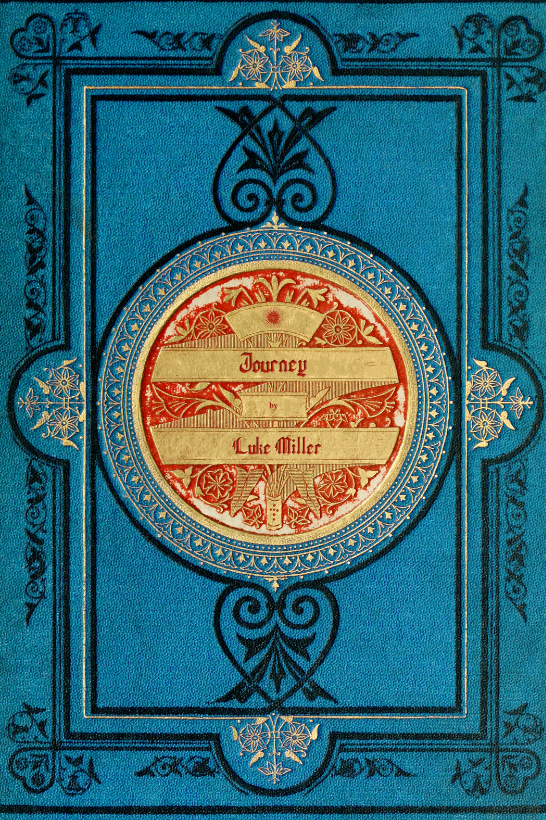
Full disclosure, this bestselling solo worldbuilding and roleplaying game was created by myself right here at Graycastle Press. So I may be a bit biased. Because I really think that Journey is special.
In Journey, you can explore the locations in your worlds in an engaging and immersive way. The setting that you explore can also be of any size and scope, from something as large as a galaxy to something as small as a single room.
This game has you select an entity within the space you want to explore and step right into their shoes. You’ll travel from place to place, imagining what the process of that travel would be like, and deeply explore interesting aspects of your destination that may never have been discovered otherwise.
Luke’s Take
Journey is a flexible and useful game (that I made myself) for writers who want to immerse themselves inside of their worlds and explore them in a new way.
Available in Digital and Paperback on DriveThruRPG
Available in digital and paperback on amazon, available in digital on itch.io, learn more about journey on graycastle press, mythic game master emulator, the classic option to let the game drive the action.
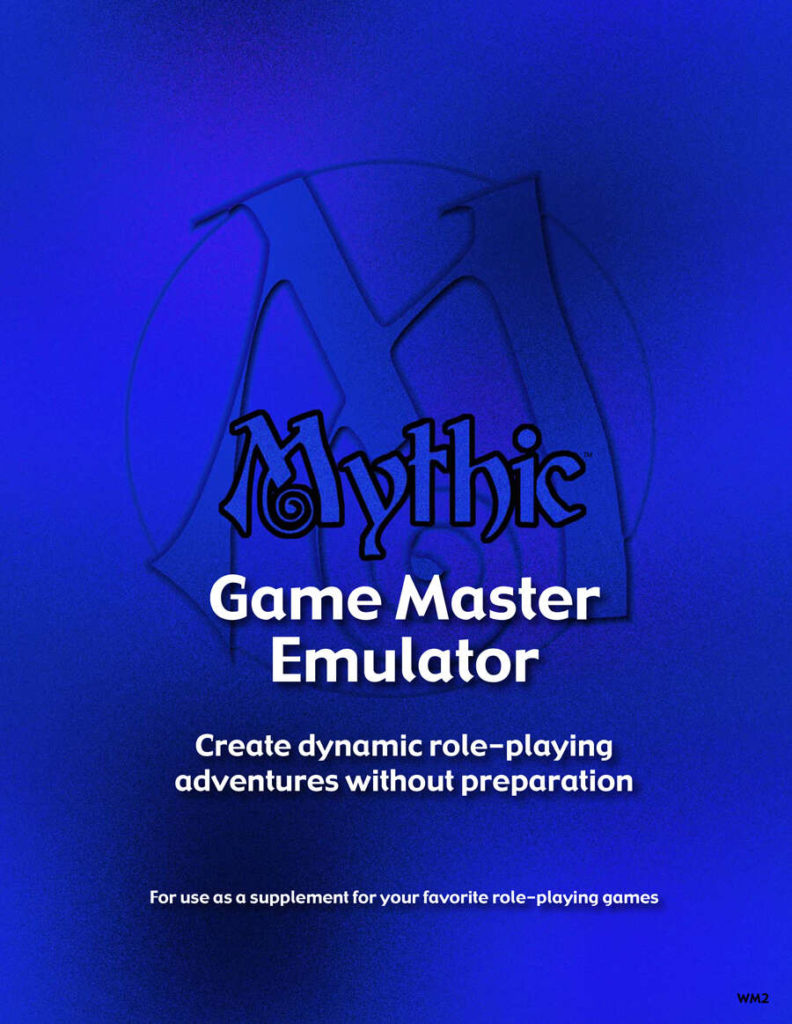
Where many games on this list tend to be more self-contained and narrative experiences, Mythic could realistically be used to let you run any typical tabletop roleplaying game without a game master, or entirely by yourself.
Rather than a guided narrative experience, Mythic uses a combination of their Fate Chart (a table of probabilities for how a question might be answered based on a few factors), some tabletop roleplaying game dice, and some other neat features to help drive the action of a scene. The whole process involves asking Mythic a question, one that can be answered clearly with a yes or no, and allowing the Fate Chart to determine the answer. You’ll have to interpret the Fate Chart result through the lens of your story and question, but you’ll likely find the guidance and randomness inspiring and useful.
It also takes the “chaos” of the action into account as a way to modify the result of your question’s answer, which can lead to some interesting and unpredictable results.
There’s enough to Mythic that it will likely get it’s own whole post here on the Graycastle Press Journal, but it all adds up to a really cool way to think through the flow of action and reaction in a scene.
Mythic is a fantastic solo roleplaying resource for writers who want to let this proven game master emulator help answer their questions and drive them towards new discoveries. Use it to think through how characters might move through a scene and address challenges, as well as the results of those actions, finding new ideas through the use of their Fate Chart.
Available in Paperback on Amazon
Alone among the stars, the game about traveling through space and discovering wondrous new places.

As one of the two games I credit with inspiring what ultimately became my first game Journey, Alone Among the Stars is a fantastic little game. Where Mythic is a bit larger and seeks to provide a pretty robust framework, Takuma Okada’s solo roleplaying game gives you more of an open platform to explore some creative ideas.
In this game you’ll find yourself traveling to a planet that you’ve never seen before, rolling a standard six-sided die to determine how difficult that travel is, and then using playing cards to determine what you discover there. Is it inhabited? Is there intelligent life there? What do these alien vistas look like? By using the prompts generated by your drawn cards you’ll dream up wild new places, never before seen by human eyes.
Writers might find it useful to explore their own worlds this way, drawing cards and using the tables from Alone Among the Stars to get some new inspiration for what fills it, or some new ideas of things that could be added. You might find something unexpected in a world you are confident you know inside and out.
Available in Digital Format on Itch.io
The game exploring the stories surrounding mythical items of legend.
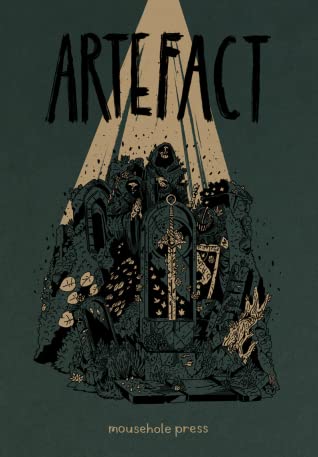
This is the second of the games that inspired me to create Journey, along with Alone Among the Stars, above.
Rather than looking at the action in your scene or the physical spaces and locations in your worlds, Jack Harrison’s Artefact helps you explore the histories and stories that surround the magical and influential items throughout your world.
Artefact has you choose a legendary item in your world, whether that’s a weapon, a book, a musical instrument, or a variety of other kinds of item. You’ll then step through the mists of the ages, following your chosen item as it moves from person to person throughout time, exploring how these Keepers have used the item in legendary ways.
Especially if your story features influential and powerful objects, Artefact gives you a framework that allows you to dive through time and learn more of how these items have impacted and shaped history. You’ll come out the other side of a session of Artefact having seen flashes of your world’s history and a better understanding of what may have changed over that course of time. You’ll also have a more interesting and complete view on the item that you chose.
Artefact was the first game I played that encouraged you to focus your whole session around a single specific subject and spend some time dreaming up stories and histories about it. I still find it wildly entertaining and inspirational, and it’s helped me dream up some truly interesting stories for my writing and my tabletop roleplaying game campaigns.
Available in Digital on Itch.io
The game of creative history building.
7/3/22 – Quick Disclaimer from Luke: It was pointed out to me, correctly, that Microscope is not actually a solo game, despite a subset of players using it that way. The creator has actually clearly laid out that playing this game with others is a core part of the process, and playing alone will cause you to lose out on critical parts of the experience. I’m leaving the game on this list with this disclaimer, though, as it’s such a stellar example of the genre and an incredibly creative tool, despite not being strictly a solo game.

Often we can understand the present by exploring the past, or use the present to inform a view of the future. Microscope by Ben Robbins is an award winning and bestselling game that sees players creating vast histories of a universe, jumping back and forth through time to learn more about the causes and effects that have and continue to shape the world in which you’re creating.
By applying the process of playing Microscope to your setting you’ll find out how things became the way they are, the formative experiences and events that have shaped the stories of the people and places of your world. It’s something you just have to try, because once you do, you’ll be hooked.
I think that Microscope’s description does a really great job of selling the whole “jumping around in time to explore cause and effect in a universe” idea:
You won’t play the game in chronological order. You can defy the limits of time and space, jumping backward or forward to explore the parts of the history that interest you. Want to leap a thousand years into the future and see how an institution shaped society? Want to jump back to the childhood of the king you just saw assassinated and find out what made him such a hated ruler? That’s normal in Microscope. From the official description of Microscope
Honestly, Microscope is a freakin’ exciting game. I’ve gotten so many interesting ideas and points of view on my worlds by exploring their histories, and whether or not I used all of those ideas in my projects, I’ve never regretted the time spent dreaming them up.
Available in Digital on DriveThruRPG
The game about building immersive cities and towns.

When writing and creating in your worlds and interacting with larger settlements of people, it can be helpful to feel like you more deeply understand those cities and towns. Knowing why these places are the way they are, and knowing where points of interest are located within them, can make your stories set in these places more vibrant.
Ex Novo by Martin Nerurkar and Konstantinos Dimopoulos puts you in the role of the guardian spirit of a newly founded settlement somewhere in your world. You’ll then move through four phases of the game that explore your assumptions and expectations of what you’ll learn, the space around the settlement and events of its founding, it’s growth and development over time, and where it is now.
You’ll walk away from your session of Ex Novo with a deeper understanding of this settlement, why people gathered there and brought it into being in the first place, and the events that have transpired there over the course of its history to bring it where it is today.
Oh, and you’l have a hand drawn map of your chosen settlement, too, which is wildly fulfilling to look at, admire, and iterate on as the basis for more fully formed maps.
This game is so good for dreaming up new settlements or exploring the history of places of interest in your story. Ex Novo has helped me explore the histories of a few places in my projects, and it’s always neat to see their growth and changes over time from the perspective of the location’s guardian spirit.
The game of legends and deeds
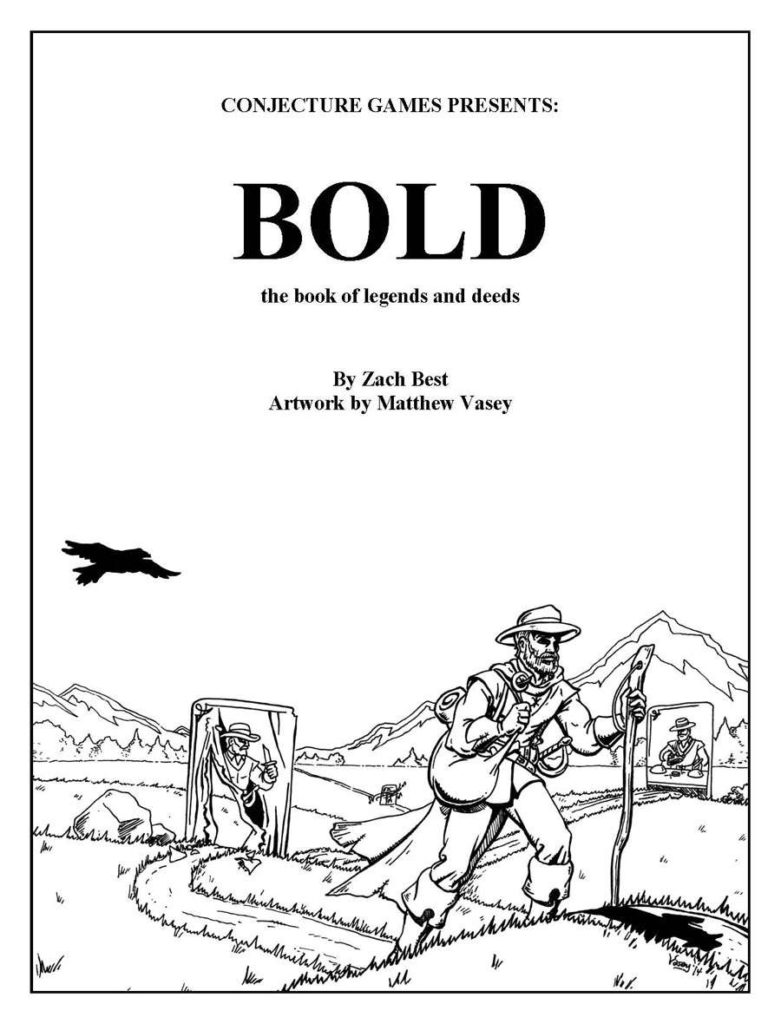
Less a full game and more a tool for telling stories, Zach Best’s BOLD (The Book of Legends and Deeds) is a really amazing tool for instantly adding histories of brave deeds and exciting legends to any character. You’ll see how those characters overcame those challenges in interesting and compelling ways, adding depth and color to these people.
Playing BOLD just requires the book, a handful of dice rolls, and your imagination to flesh out your characters in interesting, new ways. You can apply it to any character in any setting, from fantasy historical fiction, and give them a whole new dimension of connection to the world around them and a sense and weight of history.
When you want to deepen the stories around the characters in your stories, BOLD is a really unique and interesting way to do so. You can even use it to generate stories around other things in your books, like histories surrounding objects and locations. It’s a really need and well-established tool that might help you generate some really interesting ideas.
The game exploring the stories around documents, books, and maps in a fictional library
Similar in some ways to Artefact, above, Archived is a game that sees you following the history of a specific item. However, in this case, the item is not necessarily one that has featured in grand, historical events. Instead you step into the role of an item in the collection of a library.
Over the course of a session of Archived you, as your chosen document in this library, will experience patrons engaging with you, using you and the information you contain, and eventually placing you back on your shelf to wait until you’re taken down once more. You’ll experience the passage of time, the intervening years alone on a shelf, and feeling your physical form changing over that time.
It’s worth noting that the game’s page has a content warning regarding the book exploring the topics of loneliness, isolation, and of being used. They recommend playing at your own pace, stopping when needed, and taking care of yourself. Which, honestly, is pretty good advice for life in general.
While possibly more difficult to slot in to solving a specific problem or challenge for writers, playing through Archived is a super creative and interesting look at the sources of knowledge in your world, as well as an exploration of how people in the world use and apply that knowledge. Who knows what inspiration for your project is hidden in those stories?
Available in Digital from Itch.io
The game of map drawing and city building.
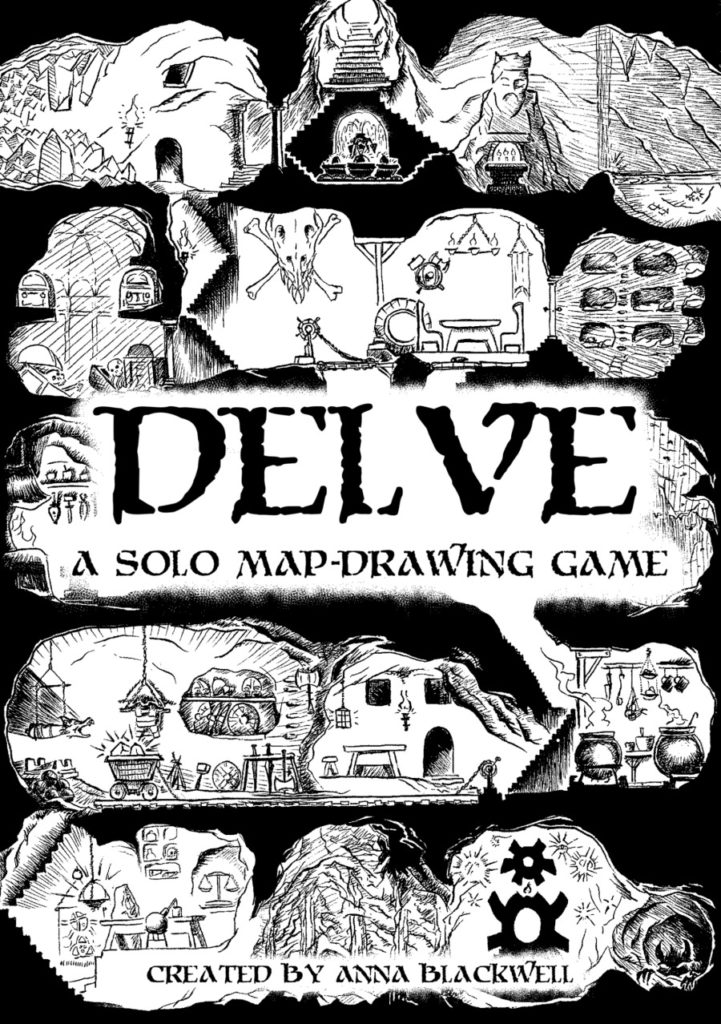
If you’ve ever played the classic video game Dwarf Fortress, you’ll have some idea of what Anna Blackwell’s DELVE is about. When starting a session you’ll find yourself in control of a newly claimed stronghold of dwarven folk and tasked with leading the underground city to either it’s ascending glory or ignoble demise.
During your time leading your people in growing their new settlement you’ll be challenged with floods of water, dangers of natural gasses and lava, as well as darker, more supernatural horrors deep underground that have been there for centuries.
More of an actual adventure game than some games on this list, DELVE sees you forming and leaving this dwarven hold, offers mechanics and tools for generating special dwarven artifacts and ancient dangers and monstrosities, and even be given the tools and structure for some lightweight tactical combat.
And, similar to Ex Novo, above, you’ll draw out your stronghold over the course of your session, walking away with more than just new stories and inspiration.
It’s not the most well suited for handling specific questions or issues within a story you’re writing, but the process of playing through DELVE is just freakin’ fun. Not every solo adventuring game that tasks you with challenges more akin to a traditional group-based tabletop roleplaying game gets it right, but DELVE is so smooth and enjoyable. I’ve gotten some great ideas for my tabletop campaign that I run and some interesting abstract ideas, creatures, and items that might one day make it into one of my writing projects.
I Am the Forest
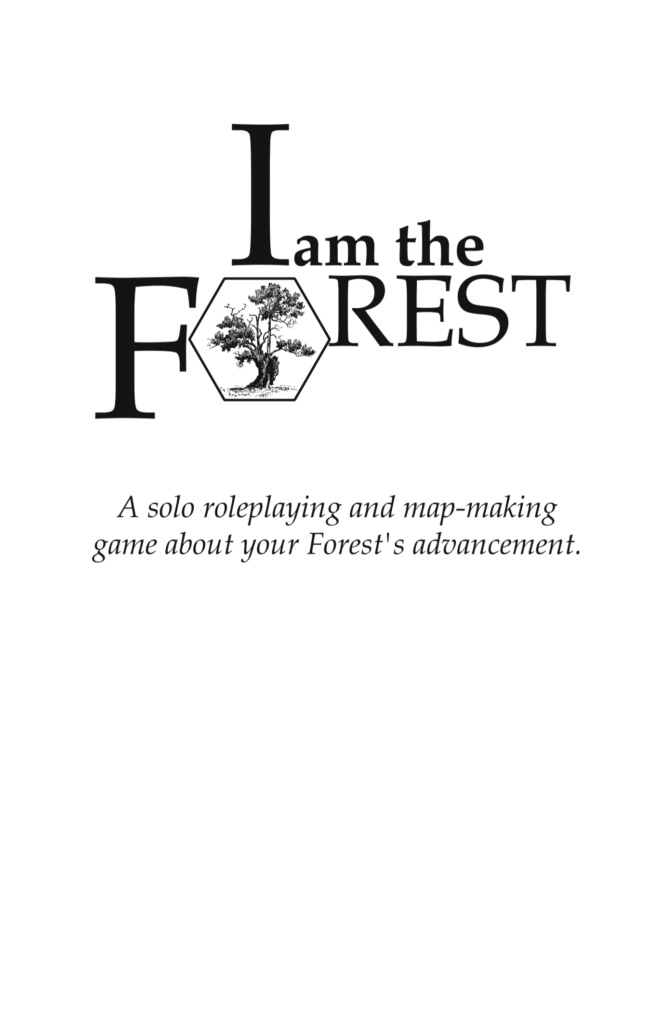
I Am the Forest by Seth A. Faerber is such a charming and fun game that is still in play testing, but I had to add it to my list. Rather than a discrete person, this game has you step into the role of an entire forest whose edges have begun to be intruded upon by a threatening civilization.
You’ll move through your session by creating your Forest and working to drive back your Enemy, an unknown encroaching civilization that destroys and desecrates your land. You’ll wield Forest Abilities to give yourself an edge over your Enemy and see how the conflict evolves over time.
And similar to Ex Novo and DELVE, above, the game has you draw a map of your domain and changes to it over time. You’ll have a really interesting an unique perspective on the location at large, and might just discover things lurking within the trees, just waiting to be discovered within your creative work.
I recently used I Am the Forest to get a wildly different perspective on a location in a writing project of mine. Where previously I kept looking at this growing town from the perspective of the people , which makes sense as that’s who we’re most often writing about, I instead looked at it from the perspective of the forest the town was taking land from. It really made me see some interesting aspects of the people and how they might be harming the land versus living with it.
The game about writing compelling, beautiful correspondence
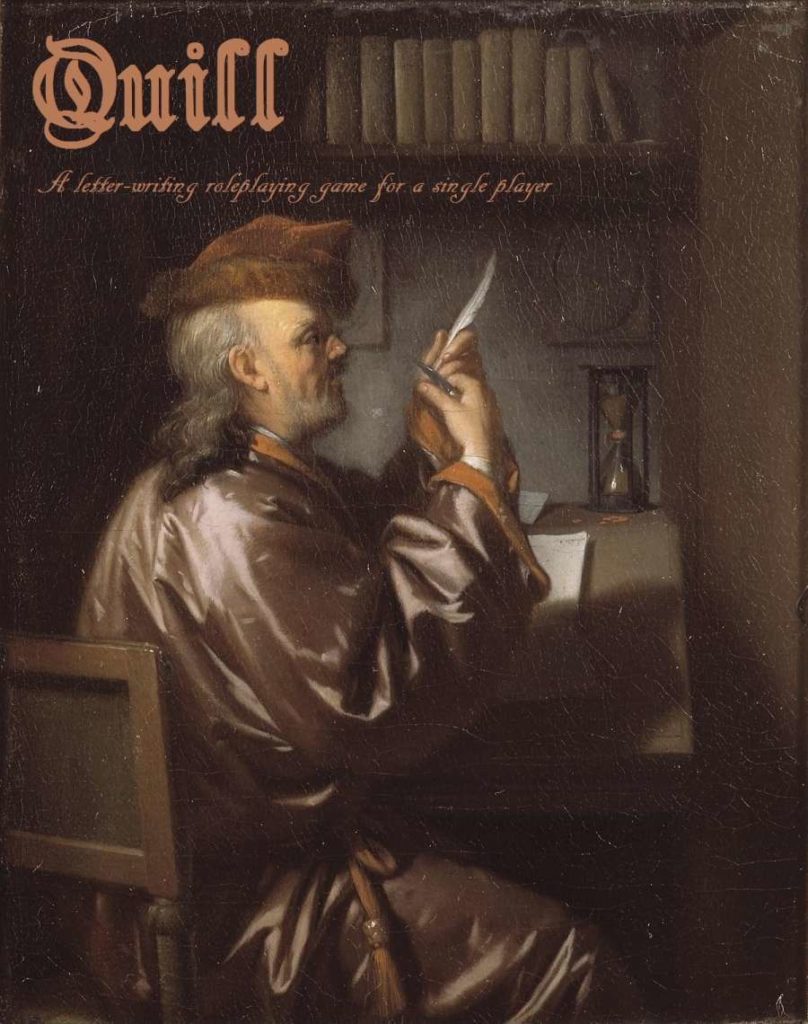
A truly interesting and unique game, Scott Malthouse’s Quill leaves the tabletop roleplaying game tropes of mighty wizards and powerful fighters behind and sits you at a desk to write.
I know, recommending a game about writing to writers? Groundbreaking.
Where traditional adventure games often have you assume the roll of a character with skills like strength and charisma who delve into dungeons in search of gold and glory, Quill has you roll dice to see how well wield Penmanship, Language and Heart as the skills you’ll use to write the best letters you can. Roll badly and you could find yourself writing a truly horrible bit of correspondence.
This game is so good for writers, and it offers some really amazing worldbuilding opportunities. You could assume the roll of a character within your world and actually write correspondence as them. Just imagine the perspective you’d get on their relationship with the recipient, the events in the world around them, and their own personality and motivations by inserting yourself into this activity!
A tool for generating and overcoming obstacles

Similar in some ways to Mythic and BOLD, above, Alex Yari’s Tilt is what folks refer to as an oracle , a tool that helps generate creative information and answers to questions in these kinds of games. In this case, it was created specifically to help those who are playing tabletop roleplaying games solo drive the action forward without having a game master to lead that process.
Tilt approaches this concept a little different from other oracles, aiming to help you generate obstacles within a story and then encourage creative problem solving to address those obstacles using the resources available to the characters in the action. It has a unique twist on the concept of helping answer yes or no questions (again, similar to Mythic) which will help inform and drive the action in your scene forward.
Oracles like Tilt are such good tools for writers to have on hand while they outline (or not, if you’re a pantser). You’ll have creative and often unexpected answers to the questions that you face, and Tilt can help you answer those questions and explore those scenarios with an eye towards doing so with the resources that the characters involved have available to them.
Solo Tabletop Games are Great for Writers!
Any one of the games in this list is such a good resource to try out if you’re a creative writer who wants a new tool to help generate new inspiration, gather new creativity, and solve some of the problems that you might face in your writing. They can usually help you to quickly and easily explore a situation in your creative work and ideate a variety of ideas for how scenes and situations might progress and evolve and put yourself in totally different perspectives within your setting that you might never have seen otherwise.
Next time you’re feeling challenged by your creative writing work and need some help getting inspired, give one of them a try!
6 thoughts on “ 12 Superb Solo Worldbuilding and Roleplaying Games for Writers ”
Frustrated Darren
I found it hard to get free games off of drive-thru even though they say you can get them they still ask for a credit card. When you just want to get a quick free download that’s not the place to go. It’s hard to navigate their pages. It should be easier to get a free game. They tell you that they have games for free for people that are financially hurting. But then when you go to try to download one it ask you for a credit card.
Luke Miller
That’s super weird, whenever I’ve purchased a free game (or put a value of 0 for a pay-what-you-want game), I’ve never been charged or asked for a card. It normally just bypasses the payment info screen, unless there are any games in the cart that are actually paid for. I’d reach out to DTRPG support if it continues to ask you for a card, that sounds like a bug to me.
Patrick Buechner
Hi Luke, this is a great list.
The latest issue of The Soloist (soloist.substack.com) is all about solo and co-op worldbuilding games. I included Journey as one of my top 5 games. Thanks for putting together a great book!
- Pingback: Unlocking Creative Potential: Solo Journaling TTRPGs for Writers
Hi, I don’t know if you’ve ever heard of Cartograph, but it’s also a wonderful solo journaling game where you adventure around a region as you draw the map. It was actually through the latest edition that I found out about Journey. Now I am solidly and happily down the rabbit hole of solo RPGs!
That’s so great! I have seen Cartograph though I’ve yet to play. I do LOVE the aspect of using dice rolled on a page to form the shapes of the map, a mechanic I’ve seen in a few games (recently I saw it in Stoneburner by Fari RPGs and it’s done in such a *chef’s kiss* way). Welcome to the solo RPG rabbit hole!
Comments are closed.
Join the Graycastle Press Mailing List
First Name*
Email Address*
Please leave this field empty.

- Online Ed & ISPs
- Science & Math
- Language Arts
- Unit Studies
- Learning Styles
- Environmental Ed
- Foreign Lang.
Create-a-Story – a Creative Writing Board Game for All Ages
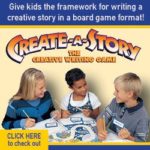
Published by: Create Press
- www.createpress.com
P.O. Box 2785 Carlsbad, CA 92018-2785 760-730-9550 $44.95 plus S&H
Online Teachers Manual available at website
Ages 5-99 (adult assistance is required for younger children) Can be up to 6 individuals or up to 6 groups of 2-4 players =========== By Joseph Grayhaim
Create Press has developed an ingenious approach to teaching creative writing and guiding students to work the imagination in an enjoyable and non-self-conscious way: A writing board game called Create-a-Story .
To begin my description at the end, a parent or teacher scores each written work at game’s end, following a scoring guideline in the instructions. For instance: “10 points if the story included the topic sentence; 5 points each for including good guys and bad guys in the story.” The winner is s/he with the most points, following the scoring scheme. But the point is made that every player is a winner, by virtue of having completed a story in the process of having fun.
Create-a-Story is played on a large, colorful game board composed of a path of squares that wends its way over the board. The squares are named for story elements, such as “Description”, “Dialogue”, “Setting”, “Plot” “Resolution” and other elements of story construction that correspond to decks of game cards divided by the same categories. There is also a pad of Outline Sheets and here is how these pieces come together:
- Each writer must choose a Topic Sentence card from the deck of such cards. This card must be used in the story, as close to the opening as possible and reasonable. (Remember, the player receives 10 points for using the Topic Sentence.)
- Beginning at “Start!”, each player rolls the die and moves along the game board as indicated. The player takes a story element card each time s/he lands on one, but only one Setting card. Play continues until all players have completed the board path and reached the ending or “Write!” By this time, each player must have at least 5 description cards; if not, s/he chooses from the deck until 5 have been taken.
- The writers take an Outline Sheet and fill in each section of the Outline from the element card information – Topic Sentence, Plot, Setting, Characters, Resolution, etc. There are a number of potentially conflicting elements, so the writer must choose the element most useful to the rest of the information. Therefore, the writing actually begins in the making of these choices, which ultimately provides a solid foundation in the writing process and making a habit of it.
- Once the Outline Sheets are completed, the writers begin to write their stories, filling in the necessary details from the Outlines. This process typically requires assistance and guidance from an adult – parent or teacher – as it is the true imaginative work . . . developing interesting story details from the element cards that have been collected randomly.
- The guiding adult will score the finished stories and then has the opportunity to review the story with each writer, discussing areas where more work will be helpful and how to make it so.
The fact that the game can be played with teams makes it valuable in practicing team work and group brainstorming, also.
Many writers of various forms use “Storyboards” to outline their stories. Create-a-Story provides insight into a similar process for young writers that can serve them throughout their lives. If, as an adult, one such student is someday required to present a lengthy speech, the habits of outlining and then filling in details, using colorful descriptions, having the presentation follow a logical flow . . . all of the skills developed while playing this fascinating game, will serve him/her well. Even attorneys who can present the facts of their case in a logical, clear, unfolding “storyline” will find success in their communications. The final utilitarian value of learning creative writing in this way is for the SAT essay section and other applications. Years of practice forming one’s thoughts into clear form and then putting them on paper will make such test-taking a breeze.
Create Press offers an Online Teachers Manual, another writing game and other excellent materials to help each child become comfortable with creative writing. J.G.
Share this:
Comments are closed.
Recent Posts
- Beautiful Learning Series – Cursive & Print Instruction Books
- Conspiracy on the Housatonic and The Great Emerson Art Heist
- Write At Home Online Courses for Homeschoolers in Middle & High School
- ABC Read Phonics-Based Program for Adults and Children
- Greek ‘n’ Stuff . . . Latin, Too – Buy Books Online
- November 2023
- November 2021
- February 2021
- January 2021
- December 2020
- October 2020
- January 2019
- February 2018
- January 2018
- December 2017
- November 2017
- October 2017
- August 2017
- February 2017
- January 2017
- January 2016
- November 2015
- January 2015
- November 2014
- August 2014
- 1775 Rebellion board game
- 1900s New York
- Academy Games
- Accredited Online High School
- ACT score improvement
- Acting as learning
- Acting resources
- Addition & Subtraction
- Adult Reading
- Advanced Math
- Affordable Homeschool Resources
- Alberti Veil
- Alene Harris
- alternative church
- Alternative Education
- American Academy
- American Christianity
- American families
- American Geography
- American History
- American Sign Language
- AP Chemistry
- Art Curriculum
- Audio Learning
- Auditory Learners
- Basket weaving kits
- Beginning Reading
- Bessie Bress
- Bible Education
- Bible memory builder
- Bible Study Resources
- Bible-based Education
- Biology Kits
- Board game creative writing
- Board Games
- Board games
- Board games that teach
- Botanical Drawing Academy
- Botanical Illustration
- Brain Development
- Brian Wasko
- British History
- Bullying resources
- by Emerson Sandow
- by Michael Leppert
- C ollege Prep
- Character Building
- Chemistry Kits
- Christian Biblical
- Christian books
- Christian College
- Christian curriculum
- Christian Education
- Christian homeschooling
- Christian literature
- Christian Students Science
- Christian teaching software
- Church at Home
- Church of God
- Classic Literature
- Classroom writing projects
- College Prep
- College Reading Aids
- Computer Reading Tools
- Computer Skills
- Computer Tools
- Computer-based games
- computer-based math programs
- Confidence building
- Continental Army
- Cool Tools Math
- Crafts at home
- Create Press
- Create-a-Story
- Creation Science
- creative composition
- Creative Writing
- Creative Writing Programs
- Critical Thinking
- Cultural Geography
- Daily Grams
- Dianne Knesek
- Digital books
- Downloadable Greek
- Dr. Aditya Nagrath
- Dr. Alvaro Arias
- Drawing & Painting
- Drawing curriculum
- Early literacy
- early reading
- Earth Science
- Earth Science Kits
- Easy Grammar review
- educational board games
- Educational games
- Educational toys
- Elementary acting
- elementary creative writing
- elementary math
- Elementary Math
- Elementary math program
- elementary math resources
- Elementary reading
- elementary science
- Elementary theatre
- Elephant Learning
- Emerson Sandow
- English History
- English Language Learners
- English usage
- English vocabulary
- English writing
- European countries
- European History
- Evelyn Fannin
- family activity
- family board games
- Family church
- family creative writing game
- Family Game Night
- Family Heritage
- Family History
- Family projects
- Farming Board Game
- Fiction writing
- followers of Jesus Christ
- Foreign Language
- Fred Coulter
- Free Bible resources
- Free Bible study resources
- Free Home Education Resources
- Free Homeschool Resources
- Free Resources
- Free Sample
- Free Sample Lessons
- Free Student Resources
- Free Teacher Resources
- Full Curriculum
- George Barna
- Grammar resource
- Greek and Latin study aids
- Greek study aids
- Greek word roots
- hand-eye coordination
- Handwriting
- HAP products
- Hebrew Reading
- High school creative writing
- High School Diploma
- High School English
- High School Graduation
- High School Math
- high school online
- High School Reading
- High School Reading Aids
- High School Science Kits
- High School Writing
- Highlighting
- Home Bible study
- Home church
- Home education math
- home education math products
- Home Education resources
- home school math
- home school math products
- home school programs
- Home-school
- Homeschool Art Program
- homeschool creative writing resources
- Homeschool English program
- Homeschool family
- Homeschool Grammar
- Homeschool History Resource
- homeschool math
- homeschool math material
- homeschool programs
- Homeschool reading
- Homeschool Resources
- Homeschool Travel
- Homeschooler
- Homeschoolers
- Homeschooling
- Homeschooling and College
- Homeschooling English program
- Homeschooling Family History
- homeschooling history
- Homeschooling math
- house churches
- Hugg-a-Planet
- Human Anatomy
- Immigration
- improve SAT scores
- Jesus is our mediator
- Jewish life
- K-8 math curriculum
- Kathleen Cotter
- Kindergarten
- King Arthur
- Latin word roots
- Lexington and Concord
- Life Science Kits
- Linda Silbert
- Logos Science
- Manipulatives
- Marine Biology
- Marvin Reynolds
- Math basics
- math concepts
- Math Online
- math program review by Emerson Sandow
- math program review by Michael Leppert
- Math Software
- math solutions
- Math Subscription Service
- math teacher
- Math teacher resources
- math teaching
- math teaching aids
- math turors
- Math videos
- Mathematics
- Matthew Blackwood
- mega-churches
- Memorization
- Memory Mark™ tool
- Memory Training
- Michael Leppert
- Michael Leppert review
- Middle School creative writing
- Middle School Math
- Middle School Reading
- Middle School Reading Aids
- Middle School Science Kits
- Mini church
- Montessori math
- Morningside Center
- Multiply & Divide
- Music Education
- Music History
- Music Instruction
- Music Practice Aids
- Music Practice Materials
- Music Teaching Materials
- musical learning
- Musical Theatre curriculum
- National Homeschool
- new kind of Christian
- New Rochelle
- On-line programs
- Online Education and Independent Study Programs
- Online high school
- Online high school math
- Online homeschooling
- Online learning
- Online Math Advanced
- Online math ages 2-12
- Online Math Games
- Online Program
- Online Teachers Manual
- Online writing curriculum
- organized religion
- Parent Teacher Resources
- Parents guidance
- Parts of Speech
- Pen and Ink
- Phonemic awareness
- Physics curriculum
- Physics Kits
- Political Geography
- Pre-Algebra
- Public Speaking
- Pumpkin Seed Press
- Quality Science
- Quitting Church
- Reading comprehension
- Reading for young children
- Reading foreign language
- Reading Games
- Reading Program
- Reading Review
- Reading Specialist
- Reading Success
- Reading Tools
- Recent brain research
- remedial math program
- Remedial Reading
- review by Joseph Grayhaim
- Review by Michael Leppert
- review of Create-a-Story
- Review of creative writing program
- Right Start Math
- Sarasota Art Schools
- SAT score improvement
- Science & Math
- Science curriculum
- Science drawing
- Science for Christian Students
- Science Kits
- Science products
- Science Review
- Scientific concepts
- scientific content
- Scientific Illustration
- Secular Homeschooling
- See-n-Spell™
- Self-confidence
- Self-discipline
- Sequential learning
- Sign Language
- soft plush world globe
- Spanish for kids
- Spanish Vocabulary
- Speech Pathologist
- Spelling Aid
- Stop Bullying
- Story elements
- Study Habits
- Tactile Learners
- Teacher Resources
- team building
- The Homeschool Review
- Theatre Arts
- Uncategorized
- Unit Study Curriculum
- United States history
- University of Denver
- Unlock Math
- Valerie Schuetta
- Visual Learning
- Vocabulary and Spelling Quick Reference Guide
- Vocabulary Development
- Voice lessons
- Wanda C Phillips
- Watercolor lessons
- We R Fun Games
- World Affairs
- world geography
- World Government
- World History
- World Peace
- Write At Home
- Writing curriculum
- Writing games
- www.californiahomeschoolingtoday.com
- www.churchathome.org
- www.classroomreviewsnow.com
- www.collegetranscriptsnow.com
- www.conceptuallearning.com
- www.easygrammar.com
- www.homeschoolmagazine.com
- www.homeschoolnewslink.com
- www.peacetoys.com
- www.tutoringforreading.com
- Young child literacy
Helpful Links
California Homeschooling Today Classroom Reviews College Transcripts Homeschool Magazines Choir21 Vegan Casa HomeschoolNewsLink Inspired Education Magazine Homeschooling Almanac
Review of the Week
- Review of the Week #1
Recent Reviews
Free almanac.
To receive a free copy of the Homeschool Almanac, send your snail mail address (kept confidential) to [email protected]
©2024 The Homeschool Review. All rights reserved. | Website by DiggsDesign
My Family Games
- board games
Unleash Your Creativity: Storytelling Board Games for Aspiring Writers

Introduction to Storytelling Board Games
Hey there, game lovers! Ever heard of storytelling board games? If not, you’re in for a treat! These games are not just about winning or losing; they’re about creating and sharing stories. Let’s dive in and learn more about them.
- Understanding the concept of storytelling board games
Storytelling board games are a special type of game where players create a story as part of the gameplay. They’re not just about rolling dice or moving pieces around a board. Instead, they challenge players to use their imagination and come up with exciting tales and adventures. Games like Dixit and Gloom are great examples of this genre.
- The role of creativity in board games
Now, you might be wondering, “What’s creativity got to do with board games?” Well, a lot! In storytelling games, creativity is the key. It’s all about thinking outside the box and coming up with a story that’s unique, interesting, and fun. The more creative you are, the better your story will be, and the more fun you’ll have!
- Benefits of board games for aspiring writers
Are you an aspiring writer? Then storytelling board games could be a great tool for you. They can help you practice your storytelling skills, develop your creativity, and even improve your ability to think quickly and adapt your story on the fly. Plus, they’re a lot of fun, which is always a bonus!
So, are you ready to dive into the world of storytelling board games? Let’s go on this exciting journey together!
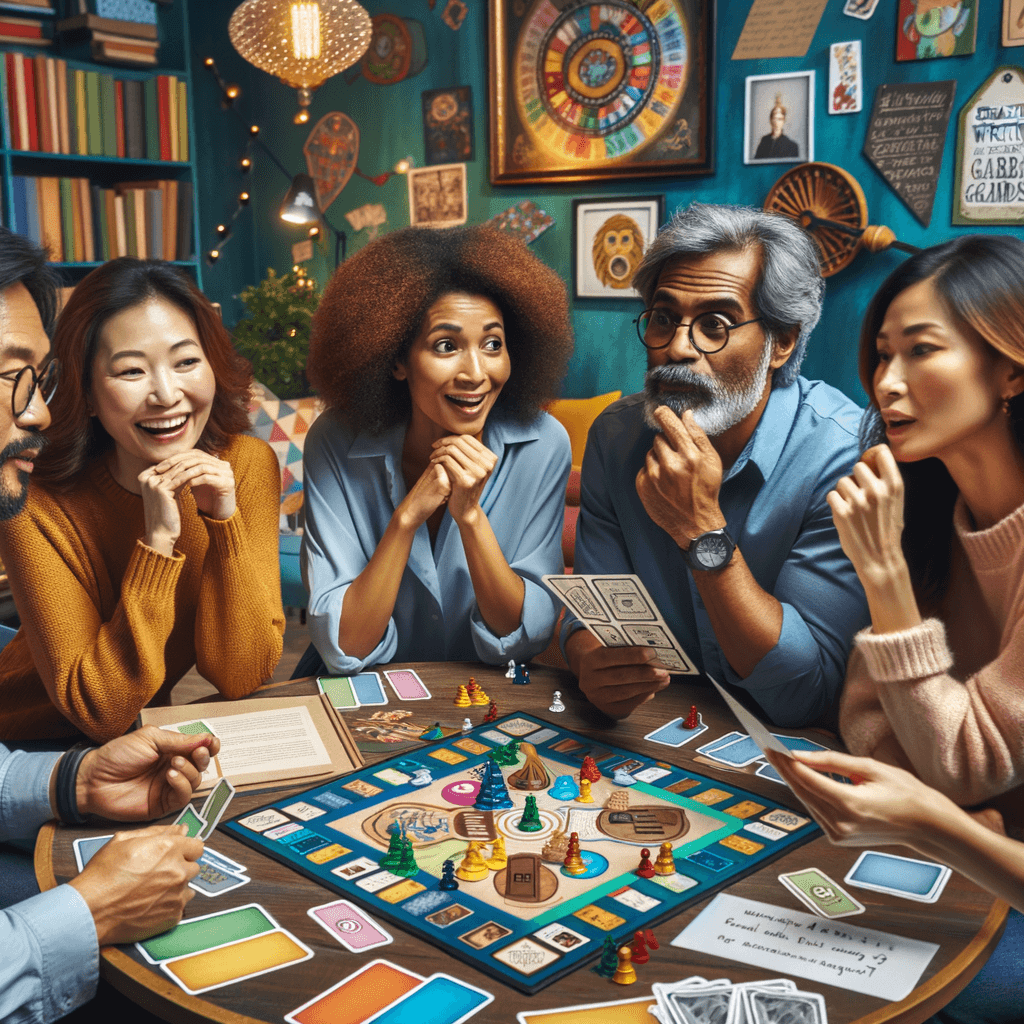
Top Storytelling Board Games for Aspiring Writers
Let’s dive into some of the best storytelling board games that can help you become a better writer. These games are not only super fun to play, but they also help improve your writing skills. Let’s take a look!
- Game 1: Once Upon A Time Once Upon A Time is a card game where players create a story together using cards that describe important story elements like characters, events, and items. The game helps you think on your feet and come up with creative story ideas. It’s a great way to practice creating a compelling narrative, which is a key skill for any writer.
- Game 2: Dixit Dixit is a card game where players use beautifully illustrated cards to tell a story. The catch is, the story has to be vague enough that not everyone can guess the card, but clear enough that at least one person can. This game helps you learn how to balance detail and ambiguity in your writing, making your stories more engaging and thought-provoking.
- Game 3: Gloom Gloom is a unique storytelling game where your goal is to make your characters suffer the most before they pass away. It’s a bit dark, but it’s also a lot of fun! This game encourages you to think outside the box and explore different story themes and ideas. It’s a great way to stretch your creative muscles and improve your writing skills.
So, there you have it! Three awesome storytelling board games that can help you become a better writer. Give them a try and see how they can enhance your writing skills.
How Storytelling Games Enhance Creativity
Ever wondered how a simple game of storytelling could boost your creativity? Well, you’re in for a treat! Storytelling games are not just a fun way to pass the time, they also have some cool benefits for your creative mind. Let’s dive in and see how these games can make you a more creative person!
- Improving Narrative Skills
First off, storytelling games are a fantastic way to improve your narrative skills. When you’re playing, you’re not just telling a story, you’re creating a whole world in your mind. This helps you to think about how stories are structured and what makes a story interesting. Plus, it’s a great way to practice your storytelling skills in a fun and relaxed environment. According to a Wikipedia article , storytelling can help improve children’s oral language skills and stimulate their imagination.
- Enhancing Character Development
Next up, storytelling games can help you to develop your characters. When you’re playing, you’re not just creating a story, you’re creating characters with their own personalities, backgrounds, and motivations. This can help you to think about what makes a character interesting and relatable. And the best part? You get to step into the shoes of your characters and see the world from their perspective!
- Boosting Imaginative Thinking
Finally, storytelling games can boost your imaginative thinking. When you’re playing, you’re not just telling a story, you’re creating a whole new world. This can help you to think outside the box and come up with new and exciting ideas. Plus, it’s a great way to let your imagination run wild and explore all the possibilities. So, next time you’re feeling stuck in a creative rut, why not try a storytelling game?
In conclusion, storytelling games are a fun and effective way to enhance your creativity. They can help you to improve your narrative skills, develop your characters, and boost your imaginative thinking. So, why not give it a try? You might just find that you’re a storytelling genius!
Case Study: The Impact of Storytelling Games on Aspiring Writers
Let’s dive into some real-life examples of how storytelling games can help budding writers. We’ll look at two case studies that show how these games can boost creativity and storytelling skills.
- Case Study 1: Impact on Writing Style and Creativity
Meet Sarah, a 12-year-old aspiring writer. She loved to write, but her stories were often flat and lacked creativity. Then, she started playing a storytelling game called “Story Cubes”.
After playing the game for a few weeks, Sarah’s writing began to change. Her stories became more imaginative and colorful. She started using more descriptive words and her characters became more lively and interesting. Her writing style became more varied and creative.
According to Sarah, “Story Cubes helped me think outside the box. I learned to create stories from different perspectives and this made my writing more interesting.”
So, as we can see, storytelling games like Story Cubes can have a big impact on a young writer’s creativity and writing style.
- Case Study 2: Improvement in Storytelling Abilities
Next, let’s look at John, a 10-year-old boy who struggled with storytelling. He found it hard to come up with interesting plots and his stories often lacked structure. Then, he started playing “Once Upon a Time”, a storytelling board game .
After a few weeks of playing the game, John’s storytelling abilities improved significantly. His stories became more structured and engaging. He learned how to create interesting plots and how to build suspense and excitement in his stories.
John’s teacher noticed the improvement and commented, “John’s stories have become much more engaging and well-structured. He has really improved his storytelling abilities.”
So, as John’s case shows, storytelling games can help young writers improve their storytelling abilities and write more engaging stories.
In conclusion, storytelling games can have a big impact on aspiring writers. They can help improve creativity, writing style, and storytelling abilities. So, if you’re an aspiring writer or if you know one, consider giving these games a try!
Storytelling Games for Adults
Storytelling games aren’t just for kids. Adults can have a blast while boosting their creativity too! Here are two of the best storytelling games that adults can enjoy while enhancing their creative thinking.
- Game 1: Gloom
Gloom is a unique storytelling game where you control the fate of an eccentric family of misfits. Your goal is to make your characters suffer the greatest tragedies possible before passing on to the well-deserved respite of death.
How does Gloom enhance creative thinking? Well, each card in the deck has a unique story prompt. You’ll need to weave these prompts into a coherent and compelling narrative. This game encourages you to think outside the box and create stories that are both entertaining and tragic.
- Game 2: Once Upon a Time
Once Upon a Time is a card game where players create a story together using cards that depict typical elements from fairy tales. One player is the Storyteller, and creates a story using the ingredients on their cards. The other players try to use their own cards to interrupt the Storyteller and become the new Storyteller.
Once Upon a Time enhances creative thinking by challenging players to adapt their story to new elements as they are introduced. This game is all about thinking on your feet and being able to incorporate new ideas into your narrative on the fly.
So, whether you’re a seasoned writer or just someone looking for a fun way to boost your creativity, these storytelling games for adults are sure to provide hours of entertainment and mental stimulation.
How to Choose the Right Creative Writing Board Game
Choosing the right creative writing board game can be a bit tricky, but don’t worry, we’ve got you covered! Here are some tips to help you make the best choice:
- Understanding your writing style
First things first, you need to understand your writing style. Are you a fan of fantasy, mystery, or maybe sci-fi? Do you like to write long, detailed stories or short, snappy ones? Knowing your style will help you choose a game that matches your interests. For example, if you love mystery, you might enjoy a game like Clue that involves solving a crime.
- Identifying your creative challenges
Next, think about what you find challenging in writing. Maybe you struggle with creating interesting characters, or perhaps your plots need a little spice. Once you’ve identified your challenges, look for a game that can help you overcome them. For instance, a game like Dixit can help you think more creatively about storytelling.
- Considering the game’s complexity and theme
Finally, consider the game’s complexity and theme. If you’re new to creative writing, you might want to start with a simpler game. On the other hand, if you’re an experienced writer, a more complex game might be more stimulating. Also, make sure the game’s theme appeals to you. After all, you’ll be spending a lot of time playing it!
Remember, the best game for you is the one that you enjoy the most and that helps you grow as a writer. So, take your time, explore different options, and most importantly, have fun!
Conclusion: The Power of Board Games in Boosting Creativity
As we wrap up our exploration of storytelling board games, let’s take a moment to reflect on the power these games hold in fostering creativity. Not only are they a source of fun and entertainment, but they also serve as a tool for aspiring writers to hone their skills.
- Recap of the benefits of storytelling board games
Storytelling board games offer numerous benefits. They stimulate imagination, encourage creative thinking, and help players develop their storytelling skills. Games like Dixit and Gloom have shown how they can transform a simple game night into a creative writing session. They provide a safe space for players to experiment with different narratives, characters, and plot twists, all while having fun.
- Final thoughts on the impact of these games on aspiring writers
For aspiring writers, storytelling board games can be a game-changer. They offer an interactive and engaging way to practice storytelling, character development, and plot creation. They also foster a sense of competition, pushing players to think outside the box and come up with unique, compelling stories. In our case study, we saw how these games had a positive impact on aspiring writers, helping them overcome writer’s block and sparking their creativity.
In conclusion, storytelling board games are more than just a pastime. They are a powerful tool that can boost creativity and help aspiring writers hone their craft. So next time you’re stuck in a writing rut or just looking for a fun way to spend the evening, consider picking up a storytelling board game . You never know, it might just be the creative spark you need!
Hi, It's Jack Here
On my blog, I am eager to recount my experiences, offer tips, and provide recommendations. Whether you’re a seasoned player or just venturing into the captivating world of board games, my insights are designed to guide, entertain, and perhaps reignite a passion for this cherished pastime.
Recent Posts

Cracking the Case: A Journey Through Detective Board Games

Spellbinding Encounters: The Magic of Fantasy Board Games

Global Board Games: A Fun Journey into Cultural Diversity
Sign up for our newsletter.
Only fun stuff, I swear :)
Subscribe to our newsletter
The Inspired Treehouse
Growing healthy bodies and minds through play!
10 Board Games to Turn into Handwriting Games
September 29, 2017 By Claire Heffron
Turn these awesome board games into handwriting games to increase interest and entice reluctant writers!
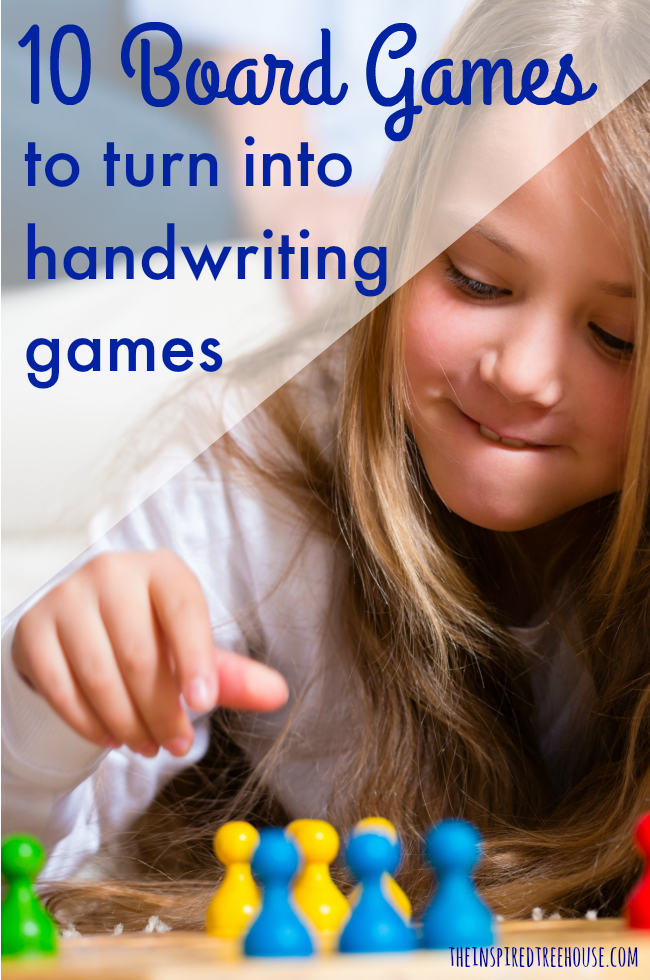
*This post contains affiliate links. Read more .
We all know kids who hate handwriting with a passion. The minute those pencils and paper come out, you start to hear the murmurs, groans, and complaints.
Some kids hate handwriting because they’re fidgety or have difficulty focusing on the task and staying in their seats. Others struggle with using a functional pencil grasp and may fatigue easily or even experience pain in their hands/fingers because of the way they hold their pencils. And still others just can’t seem to execute the visual perceptual and visual motor components of handwriting, including sizing, spacing and alignment .
No doubt about it, handwriting can be tough for a lot of kids and it’s one of the most common reasons for referrals to occupational therapy in the school setting.
The good news is that there are plenty of ways to make handwriting a little more fun and interesting for even the most reluctant writer. One of my favorites? Board games!
These 10 board games (and card games) are the perfect way to keep kids actively engaged in handwriting tasks – trust me, they’re way more fun than that boring old worksheet! Most of these ideas are great for kids who are currently working on writing letters and/or writing at the word level.
If you’re searching for other ways to make handwriting practice even more fun – check out some of the best writing tools that will get kids excited about handwriting!
Tips for Using Board Games as Writing Games
1 || try carrying games over between multiple sessions..
Using board games as handwriting games typically makes the game take a bit longer than it normally would. Rather than rushing, try making note of where you left off and then pick up the same game again across multiple sessions.
2 || Silent play can make things more fun and increase opportunities for writing.
Making a rule that there is no talking during the game is a great way to get kids’ attention – they love doing familiar tasks in a different, more interesting way! And when kids aren’t allowed to talk, it means that they have to write their answers or write things down to communicate. It’s a win-win!
3 || Assign a scorekeeper!
Younger, less experienced, or struggling writers may need a different role during these games. Can they act as scorekeeper – writing down all of the players’ names and keeping track of points?
4 || Use turn-taking to your advantage.
While one person is taking his turn, the person who went before him can be writing her word/answer. This way, game play is continuous and the whole group is never waiting for one person to write.
5 || Use games as an opportunity to trial adapted handwriting paper and grips.
Game play can be a low-pressure way to try out different types of lined paper and to see which pencil grip works best for which kid.
Board Games That Make Awesome Handwriting Games
1 || Scatergories
This is one of my favorites for slightly older kids and is an awesome game because it targets speech and language concepts like divergent naming in addition to handwriting, as kids have to make a lists of objects that fall in various categories. The added challenge? All of the objects have to begin with a certain letter! Make it a handwriting game: There is no real adaptation needed to make Scategories into a handwriting game, as kids are already writing their answers down. Sub out the lined answer sheets that come with the game to use adapted paper as needed.
2 || Spot it
Another one of our favorites in therapy and at home. Spot it targets visual perceptual skills and can be easily made into a handwriting game too. Each card in the deck has eight different symbols on it, with the symbols varying in size between cards. Any two cards will have exactly one symbol in common.
The game cards are placed upside down and the top 2 cards are revealed. Whoever spots the symbol in common on both cards first, gets the first card. Then another card is revealed for players to search, and so on. Make it a handwriting game: Make it a “silent” game! Instead of shouting out the answer, kids have to write down the word for the picture they find on both cards!
3 || Zingo Word Builder
This a great game for new and emerging readers. Kids love sliding the “Zinger” to get the letter tiles to pop out and then they use the tiles to fill in the blanks to create simple words. There is a whole line of Zingo games for kids of different ages and abilities! Make it a handwriting game: This one’s easy – simply have kids write their words on their paper after they build them!
4 || Guess Who?
An old classic! Kids have to narrow down a field of cartoon faces by asking each other questions like, “Does your character have glasses?” or “Does your character have brown hair?” Make it a handwriting game: If another player says “yes” to a question, the other player has to write down that character trait. This way, each child is making a list of traits the character has and can check their remaining characters to see if they fit all of the descriptions on their list!
5 || Scrabble Junior
The kids version of the old classic, Scrabble Junior is awesome for new readers and kids who are learning to put letters together to write words! Bonus – the game board has two sides, one for beginners and one for more advanced players. Make it a handwriting game: Another easy one – simply have kids write the word they formed on the game board after each turn!
6 || HedBanz
In this fun game, kids place cards (without peeking!) and place them in their adjustable headbands, facing the other game players. Then, each player asks yes or no questions to the group to try to figure out what is on their card. Make it a handwriting game: Similar to Guess Who, to make HedBanz into some handwriting fun, have kids write down the clues they find out from other players as they ask questions about their own card. For example, if they ask the group “is my card an animal?” and the group answers “no”, the child would write down – “Not an animal”. Then, the child can use his paper to remember the clues each time he takes a turn.
7 || Charades or Reverse Charades
Everyone knows how to play charades – you can play with or without the charades game cards available here . But have you ever tried Reverse Charades? This game is tons of fun, because instead of one person acting something out for the group, the group acts something out together for one person. It’s a new, hilarious twist on an old favorite! Make it a handwriting game: Make it a silent game! That’s right – no talking! So if you’re playing regular charades, kids can’t call out their guesses – they have to write them down and show the person who is acting out the clue to see if they’re right! Same for reverse charades – have the person who is guessing the clue write down their answers instead of calling them out!
8 || Don’t Say It
This is another great team building game. On each card, there is a base word and four words that you can’t say to describe the base word. Each child draws a card and tries to get their team to say the word using other descriptions and related words without ever saying the four other words on the card. Make it a handwriting game: Make a rule that the team can’t call out their guesses – they have to write them down!
9 || 5 Second Rule
For this game, a child picks a card, reads the topic, and then starts the 5 second timer. With only 5 seconds, can they name 3 things that fit the topic? Make it a handwriting game: You’ll need to add some time to the clock to make this into a handwriting game. Challenge kids to write their 3 answers instead of calling them out. Decrease the length of time for more of a challenge or add more time to the clock to make it a little easier. Change how many items they have to write down in the category as needed.
10 || Blurt
Kids listen to a definition and then race to respond with the answer. For example, “what word means ‘a partially dried grape’”? Kids try to be the first to shout out “raisin!” Make it a handwriting game: Have kids write their answer after hearing the definition instead of calling it out.
Looking for other awesome ideas for encouraging reluctant writers ? Check these out from The OT Toolbox!

- Latest Posts
Claire Heffron
Latest posts by claire heffron ( see all ).
- The Best Obstacle Course Equipment - June 3, 2024
- Scavenger Hunt Ideas for Kids - May 21, 2024
- The Best Backyard Toys for Kids - May 21, 2024
[…] 10 Board Games to Turn into Handwriting Games […]
Privacy Overview
| Cookie | Duration | Description |
|---|---|---|
| cookielawinfo-checkbox-advertisement | 1 year | Set by the GDPR Cookie Consent plugin, this cookie records the user consent for the cookies in the "Advertisement" category. |
| cookielawinfo-checkbox-analytics | 11 months | This cookie is set by GDPR Cookie Consent plugin. The cookie is used to store the user consent for the cookies in the category "Analytics". |
| cookielawinfo-checkbox-functional | 11 months | The cookie is set by GDPR cookie consent to record the user consent for the cookies in the category "Functional". |
| cookielawinfo-checkbox-necessary | 11 months | This cookie is set by GDPR Cookie Consent plugin. The cookies is used to store the user consent for the cookies in the category "Necessary". |
| cookielawinfo-checkbox-others | 11 months | This cookie is set by GDPR Cookie Consent plugin. The cookie is used to store the user consent for the cookies in the category "Other. |
| cookielawinfo-checkbox-performance | 11 months | This cookie is set by GDPR Cookie Consent plugin. The cookie is used to store the user consent for the cookies in the category "Performance". |
| CookieLawInfoConsent | 1 year | CookieYes sets this cookie to record the default button state of the corresponding category and the status of CCPA. It works only in coordination with the primary cookie. |
| gdpr-auditId | 1 year 24 days | Liveramp sets this cookie to operate the Consent Management platform. |
| gdpr-dau-log-sent | 1 day | Liveramp sets this cookie to operate the Consent Management platform. |
| viewed_cookie_policy | 11 months | The cookie is set by the GDPR Cookie Consent plugin and is used to store whether or not user has consented to the use of cookies. It does not store any personal data. |
| Cookie | Duration | Description |
|---|---|---|
| __cf_bm | 30 minutes | Cloudflare set the cookie to support Cloudflare Bot Management. |
| _hjAbsoluteSessionInProgress | 30 minutes | Hotjar sets this cookie to detect a user's first pageview session, which is a True/False flag set by the cookie. |
| S | 1 hour | Used by Yahoo to provide ads, content or analytics. |
| Cookie | Duration | Description |
|---|---|---|
| _ga | 1 year 1 month 4 days | Google Analytics sets this cookie to calculate visitor, session and campaign data and track site usage for the site's analytics report. The cookie stores information anonymously and assigns a randomly generated number to recognise unique visitors. |
| _ga_* | 1 year 1 month 4 days | Google Analytics sets this cookie to store and count page views. |
| _gat_UA-* | 1 minute | Google Analytics sets this cookie for user behaviour tracking.n |
| _gid | 1 day | Google Analytics sets this cookie to store information on how visitors use a website while also creating an analytics report of the website's performance. Some of the collected data includes the number of visitors, their source, and the pages they visit anonymously. |
| _hjFirstSeen | 30 minutes | Hotjar sets this cookie to identify a new user’s first session. It stores the true/false value, indicating whether it was the first time Hotjar saw this user. |
| _hjSession_* | 30 minutes | Hotjar sets this cookie to ensure data from subsequent visits to the same site is attributed to the same user ID, which persists in the Hotjar User ID, which is unique to that site. |
| _hjSessionUser_* | 1 year | Hotjar sets this cookie to ensure data from subsequent visits to the same site is attributed to the same user ID, which persists in the Hotjar User ID, which is unique to that site. |
| CONSENT | 2 years | YouTube sets this cookie via embedded YouTube videos and registers anonymous statistical data. |
| last_pys_landing_page | 7 days | PixelYourSite plugin sets this cookie to manages the analytical services. |
| last_pysTrafficSource | 7 days | PixelYourSite plugin sets this cookie to manage the analytical services. |
| pys_first_visit | 7 days | PixelYourSite plugin sets this cookie to manage the analytical services. |
| pys_landing_page | 7 days | PixelYourSite plugin sets this cookie to manages the analytical services. |
| pys_session_limit | 1 hour | PixelYourSite plugin sets this cookie to manage the analytical services. |
| pys_start_session | session | PixelYourSite plugin sets this cookie to manage the analytical services. |
| pysTrafficSource | 7 days | PixelYourSite plugin sets this cookie to manage the analytical services. |
| vuid | 1 year 1 month 4 days | Vimeo installs this cookie to collect tracking information by setting a unique ID to embed videos on the website. |
| Cookie | Duration | Description |
|---|---|---|
| _pin_unauth | 1 year | Pinterest set this cookie to group actions for users who cannot be identified. |
| ad-id | 6 months 12 days | Amazon Adsystem sets this cookie as part of its affiliate marketing programme. |
| centerVisitorId | 1 year 1 month 4 days | Center sets this cookie to track the individual sessions on the website, which is data used for lead generation as a part of marketing purposes. |
| ckid | never | Adara yield sets this cookie to deliver advertisements tailored to user interests on other websites and track transactions |
| NID | 6 months | Google sets the cookie for advertising purposes; to limit the number of times the user sees an ad, to unwanted mute ads, and to measure the effectiveness of ads. |
| test_cookie | 15 minutes | doubleclick.net sets this cookie to determine if the user's browser supports cookies. |
| VISITOR_INFO1_LIVE | 5 months 27 days | YouTube sets this cookie to measure bandwidth, determining whether the user gets the new or old player interface. |
| YSC | session | Youtube sets this cookie to track the views of embedded videos on Youtube pages. |
| yt-remote-connected-devices | never | YouTube sets this cookie to store the user's video preferences using embedded YouTube videos. |
| yt-remote-device-id | never | YouTube sets this cookie to store the user's video preferences using embedded YouTube videos. |
| yt.innertube::nextId | never | YouTube sets this cookie to register a unique ID to store data on what videos from YouTube the user has seen. |
| yt.innertube::requests | never | YouTube sets this cookie to register a unique ID to store data on what videos from YouTube the user has seen. |
| Cookie | Duration | Description |
|---|---|---|
| __adblocker | 5 minutes | No description available. |
| _hjIncludedInSessionSample_3481366 | 2 minutes | Description is currently not available. |
| ar_debug | 1 year | Description is currently not available. |
| COMPASS | 1 hour | Description is currently not available. |
| is_eu | never | No description available. |
| pbid | 5 months 27 days | Description is currently not available. |
| view.fM4GHk4odih4L4GAeXQ29N.uzHzXkjJqmrDWpuEKVrEhV | 1 day | Description is currently not available. |
| VISITOR_PRIVACY_METADATA | 5 months 27 days | Description is currently not available. |
| w3tc_referrer | session | Description is currently not available. |
Pin It on Pinterest
Creative Board Games: Unleashing Imagination on Your Game Nights
At PlayWise, we believe in the liberating power of games for the imagination. But what happens when creativity specifically becomes the focus of a board game? Welcome to the world of creative board games. Let’s explore why we love them and what are the most important titles in this category?

Máté Lencse
Educator, game designer,
founder of PlayWise
Why listen to him?
Máté has been regularly playing modern board games and classic abstract board games since 2013. He plays because he loves to. He plays because as an educator, it is his most important motivational and developmental tool. He plays because as a father, it is one of the highest quality times spent with his daughter. He plays because it adds to his marriage. He plays because this is how he can best connect with many of his friends. He plays to get to know games and as a game designer, to be able to create new ones. Thus, it's not surprising that he often plays through 15-20 games weekly. Learn more about him and his background on his author page or follow him on social media:
What is a Creative Board Game?
A creative board game is not merely about winning or losing. I particularly like seeing how, for example, players do not tally up their points in Dixit because the focus shifts elsewhere. Creative board games revolve around storytelling, imagination, and stepping out of conventional frameworks. These games often offer open-ended gameplay , allowing players to create, imagine, and choose their own paths. We build civilizations; we craft stories.
Benefits of Creative Board Games
Creative board games are tremendously developmental, whether you consider cognitive or emotional skills. They encourage players to think critically , solve problems , and adapt to changing game dynamics. This not only strengthens cognitive flexibility but also fosters skills such as empathy , negotiation , and collaboration . Furthermore, creativity is often linked to the arts, which can be somewhat intimidating because it is synonymously used with talent. However, these games are excellent at bringing out the inherent creativity in everyone.
Examples of Creative Board Games
You're probably eager to try these games out, but where to start? Here are some popular creative board games:
Dixit : This game tests your ability to think creatively and interpret others' ideas.
Mice and Mystics : It’s a game where players are turned into mice and must navigate through a castle's many dangers.
Betrayal at House on the Hill : This game offers a new spooky storyline every time you play.
Each of these games stimulates creativity in unique ways, offering a departure from traditional point-scoring or race-to-the-finish board games.
Who are Creative Board Games For?
Creative board games are not just for children. Like board games in general, they target a wide audience—from children and teenagers to adults. Games like Rory's Story Cubes are great for children—though I've seen adults playing it too—while The Extraordinaires Design Studio is excellent for teenagers. Adults can enjoy Pandemic Legacy: Season 1 , which requires complex decision-making and strategy. But these are just a few examples; the point is that everyone can find their own game within the creative category.
How to Choose a Creative Board Game
When selecting a creative board game, consider your interests , who you'll be playing with, and the skills you want to develop. Look for games that align with the themes or narratives you enjoy, and consider the game's complexity and length. And dare to experiment. Games that require creativity often take you on unusual paths , but that's the essence of their appeal, and it can be greatly rewarding for all players. It’s fair to feel that playing such games presents a greater challenge, often taking you far out of your comfort zone, but it’s worth it. Really.
Creative Board Games in Education
The benefits of creative board games are not limited to home use. Educators are increasingly using these games to foster creativity and promote active learning. Games such as Snake Oil and Once Upon a Time have made their way into classrooms, helping to teach various subjects in an engaging way. Here, it is especially important to let the board games do their work. There's no need to generate educational situations; the goal is to create play situations, engage with the creative games, and let the board game handle the rest.
The Future of Creative Board Games
The trend towards creative board games shows no sign of slowing down. As board game design continues to evolve, we can expect to see an increase in games that break traditional molds and offer unique and imaginative experiences .
So, whether you're a seasoned gamer looking for a new challenge or just want to unlock your creativity, there's a creative board game out there waiting for you!
Spread the Fun of Learning!
Love our content? Show your support by sharing our page with your friends and help us inspire more families and educators with the joy of learning through play! Your shares truly make a difference. Thank you for being a wonderful part of our community!

Note from Máté
I believe that board gaming in itself is a creative activity, as even abstract games invite us into a world operating under a set of rules different from reality, which we then need to manage collectively during play. What is this if not a task requiring creativity? Imagining that I am actually running my economy, imagining that the meeple there is me, imagining the stakes of a battle. To me, this also includes the ability to delve into others' thoughts, set traps, and continuously analyze situations. This is precisely the key to using board games for educational purposes : skills develop unnoticed. Creativity is one such area.
Most Popular Creative Board Games
Betrayal at house on the hill.
Players explore a haunted mansion, encountering creepy phenomena and omens until one player turns traitor, leading to a climactic showdown.
Recommended for ages 12 and up, 60 min, 3-6 players
The game comes with multiple room tiles, character tokens, and cards.
It stimulates strategic thinking, cooperative play, and narrative reasoning.
Instructions
Players take turns moving through the haunted house, revealing new rooms and encountering events, items, and omens. When a certain number of omens have been revealed, a 'haunt' begins and one player usually becomes a traitor. The exact rules for the haunt vary based on which of the 50+ scenarios is triggered.

Players have to guess a concept (which could be anything from 'dinosaur' to 'Eiffel Tower') based on a series of icons.
Recommended for ages 10 and up, 40 min, 4-12 players
The game includes a large game board with various icons and cubes to mark these icons.
Encourages non-verbal communication, logical thinking, and creativity.
The active player chooses a concept, then places cubes on the icons that best represent that concept. The other players guess what the concept could be, based on the icons chosen.

Dixit is a card game that invites players to rely on their intuition and imagination to guess which card one player, the storyteller, is describing.
Recommended for ages 8 and up, 30 min, 3-8 players
Dixit includes a deck of 84 unique, beautifully illustrated cards, a game board, six wooden rabbit tokens as player markers, and 36 voting tokens in six different colors.
Dixit develops creativity, abstract thinking, and social interaction skills as players interpret and guess the story behind the images.
In Dixit, one player is the storyteller for the turn and makes up a sentence or phrase that might describe one of their cards. Then, each player selects a card from their own hand that they feel best matches the storyteller's description, and after shuffling and revealing the cards, all players except the storyteller vote on which card they believe belongs to the storyteller.

Mice and Mystics
Players, transformed into mice, go on a whimsical adventure through a castle full of dangers.
Recommended for ages 7 and up, 60-90 min, 1-4 players
Game includes mouse figurines, cards, tiles, and a storybook.
Enhances problem-solving, teamwork, and storytelling abilities.
Players choose a chapter from the storybook and try to complete it as a team. Each turn, players can move, explore, battle, and make story decisions, which will affect the outcome of the game.

Once Upon A Time
A card game where players become storytellers, competing to weave a tale that includes all their cards.
Recommended for ages 8 and up, 30 min, 2-6 players
The game includes story cards and ending cards.
Enhances creative thinking, storytelling, and language skills.
Players start with a hand of story cards and one ending card. The first storyteller begins the tale and continues telling it, playing cards from their hand to match the elements they introduce. Other players can interrupt and take over the story if they have a card that matches a story element just mentioned.

Pandemic Legacy: Season 1
A cooperative board game where players work together to prevent global pandemics.
Recommended for ages 6 and up, 20 min, 1-12 players
The game includes a board, cards, and tokens, with additional elements revealed as the game progresses.
It fosters strategic thinking, cooperation, and problem-solving skills.
Players take on roles such as scientist or medic, and work together to travel the world, treating diseases and finding cures. The game changes over time, with new rules and components introduced.

A classic drawing game where players have to guess what their team-mate is trying to draw.
Recommended for ages 12 and up, 90 min, 3-16 players
The game includes a game board, word cards, a timer, and drawing tools.
Enhances creative thinking, non-verbal communication, and teamwork.
Players move around the game board by guessing correctly what their team mates are trying to draw within a time limit. The first team to reach the end of the board wins.

Rory's Story Cubes
Players roll dice with different images and weave a story based on the results.
The game includes nine dice, each with different images on the faces.
It enhances imagination, storytelling, and lateral thinking.
Players roll the dice and must tell a story that connects all of the images shown.

Players invent unique products and sell them to all sorts of quirky customers.
Recommended for ages 10 and up, 20-30 min, 3-10 players
The game includes word cards and customer cards.
Encourages creativity, persuasive speaking, and entrepreneurship.
Each player takes turns being the 'customer' while the other players combine two word cards from their hand to create a product and then 'sell' it to the customer. The customer then decides which product they liked best, and that 'salesperson' gets a point.

A word game where players earn points by constructing words from individual lettered tiles onto a game board.
Recommended for ages 13 and up, 90 min, 2-4 players
The game includes a game board, letter tiles, and tile racks.
Encourages vocabulary expansion, spelling accuracy, and strategic thinking.
Each player draws a set of tiles and tries to form words on the board, crossword-style, during their turn. Points are awarded based on the letters used and where they are placed on the board.

Sherlock Holmes Consulting Detective
Players work together to solve intricate cases by following leads and piecing together clues.
Recommended for ages 13 and up, 60-120 min, 1-8 players
The game includes case booklets, newspapers, and a map of Victorian London.
Encourages problem-solving, logic, and cooperative play.
Players choose a case and start reading the introduction. They then decide where to follow leads, consulting the case booklet, newspapers, and map to gather information and piece together the solution.

Abszolút képtelen sztorik (Hanna Győri - Máté Lencse, 2022)
In 2022, I also designed a creative board game. Its title could be translated as " Absolutely Improbable Stories " It's a story-writing game. We defined eight story elements (character, twist, setting, object, etc.) and the title. Each story card contains 9 instructions. Each round, everyone writes a sentence based on their own card, and then we vote on which sentence should be included in our collective story. The elements are written in a random order, so there are games where we start with a setting, sometimes the hero appears right away, or we give a title even though we don't know what our story will be about yet.
Two important aspects of the game design stand out to me. First, the game values (scores) voting for a good sentence just as much as writing a good sentence. So, not only players with great writing flair can win the game, but also those who have a good sense of public taste. The other point I would highlight is that in this game, you can vote for yourself. I think this is a missing skill. We find it hard to admit and proclaim when we do something well. However, the game mechanics are structured such that if I write a bad sentence and vote for myself, it’s a mistake because my sentence won’t be included, nor will I score points for voting for a good sentence. I usually laugh a lot during the game, for example, when we have to incorporate a handsome garbage man into a sci-fi story set on an alien planet. The game requires solving incredible improbabilities, which demands considerable creativity.

Frequently Asked Questions
What is a creative board game, what are some popular creative board games, how can creative board games enhance cognitive skills, can adults play creative board games, where can i buy creative board games.

Best Board Games to Get Inspiration and Improve Writing Skills
By: Author Contributor
Categories The More You Know , 2 Player Board Games , Board Games , Cooperative Board Games , Round-Ups

Board games can carry so much wisdom and inspiration . Such games can indeed help you improve analytical and strategic skills along with logic, communication, and teamwork. However, there is also one more thing it can teach us.
Board games are perfect tools for developing creativity and improving writing skills. Indeed, some games can show us how to enhance our writing abilities while playing. Here are a few examples of such games.
Arkham Horror

This cooperative game is everything a player needs to immerse themselves fully in the world. The game can last 2 to 5 hours, depending on the plot and the number of players. During this time, players will travel across the world multiple times. They will witness unusual and paranormal events, fight monsters, chat with strangers and make all kinds of discoveries in their attempt to save the world.
The game put a strong emphasis on the plot, character building, and settings. Each character’s move is the result of a plot twist or new events on the map. With every unpredictable event, we learn more about the new world and our character’s skills and abilities. So, the longer you are playing, the more engaged you are in the game.
Such a board game is everything an aspiring writer can wish for in a hobby. First, the events of this game are inspired by H.P Lovecraft novels. Thus, these books give structure and a sense of literary horror to the game. Secondly, players need a good imagination and the ability to immerse themselves in fictional words to play this game well. Hence, young writers get to practice those skills while also observing and participating in the masterpiece that is Arkham Horror .

Spirit Island

Spirit Island is a game to convince you of the existence and beauty of magic. This game is set on virgin islands untouched by civilization. Unfortunately, it will soon have to change since the first conquerors approach its borders. Players take on the roles of the spirits on the islands. Each spirit guards specific areas of the island, like water or forests. Your goal as a spirit is not to let the conquerors win and take over the island.
This game is one of the highest-ranked board games on the market right now. A big reason why it’s so popular is the plot idea and its execution. We engage in the fight between the natural powers and colonial empires, trying to protect our land and the people on it from invaders.
Is it worth your time? Absolutely! Does it inspire you to think of similar events that actually took place in the past? Most certainly.
It’s a fun, beautiful, and exciting game to play with your friends while pondering how life would be if magic could protect our land from invaders. In fact, it can even inspire you to read some of the speedy paper reviews and order a paper on colonization from professional academic writers.

Twilight Struggle

It’s the peak of the Cold War . The West and the Soviets are fighting to establish dominance. Two players will determine the destiny of the world. In their hands are all the powers they can build to spread their influence to the most distant corners of the political arena.
It’s one of those games that can be played for hours and still be captivating and engaging. It teaches you to think two steps ahead while also keeping your finger on the pulse of the action.
Sure, Twilight Struggle is an older game yet, it’s still one of the top-selling games and is still high in demand on the market. That alone tells a lot about the quality of the game.
So what can young, aspiring writers learn from that game? Well, pretty much everything. It will teach writers to think strategically and analyze each potential scenario when drafting a plot development. It accurately shows how one decision can change the course of the game. Not to mention, it has perfectly written game mechanisms, cooperation of multiple elements on the map, and a warfare atmosphere.
Overall, this game will tell you how the Cold War began and where it leads. It’s also a perfect game for students to learn more about that odd, fascinating, and terrifying period in our recent history. Even students who usually say, “I’d rather pay someone to do my homework on history than do it myself,” would be in love with this gameplay.

Wrapping up
Board games can be much more than a simple pastime activity. They can teach, inspire, and motivate us to create. Each board game is a whole new world to explore. You can learn from it and learn based on it. Hopefully, these three games will show you how diverse, beautiful, and creative board games can be. So choose your game and have fun!
- GET STARTED
- ENTER CLASS CODE
Gamify creative writing.
Storiumedu is a collaborative writing game for youth that builds skill and lasting confidence., start transforming your students into motivated writers., virtual playing cards unlock creativity..
Gameplay revolves around digital “story cards” that represent different aspects of storytelling and character development. Along with vivid art , these cards serve as writing prompts, helping students figure out what to write next at each step of the game and overcoming the dreaded “writer‘s block.”
Characters give students a personal stake.
Each student creates and controls their own unique character . This helps them care about the story that they’re writing and builds strong, lasting motivation and engagement. Characters grow and evolve as the students play and write, just like in a real story.
Students write amazing original stories, together.
Students take turns playing story cards and adding to the story. Paragraph by paragraph, they collaboratively write their own original story simply by playing the game. StoriumEDU’s simple rules motivate even the most reluctant young writers and keep the story moving forward.
Supercharged tools help you encourage young writers.
StoriumEDU tracks your students’ writing speed and progress, giving you insights both into who is excelling and who needs additional attention. Teachers can monitor all student writing, provide feedback, and request revisions.
Endless stories, endless educational uses.
StoriumEDU is a ”Swiss army knife” that supports an impressively wide range of educational goals. You can use story cards and curricular content from our growing library , created by teachers just like you. You can also easily create your own cards to support your own unique classroom needs.
Start your free trial and unlock your students’ creativity.
of teachers say StoriumEDU noticeably improves student motivation.
of teachers would recommend StoriumEDU to a colleague.
of students say StoriumEDU is more fun than traditional writing assignments.
160 million
words already written, just by playing a game!
Testimonials
“The National Writing Project is enthusiastic about StoriumEDU‘s potential for educational impact and the importance of its underlying innovation in improving the state of writing instruction.”
“StoriumEDU empowers teachers to craft rich, creative, rewarding experiences for their students that help them find their unique writing voice. It made my school year!”
“I would recommend StoriumEDU to any creative-minded teacher interested in engaging students in storytelling and collaborative writing. It's an excellent platform to help students creatively explore any number of writing skills.”
“StoriumEDU is unlike any other writing product I have seen. It offers students unique opportunities for learning, fun, and self-discovery, in a way that is manageable, assessable, and enjoyable for teachers to implement.”
Billed annually, or $15 if month-to-month.
Regular price: $10/mo billed annually, or $15/mo if billed month-to-month. Offer expires 9/30.
- Unlimited play, for every student you teach.
- Easy classroom rostering
- Create and share original storyworlds
- Analyze student writing via our analytics dashboard
Ask us for a quote!
- Multiple teachers and classrooms
- Google Classroom integration
- School/district analytics
- Discount volume pricing
- Keep your kids creatively active and socially engaged at home
- Play with siblings and friends over the Internet
Designed and tested with students of all ages. Appropriate for late elementary, junior high, and high school students.
Requirements
Web-based, with nothing to install! Works on Chromebooks, laptops, desktops, tablets, and smartphones.
Designed for COPPA and FERPA. No personal student information collected or shared. The teacher is always in control.
Want to know more?
Download our brochure
Read the detailed FAQ
Meet our team
Team | Blog | Press | Contact us
© Copyright 2022 Protagonist Labs, Inc.

Creative writing inspired by board games
by NikkiYoungAuthor | Feb 27, 2020
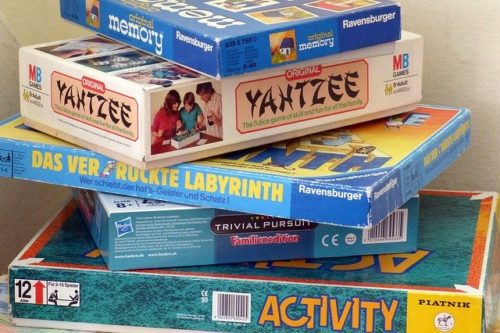
On a rainy day there is nothing better than to wipe the dust off a few board games and start playing them.
However, what if you could incorporate these exciting games into your writing?

That’s just what one of our Young Writers did and here she is to explain for herself just what that means…
I first got the idea when I read the story, ‘Death by Scrabble’ by Charlie Fish. This hilarious, but dark, story is based on the game, Scrabble and is one of my favourites.
What am I on about? Well, all you have to do is think about your favourite board or card game and write a story about either someone playing that game, OR, you could add a twist, such as like Charlie Fish’s story.
You could also write about someone who has fallen into a game! (like Jumanji).
I had a go at this and it was actually really fun. It certainly got me writing and I based my story on the game, Operation. Here it is:
Mike lowers his tweezers into the ankle. I hold my breath. He slowly takes the broken bone out. I release my breath with a frustrated hiss as Mike sighs with relief and drops the bone into his pile. He leans back on his chair, satisfied. With his hard stare bearing down on me, beads of sweat start to form on my forehead and slowly roll down my face. I reach into the incision in the brain and try to take the ice cream out. Suddenly I shudder, the pressure getting to me, and my tweezers hit the boundary. An electric shock shoots up my arm. Slamming the tweezers down onto the table, I put my head in my hands, angry that I couldn’t do it. I couldn’t save his life. He was going to have to have that brain freeze forever now and it was all my fault.
I look up at Mike. His side of the table laden with the wish bone, Adam’s Apple, butterfly, water bucket and pencil. And I look down in front of me, a mere broken heart and a bread basket. Mike grunts with happiness. I cannot take it anymore. I grab the body and whack Mike on the head with it. He falls to the ground. I laugh as I take all of the pieces from his side and add it to my collection. The broken heart and bread basket does not look so lonely anymore.
So yeah! I hope you liked that. As you can tell you can get pretty creative with this piece. Have fun.
Do you fancy having a go at this creative writing exercise? Let us know if you do.
Submit a Comment Cancel reply
Your email address will not be published. Required fields are marked *
Submit Comment
Recent Posts
- How to encourage your children to read more
- Writing Club for Teens and Tweens
- 11+ Revision and Story Writing
- 5 ways to get kids writing for fun
- Descriptive writing in easy steps
Search this blog
Categories on this blog.
Privacy Policy
Nikki Young
- Misogyny is rife on social media
- Is it time for a smartphone detox?
- Attainment Scores at Primary Level
13 Creative Writing Games For Kids To Nurture Their Imagination

Writing is such an important part of your child’s development and education . Of course, you probably already remember how important essay writing was during testing time when you were in school. That hasn’t changed. When you also consider all the poorly written work emails you get in a day, it makes it even easier to understand how dire it is for kids to learn to communicate effectively when they write. There’s more to writing than just school work and business communication, though. Journaling is an excellent way to teach kids to explore their feelings. Creative writing is also wildly important for kiddos as it nurtures their imagination .
How do you encourage a child to write? It’s not always easy, but making it fun can certainly help.
1. Telephone Pictionary
There’s actually a board game , called Scribblish , that follows this same concept. However, you can play the game without shelling out money. Start by having your child write down a secret sentence. Maybe it’s a short quote from a Disney movie or just something they’re feeling. Next, they’ll pass it to a friend or sibling and that player will try to draw what the sentence says. They’ll fold over or tear off the original sentence. When it gets to the next person, they’ll try to translate the drawing into a sentence. This can follow as many steps as you want. In the end, it’s just like playing telephone and super fun to see how convoluted things got from the original message.
2. Personalized Card Messages
Getting ready to send that Amazon gift card to your brother in another state? Set down your child and ask them to write a letter to their uncle. If they’re stuck, make gentle suggestions by asking them about their favorite memory with their uncle or reminding them of the last present he sent.
3. Start a Journal
The traditional way of doing this is to just buy your sweetie a fun new journal and some cool pens. Then let them decide what to write inside. You could also make it a journal you share — a safe place for them to tell you their feelings and secrets or ask you questions they might be embarrassed to ask out loud. You could even write shared stories by taking turns filling a page each night.
4. Popcorn Storytelling
Remember popcorn reading in class? Think of this like that. You can start a story with a sentence or two, then pass it on to one of your children. Whether they take two minutes to write out the next part of the story or just tell you what happens next, they’re still “writing” and creating something new. After two minutes, it’s someone else’s turn.
5. Secret Storytime
Similar to popcorn writing, but with a bit more structure. Start with a piece of paper and have the first kiddo write down the name of a person or character, then fold it over and pass it along. The next kid will name another person, fold it, again, and pass it on. Keep passing until each of the following questions are answered:
Where did they go? What did they do? What did they say? How did it end? The last player unfolds the paper and uses the answers to tell the story.
6. Mad Libs
Mad Libs have been around for decades and are still pretty popular. Now only is it a fun storytelling adventure, it’s also a chance to each your kids grammar and sentence structure. Start by working your way through a couple books. Next, make up your own Mad Lib for your children to fill in and, eventually, encourage them to make one for you.
7. Vocab Challenge
You can use your children’s vocabulary words from school or have your own set of words at home. Help them learn a fun new word each morning and then ask them to come up with a sentence that uses that word. For older kids, ask them to take all their sentences from the week and use them (and new sentences) to create a story.
8. Screen time, School time
It’s summer. You don’t want everything they learned to go to waste. But, you also don’t have a brain full of activities to fill the two months’ worth of days they’re off. There’s nothing wrong with a bit of screen time. However, if you’re feeling guilty, making it a “learning opportunity.” “You can watch Moana, but then you have to write five sentences about it.” As they get older, challenge them with more specific questions to answer. “What did she learn?” “Why was her grandma so important to her journey?” You get the idea.
9. Grocery Time
This isn’t exactly a game but, with enough enthusiasm from you, it might seem like one. Ask your kiddo to help write out the grocery list. This could be as imaginative as asking them what they’d like to buy or as useful as helping them write out and spell the things you actually need to get. Bonus: Including them in your meal planning and grocery buying might actually mean less dinner table stubbornness. Maybe.
10. Caption Contest
Make copies of funny family pictures and put them in a scrapbook. Let your kids have fun writing the captions for each picture.
11. Guess Who!
Remember the game of Guess Who where you had to use descriptors to eliminate people until you accurately guessed who the other person was? A simple twist on this game is to show your kids different pictures of people or characters they know, then ask them to write out five sentences that describe their person. Afterwards, they’ll take turn reading their descriptions to one another and guessing who they got.
12. Dialogue Writing
This can go multiple directions. You could print off a comic strip with no dialogue and ask your children to decide what happens and what is said. You could even print out completely blank comic strips and let them write or draw their own comics. Another option, though, is to simply say, “What do you think so and so would talk about while out to dinner?” This could be something like Mickey and Minnie or even Grandma and Dad. Start simple, but mix things up as they get better about it. “What would you talk about while stuck in traffic with your music teacher?” “What do you think I would say to the President?”
13. Invest In Story Cubes
There are so many iterations of story cubes and so many ways to play! The basic concept is simple, though: Little cubes that you roll like dice and help get your brain working.
Related: There’s A Way For Schools To Do Homework That Doesn’t Suck
This article was originally published on Jan. 29, 2020
- Writing Activities
18+ Creative Writing Activities To Make Writing Fun
Make writing less boring with these 12 fun creative writing activities for kids.
When most children think of writing, they think of lined paper with thousands of words written on it, line by line with the occasional spacing for paragraphs. But writing doesn’t need to be that boring and gloomy. Today we bring you12 creative writing activities to make writing fun and colourful!
How to Make Writing Fun
It is important to show your kids that there’s more to writing than just homework and long essays. Writing can be fun and it doesn’t always involve writing thousands of words in a formal structure. It’s time to stop worrying about sentence structure, grammar and spelling mistakes. Instead, encourage your kids to explore their creativity and write down their thoughts as they come in any format they like. Here are 12 fun creative writing activities that will boost your child’s creativity, imagination and encourage them to write for fun.
18+ Fun Creative Writing Activities
Use story maps.
Story maps are a great way to unleash your child’s imagination. You can either create your own or print out one of these free story map templates . To create your own story map, you’ll first need a location. This could be anywhere, a planet , an island , the woods or even your hometown. Don’t worry, you don’t actually need to leave your home to enjoy this activity.
Next draw out a simple map of the location. The map must have a starting point and an endpoint. Here is an example of our treasure island story map:
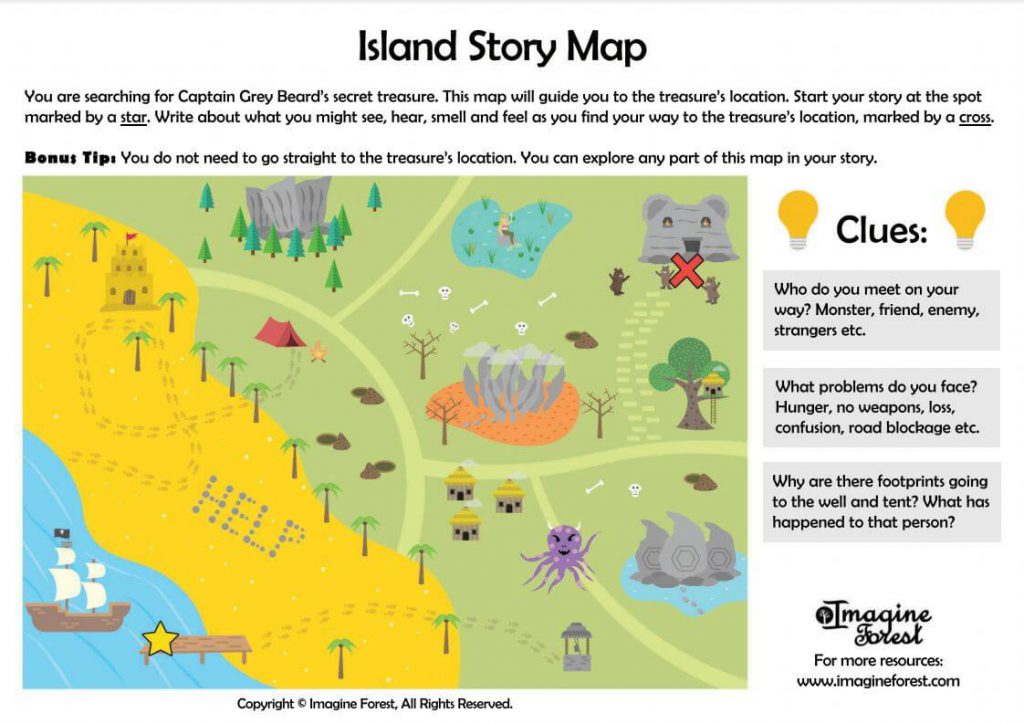
You can see that we marked the starting point with a star. And the end point with a red cross. Once this is done, you need to put loads of obstacles, challenges and interesting things on the map for your child to explore and engage with in their imagination. This could be a giant octopus monster, a lava lake, a cunning princess or even some secret symbols or lettering.
Once you have completed creating your action-packed story map (or printed out one of our free templates) – It’s time for the real adventure to begin. Give the map to your child and together you can pretend that you have landed in a whole new location.
Start from your bedroom (or your imaginary pirate ship) and make your way through the obstacles to find the secret treasure located in a mysterious cave (or the shed in your backyard). As you go through the map, think about the characters you might encounter, items you might find and even challenges you could face.
After your little adventure, your child will be inspired and ready to write about the adventure they just experienced! Go ahead and check out these free story map templates to get you started:
- Forest Story Map
- Island Story map
Create Some Paper Finger Puppets
Puppets and toys are a great way to stimulate imaginative play. In particular, creating your own paper finger puppets is a brilliant creative activity to boost your child’s imagination and make story-telling more fun. When creating your own finger puppets, your child can create any character they like. If they love football , try creating some famous football players, and if they love Harry Potter , get them to create some wizard themed characters. Whatever your child’s interest, combine it with story-telling, and make storytime extra fun.
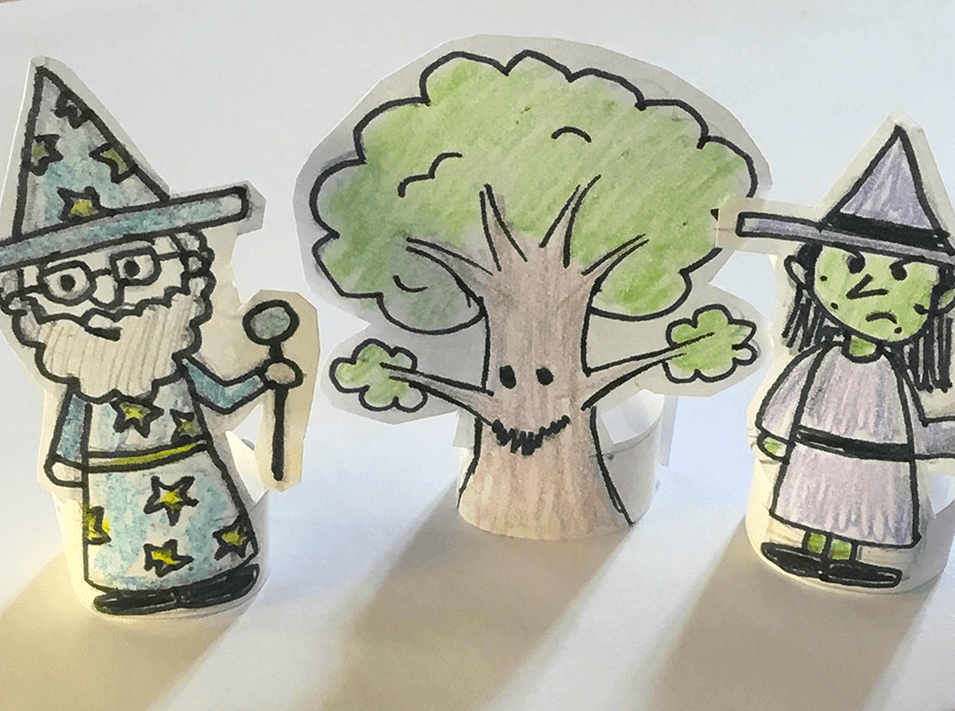
To get you started, you can download our free paper finger puppet templates by signing up to Imagine Forest:
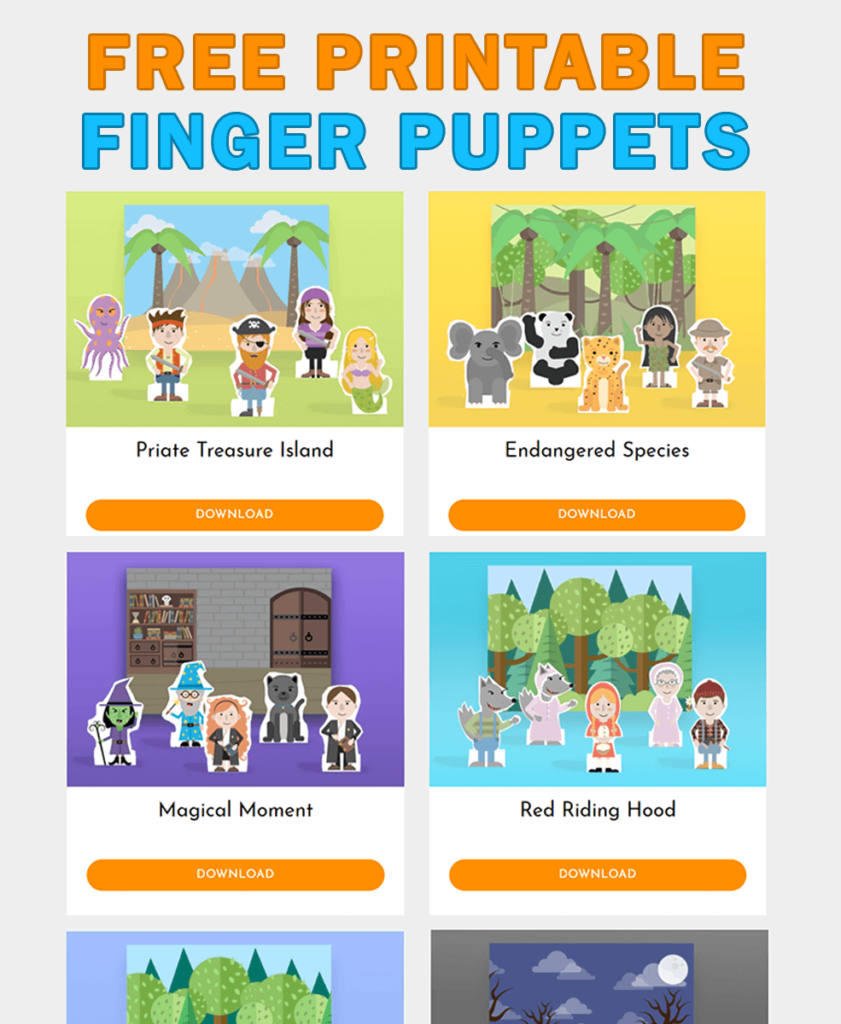
Create your own paper characters, props and background. Then let the role-playing begin!
Would You Rather Game
Kids love playing games. The Would You Rather game is a great way to boost logical thinking and communication skills. Print out our free Would You Rather game cards pack, to get a mix of funny, gross and Disney themed questions. Then get at least three players in a team to begin the game. The purpose of the game is to convince the whole team that your answer to the question is the best one and to get other players to agree with you. This game is guaranteed to get your kids laughing and thinking logically about the answers they pick.
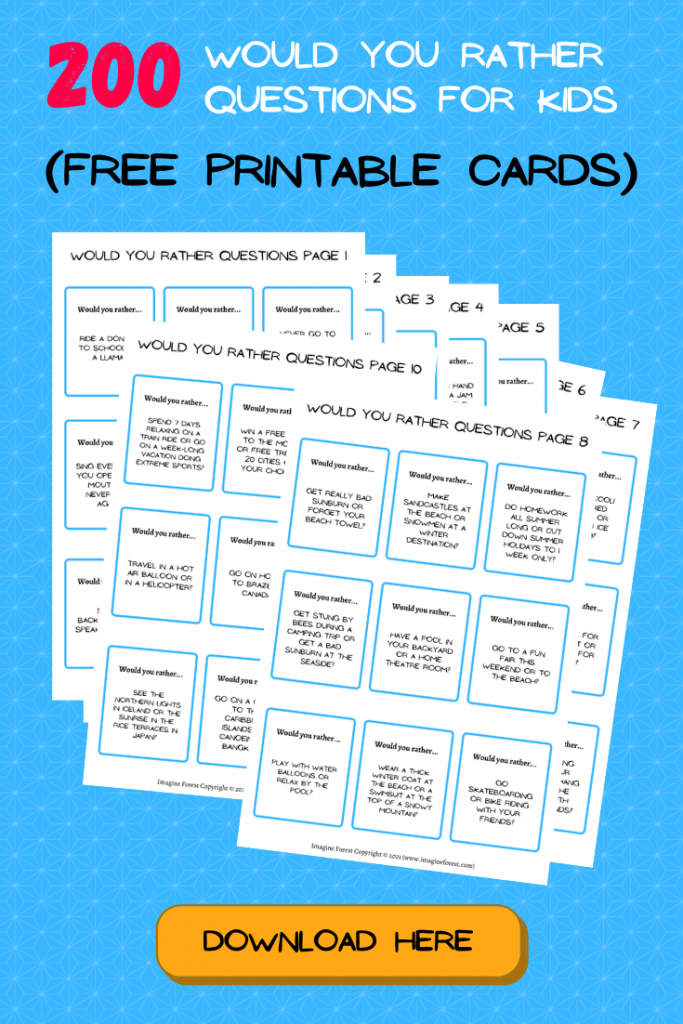
Telephone Pictionary Game
Another brilliant creative writing activity is the Telephone Pictionary Game . The basic idea behind this game is to write a story collaboratively with your team using drawings and phrases. Together as team members take turns to write/draw something down. They’ll be improving skills such as creativity, teamwork and communication skills. And when the game is over, they’ll have a really funny story to read!

Create Some Shape Poetry
Poetry is a quick and short writing activity to get kids engaged in creative writing. But writing a typical haiku or limerick can get boring over time. To add a little more excitement gets your kids to write poems in the shape of something. For example, your child could write a poem about cats , in the shape of a cat:
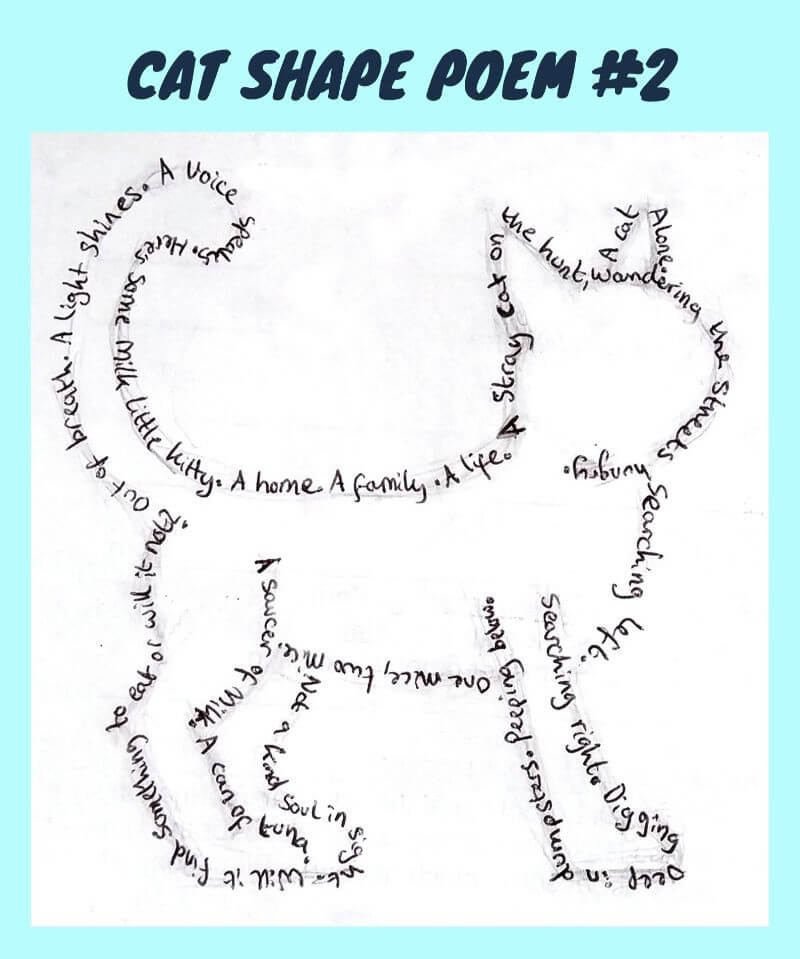
Not only are these poems great to read, but they also make wonderful pieces of artwork. For more inspirations, check out our Alice in Wonderland inspired shape poetry .
Finish The Story Game
The finish the story game is the simplest creative writing activity in our list. In a team of at least 2 players, each player takes turns completing a story. Start off with a random story starter and then each player takes turns to continue this story. Which way will the story go? No-one knows. And that’s the real beauty of this game. Let your child explore their imagination and come up with wild ideas to keep the story interesting. And by the end of the game, you’ll have a really unique and funny story to read.
Use Image Prompts
Image prompts are a great source of inspiration. And can be used in a number of ways to encourage your child to write. For instance, you can ask your child to write a quick snappy slogan for a random image or photograph. Alternatively, you could play a whole game centred around a single image, such as the Round Robin Tournament game explained in our post on storytelling games using image prompts .
Story Cubes To Inspire
Inspiration is key in making writing fun for kids. That’s where story cubes come in handy. You either buy ready-made story cubes or make your own story cubes at home. If you’re interested in making your own story cubes, check out these 9 free story cube templates for ideas. Once you have a bunch of story cubes, you can simply roll them like dice and then challenge your kids to write a story based on the images they get. For game ideas using story cubes, check out this post on how to use story cubes .
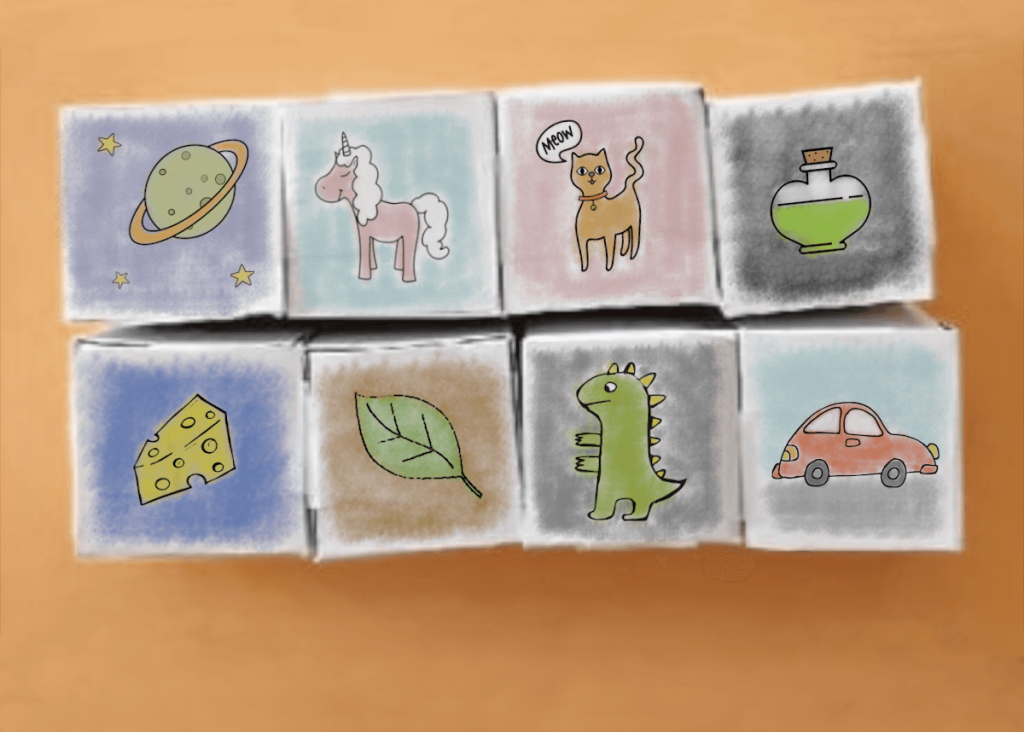
Create A Comic Strip
If your kids hate writing but love drawing, then comic strips are a great creative activity to sneak in some minor writing with huge levels of imagination. Pick a topic, any topic you like. This could be related to your child’s interest and then ask them to create a short comic strip about that topic. For example, if you child loves dinosaurs, ask them to create their own comic strip about dinosaurs. For more inspiration and ideas, check out this post on how to create your own comic strip and comic books at home.
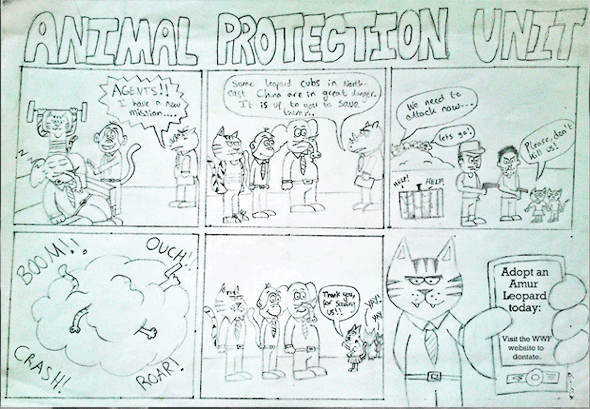
Make Your Own Pop-up Book
Another fun way to get your kids to write more is by creating your own pop-book books. Pop-up books seem really complicated to create, but in reality, they are really easy to make at home. All you need is some paper, scissors and glue. Check out this super easy tutorial on how to create your own pop-book at home for quick step-by-step instructions. Similar to comic strips, pop-up books are a great way of combining drawing with writing to get your kids writing more in a quick and fun way.
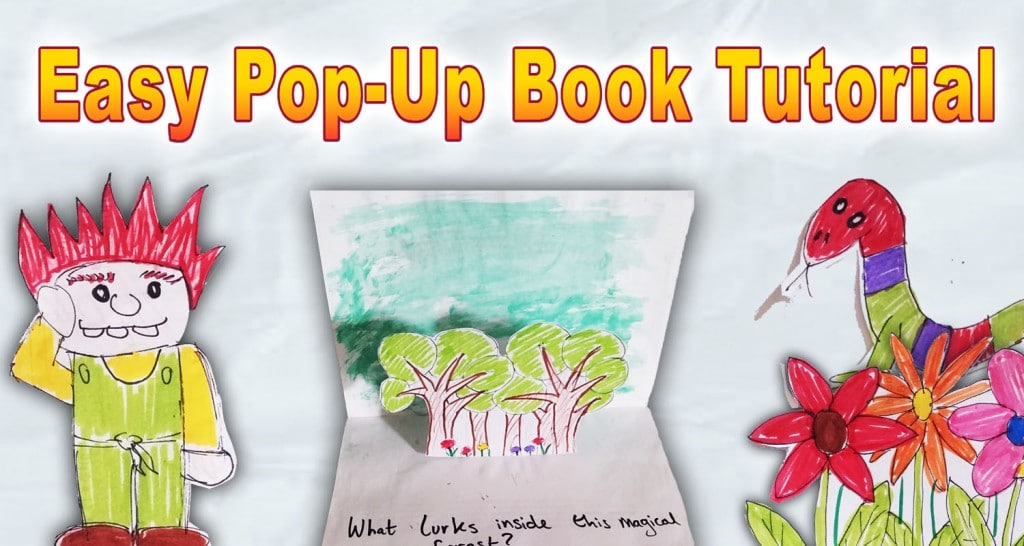
Create Mini Booklets
Turn your child’s story into a real book! You can buy blank books from Amazon or create your own mini paper book, using this easy mini notebook tutorial . With this tutorial you can create a fully customisable book, with your own cover, back page and you can even draw your own illustrations inside! This is a really fun and cute way to gets your kids writing in their spare time.
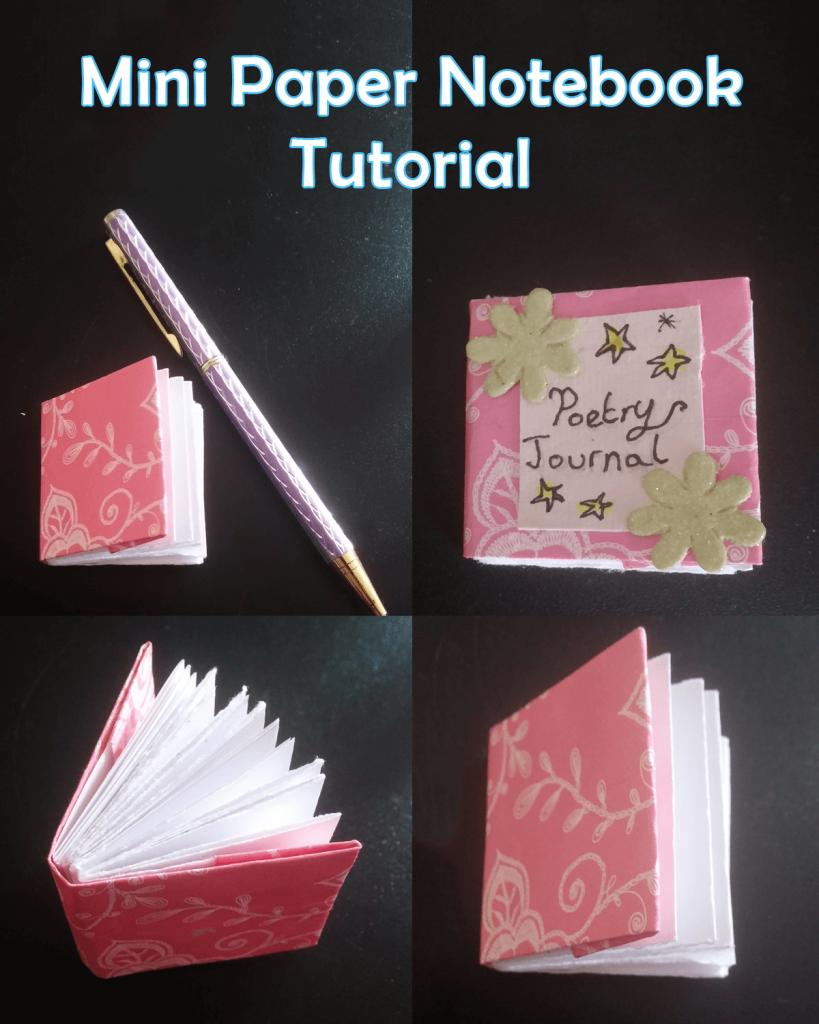

Write A Letter With a Fun Twist
Forgot ordinary boring letters! Check out our Paper craft animal envelopes to encourage your kids to write letters to their friends, family, heroes, aliens, anyone they like! Inside the child can write any message they like, such as “how were your holidays…” or “We’re having a party this weekend…” And on the outside they can create any animal or creature they like as envelopes.
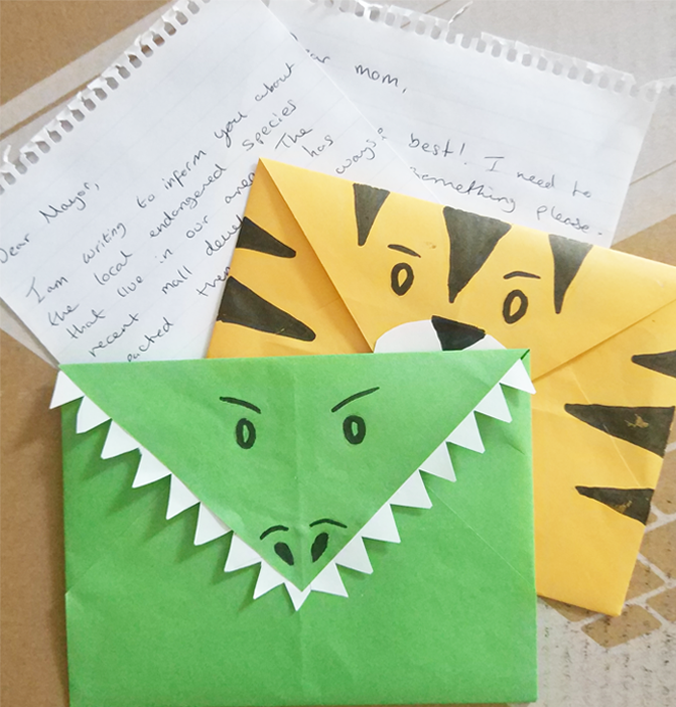
Describe a Monster
Ask your child to draw their own monster or character and describe it. – What are its strengths, and weaknesses, where does it live, what does it like doing and so on? This creative writing activity is quick, simple and full of imagination! And you could even take this a step further by creating your own monster flip books !
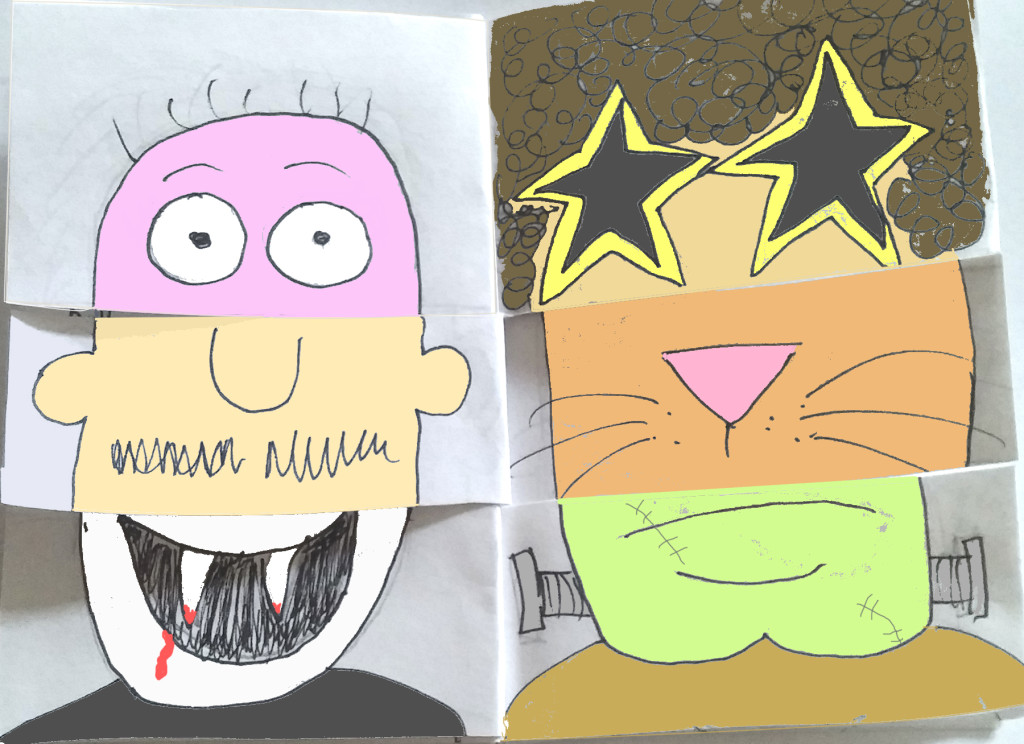
Use Story Starters
Use story starters to inspire reluctant writers. These can be simple sentences, such as “It was Timmy’s first day at school and he was excited…” and your child can continue writing the rest of the story. Or you could use photos and your child’s drawings to inspire story-writing by asking the child to describe what’s happening in this image. Take a look at this post on 60+ first-line prompts to inspire you or you could view our mega list of over 300 writing prompts for kids .
Create Your Own Greeting Cards
Get your child to create their own Christmas cards , greeting cards or get well cards to send to someone they know. They can write their own personal message inside and draw a picture on the outside. Quick activities like this are a great way to sneak in some writing with some arts and crafts.
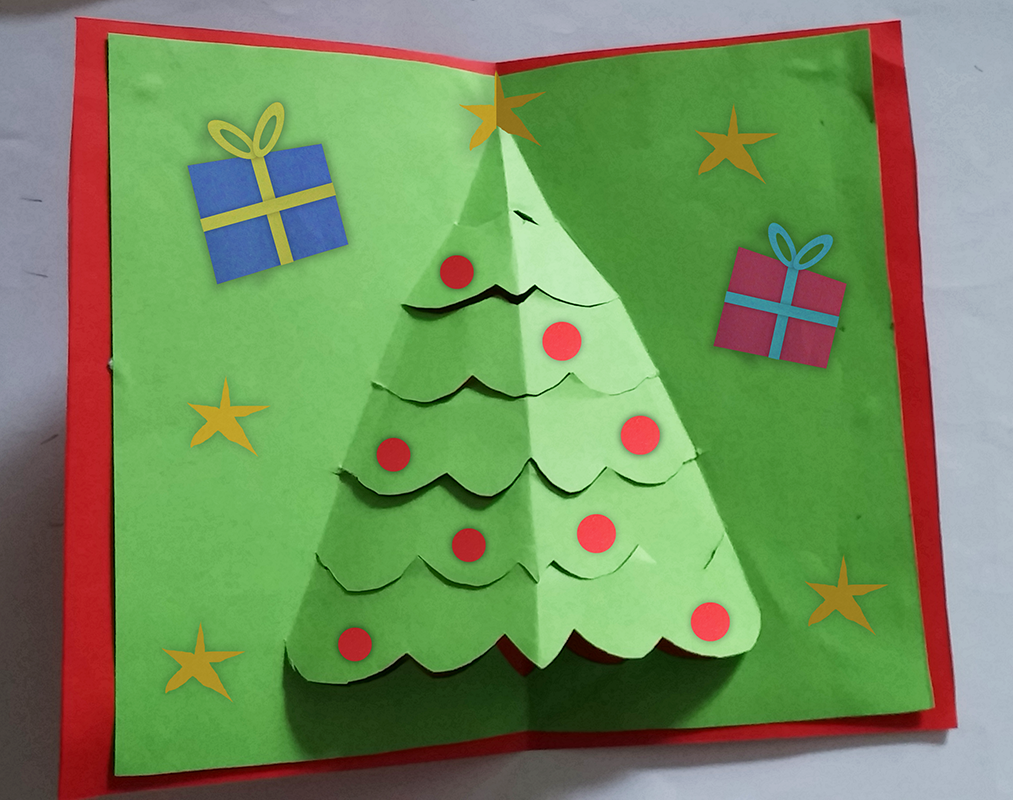
Create Your Own Newspaper
Ask your child to write their own newspaper article or create their own newspaper about the daily events that happen at home or at school. Remember the use of the 5 W’s and 1 H when writing newspaper articles. Our newspaper challenge online activity is great for creating fun newspaper articles.
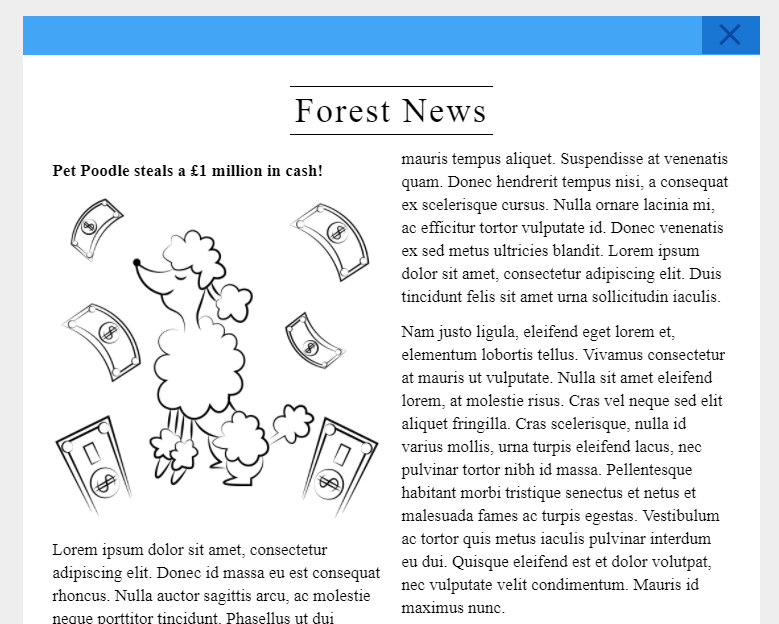
Make A Shopping List
Get the kids involved in the weekly grocery shopping! Ask them to write the shopping list with drawings. If the grocery shopping list is too boring, then get them to create a wish list of items they dream of owning or even a list of goals they want to accomplish. You can buy some really pretty shopping list pads from Amazon , which could be a great way to encourage your kids to get writing!
Re-tell some fairytales
Fairytales have been around for centuries and by now they need a modern twist. Challenge your child to update an old classic. And you could even use this free ‘Retell a fairy tale pack ’ to help you. Re-telling a fairytale is a lot easier than creating a whole new one – Simply ask your child to change one or two key elements in the story and see how it changes the entire fairytale. For example, what if Cinderella was the villain? Alternatively, you could go wacky and add a whole new character to a classic fairytale, such as Spiderman making an appearance in Jack and the Beanstalk. The possibilities really are endless!
Write Your Own Movie Script
Ask your child to write their own short movie script, they can create a cast list and give all the different characters different things to say. You can find a free script and cast list template here ! Think about the conversation between the characters, what problems would they encounter, who is the villain in this story? We also think these free finger puppets printable could be great for story-telling.
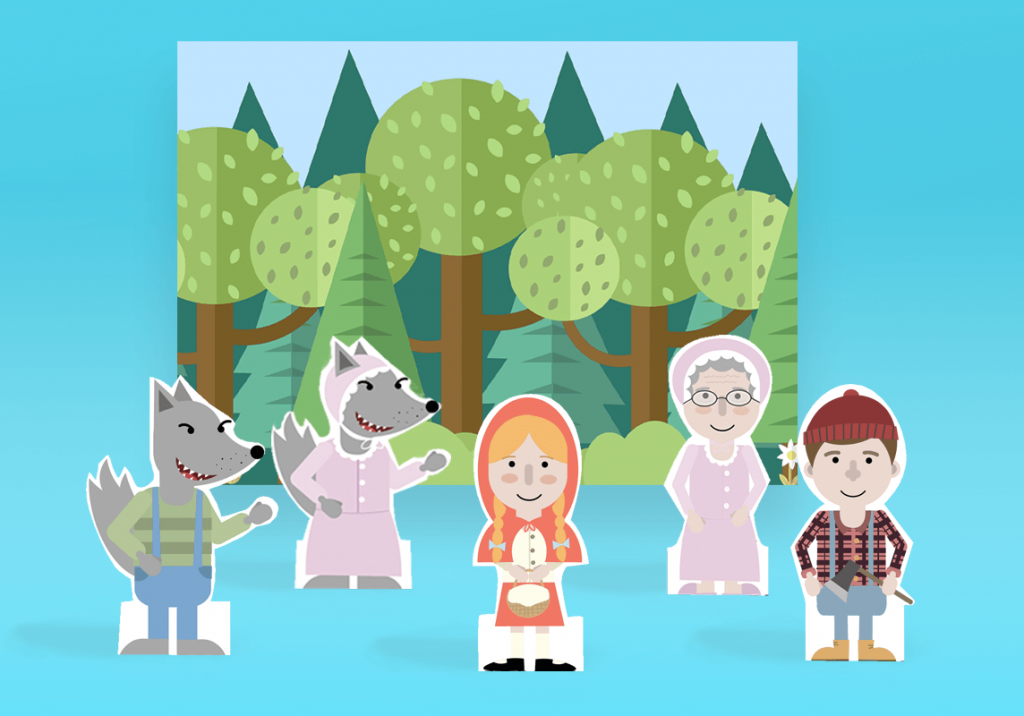
Hand-written Blogs
Ask your child to keep a simple hand-written blog about their hobbies and interests. This can be done in a journal or notebook. Ask them the following questions: What do they like doing in their spare time and why do they enjoy this. Maybe ask them to provide instructions on how someone else can also be good at this hobby. They can update their hand-written blog everyday with new tips and interesting pieces of information on their hobby.
Wanted Posters
Create a ‘Wanted’ poster for famous villains in storybooks, such as Miss Trunchbull from Matilda or Cinderella’s Stepmother. You can find a free blank template here . Alternatively try out the Most Wanted online activity on Imagine Forest, to create your own wanted posters online:
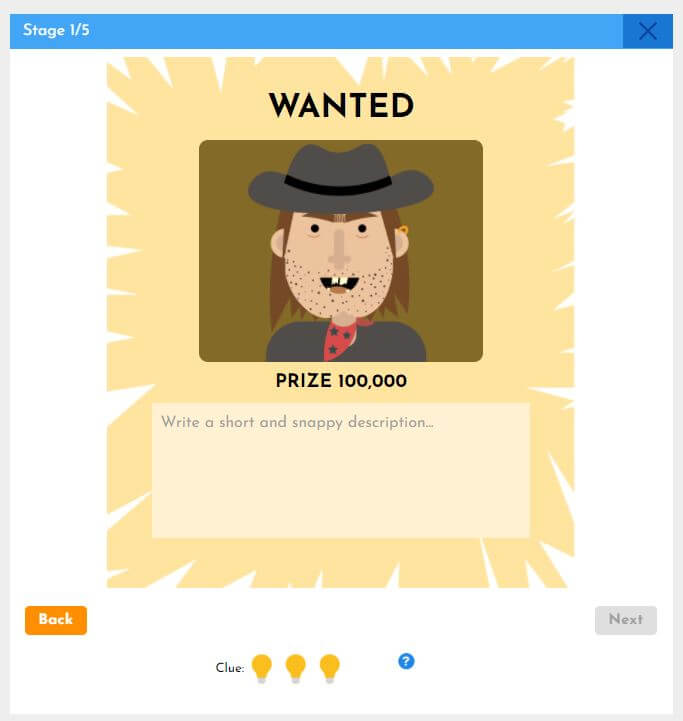
Storyboarding
Writing a whole story down can be cumbersome. That’s why storyboarding can make a really good creative writing activity. Instead of asking a child to write a whole story down, get them to think about the key events in the story and plan it out using a storyboard template . Planning their story out beforehand could even encourage your child to write a complete story down afterwards. The first step is always planning out what you are going to write, and this could give your child the confidence to keep going.
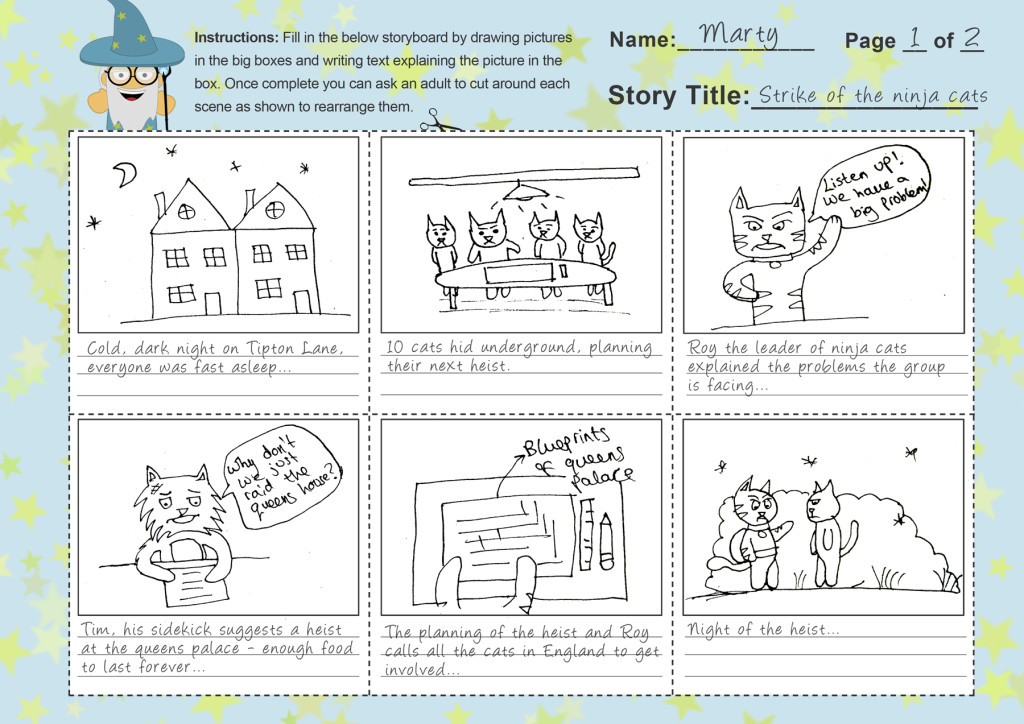
Know anymore fun writing activities for kids? Tell us your ideas below.
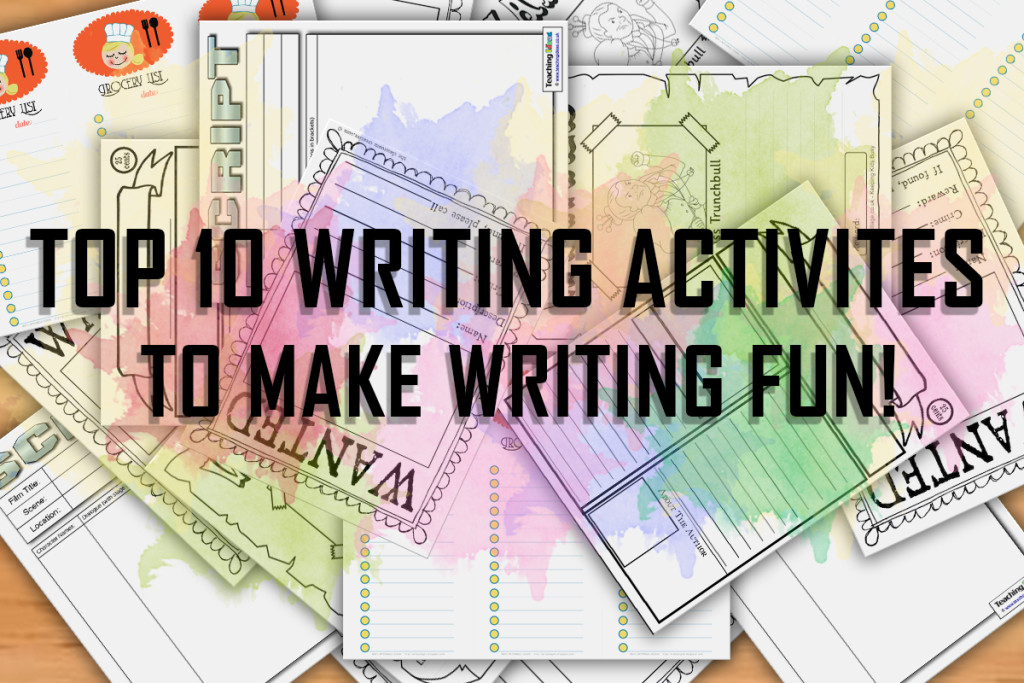
Marty the wizard is the master of Imagine Forest. When he's not reading a ton of books or writing some of his own tales, he loves to be surrounded by the magical creatures that live in Imagine Forest. While living in his tree house he has devoted his time to helping children around the world with their writing skills and creativity.
Related Posts
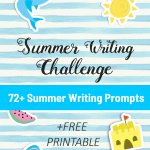
Comments loading...

8 Fantastically Fun Writing Games For Kids

Writing is a life skill your child will need during their time at school and beyond. Teaching children to write can be challenging, but there are many ways to make it simple, stress-free, and enjoyable for both you and your child!
Introducing fun writing activities and games can transform your child's attitude to writing, so we’re bringing you our very own list of the best writing games for kids that you can try anytime, anywhere!
(Psst...If you're in a hurry, jump to the best writing game for kids )
Unscramble the Sentences
This writing game offers a great opportunity for your child to test their sentence structure skills, whether they’re learning to write complete sentences, or creating more complex sentences.
How to play:
- On a sheet of paper, write down a sentence.
- Cut each word out from the paper and scramble the new pieces with your hands.
- Ask your child to put the words into the correct order to make the complete sentence.
Unscramble the Sentences is pretty easy to set up, and you can either play on paper, or online! On Night Zookeeper , we’ve transformed Unscramble the Sentences into a fun, interactive experience called Waterfall Word Jumble:
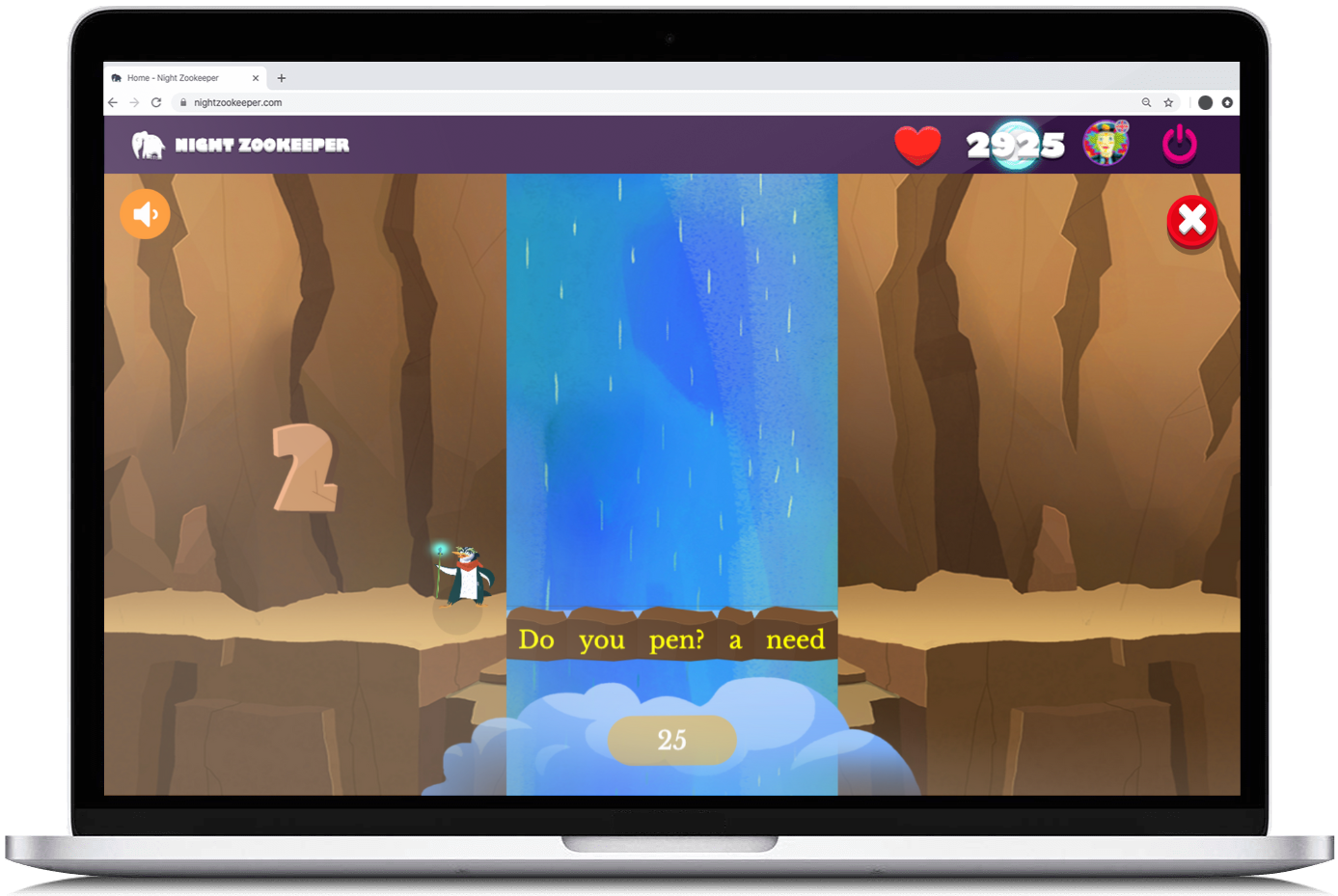
Matching Word Game
Matching words is a popular game to play in the classroom, or at home, by yourself or with fellow classmates or family. There are endless possibilities when it comes to this game through different types of matching; you can ask your child to match synonyms, antonyms, pronouns, and the list goes on!
- First, decide on the theme of the game. In this example, we’ll be matching antonyms, or opposite words.
- Start by cutting a sheet of paper into eight different pieces. In four of the pieces, write down your original words, and in the remaining four pieces, their opposites.
- Once all your words are ready, ask your child to match each word to their opposite meaning!
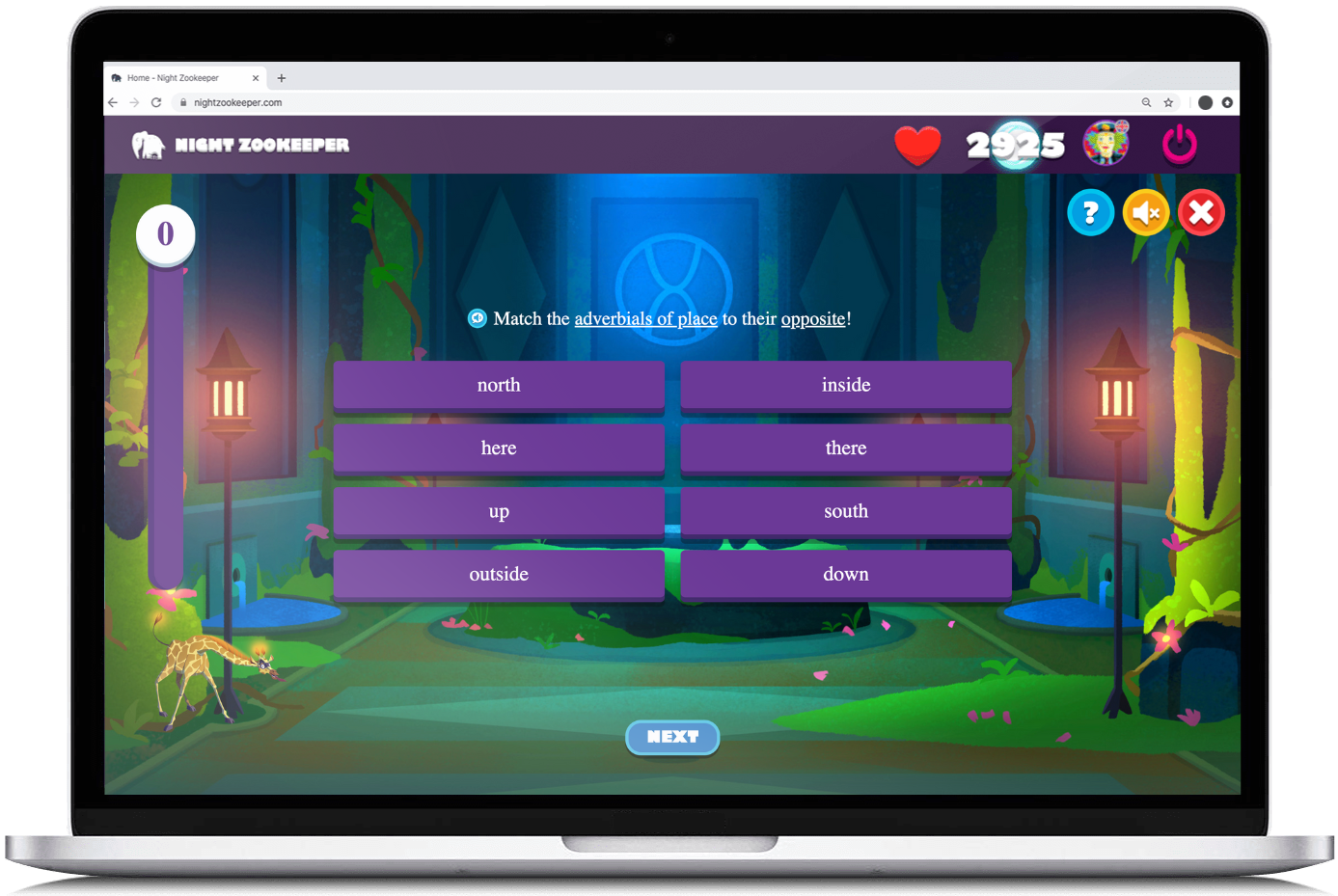
Use the example above to create your first matching word game, or get your child to play Maji’s Matches on Night Zookeeper !
Drawing & Writing Game
Drawing and writing go hand-in-hand , as their synergy promotes the development of creativity, imagination, motor skills, and even critical thinking!
There are many drawing games out there, but perhaps the most popular one is Pictionary. Even if you don’t have the board game version, you can set up your own version of Pictionary, and base it on topics of interest for your child, or to consolidate knowledge learned at school or during homeschool lessons.
This is a multiplayer game, so it’s best to play as a group, either with classmates or family.
- Start by gathering sheets of paper and coloring pencils or pens. The game starts when the first player writes a description of whatever they want the second player to draw.
- Once the second player completes their drawing, they must hide the original description and get the third player to write a description of what they see.
- Once the third player has written this description, they must hide the original drawing before asking the fourth player to draw what is written on the paper and so forth.
- When the game ends, you should have a sheet of paper full of funny descriptions and drawings!
Storytelling Cards
To play this story writing game, you’ll need to make five storytelling cards for each component of a story:
Once you’re done creating your cards, mix them up and ask your child to pick a card from each category. After they’ve pulled a card from each stack, get them to use their creative writing skills to write an original story using the cards they chose. This is a fun creative writing game to take on a roadtrip or when you’re traveling, as storytelling cards allow for hundreds of possible combinations, keeping your child entertained for potentially hours!
Fill in the Gaps
If you feel that your child is not yet ready to write a full story on their own, this creative writing activity may be exactly what they need to encourage them to start thinking creatively.
- Write a short story on a sheet of paper and leave some intentional gaps.
- Then, ask your child to fill these gaps with nouns, verbs, adjectives, adverbs, and even punctuation.
- Once they’ve filled all the gaps, they’ll have a completed story to read and share with their family and friends!
You can take excerpts from your child’s favorite storybooks, or try Penguin’s Paragraphs on Night Zookeeper !

This fun writing game is a classic, and remains a favorite to this day! Its versatility allows the game to be played in the classroom, at home, with pre-k students, high school students, and even during family game nights!
Hangman is a great writing game to improve your child’s vocabulary knowledge. It’s also an effective way to consolidate more technical words introduced in other subjects (such as math or science).
- Pick a topic & a game host
- The game host will choose a word and, on a sheet of paper, draw a line for each letter of the word the other players are guessing.
- Players will take turns to guess letters. If they get it right, the host must write the letter in the correct line. If not, they’ll draw a line for each wrong letter guessed until the hangman is complete.
- You can let the players guess the whole word once they think they have the right answer, and award extra points if they’re correct.
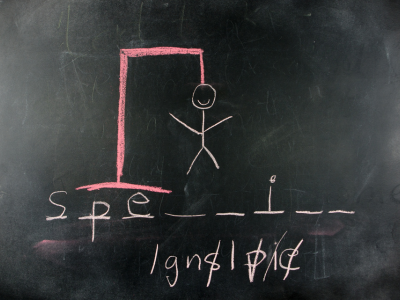
Quick-fire Tales
This is another story writing game that is perfect for on-the-go learning and can be enjoyed by even the most reluctant writers! For this educational game, your child will have to answer rapid fire questions with the aim to create a story from scratch. They’ll have five seconds to come up with an answer for each of the questions, and you should challenge them to be as creative and descriptive as they can!
- Get ready by setting up a 5-second timer.
- Here are the five questions needed to play Quick-fire Tales:
- Get your child to answer each of the five questions before the time runs out, and make a note of your child’s answers.
- Once they’ve answered all the questions, read their answers back to them and challenge their storytelling abilities by encouraging them to tell you more about this story!
The Ultimate Writing Game: Night Zookeeper

Night Zookeeper is the ultimate writing game for kids . It is home to thousands of writing games, challenges and competitions which have inspired millions of children worldwide to love writing.
On our program, your child will create original characters to power up through completing exciting games, interactive lessons and engaging writing prompts. As they progress, your child will build up their own Night Zoo and unlock new parts of the map, continuously incentivising them to write more.
“My daughter has never loved writing, but this game has made writing come alive for her. She can't wait to get on Night Zookeeper everyday!” - Michelle, parent
Make writing fantastically fun for your child today!
Sign up now to get a FREE 7-day trial:
Got any questions about Night Zookeeper? Reach out to us at [email protected] , or via our social media pages:

Make Reading & Writing Fantastically Fun!
- Award-winning reading & writing program for kids
- Improves spelling, grammar, punctuation & vocabulary
- Over 1,000 different learning games and activities

“My Child Hates Writing.” What do I do?

25 Creative Writing Prompts for Kids
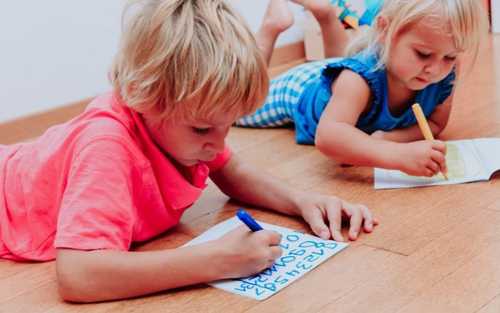
Top 7 Writing Activities For Kids

- Purchasing Printables
- Purchasing Shadow Puppets
- Site Policies
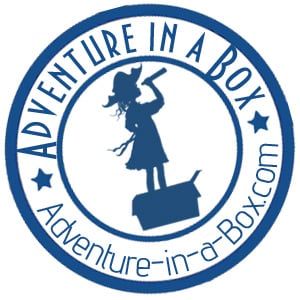
Best Board Games for Nurturing Creativity
Learning to Write , Writing Projects
Board games did not come into my life until I was in my early twenties. I had some experience playing Monopoly when I was a little girl, and there were a few versions of Snakes and Ladders, but I did not discover the variety of board games available until my best friend got a box of Carcassonne for her birthday. All of a sudden, instead of gossiping about fashion and guys, we were submerged in a world of medieval castles. It was a very successful party!

This post contains Amazon Affiliate links for your convenience.
Since then, I have been adding to my own collection of board games. I have found that, while I enjoy a good strategy game, my favourites are games that require creative thinking and interaction between players. I know a few adults who are up for a good drawing or acting game, including my husband, but children are always especially excited to play. So I started thinking about board games from the educational point of view, and I realized that many of them have great potential for developing verbal fluency, extending vocabulary, reading and writing skills, problem solving, imagination and creativity.
Here is a list of the best board and card games for exercising creative thinking – both in kids and adults! They do not target kids specifically, but are family-oriented, so kids and adult alike will enjoy playing them. For some of them, you may have to adjust the rules if you want to involve the youngest members of the company, but most will be good for ages 7+ and great for 10+. These games would delight children who are natural storytellers and are good with words, but they would also be good for those who have difficulties with using big words and could get some fun practice.
10 Best Games for Nurturing Creativity

The rules are simple: while looking at a card hidden in their hand, one player invents a description for it and says it out loud. It can be a word, or a phrase, or an association with a popular cultural symbol. Let’s say, a player describes the card with the sun in the centre of the picture above with the word, “Surprise.” Other people check their cards and find one that can be in some way “surprising” as well. All the players put their chosen cards face down, mix them together and then open them all, trying to determine which card was originally described as “surprise”.
Here is the tricky part of this game: you do not get the points if no one guesses your card right, but you also do not get points if everyone does. So when playing it, you need to choose your words wisely : you do not want to be too ambiguous, but you also do not want to be obvious! Breaking your head over what the artists meant when painting certain cards is a fun exercise as well!
As you can tell from the name, this game is largely inspired by fairy-tales, so with the abundance of queens, curses and fairies, the course of stories is somewhat predetermined, and it is more difficult to give the plot a modern spin. The language is suitably archaic at times, so children will likely need to have a dictionary or a helping parent close-by. This would be an excellent game for studying fairy-tales with kids, and adults can have fun, adding some irony to familiar plots.
We love making haikus with our kit. Here are two little humorous poems we dedicated to our son when he was three months old!

There is an old Egyptian saying, “An egg cannot break…”
What would be your variant?
Well, the right answer is “a stone”.

Let’s say… H?
A girl’s name: Hannah. Thing that goes: helicopter. School subject: history. Famous athlete: argh, I do not know any! Is Hercules an athlete?..
You have a limited time frame, and if your idea repeats someone else’s, none of you will get points, so in this game you need to be both fast and original with choosing the right words.
Let’s say the chosen adjective is “magical”, and in my cards I see “x-rays”, “flip flops”, “Statue of Liberty”, “brains”, and “Spiderman”. Not a huge choice, really. I would probably go for “x-rays” because their work is like magic to me. The person who picked up the adjective card collects suggestions from all the players and then makes his choice of what seems most magical to him.
This game helps players to learn new things about each other. As each noun has a funny explanation written on the card and all the adjectives have synonyms that are usually read aloud, it is also an excellent game for building vocabulary .
What are your family’s favourite board and card games?
If you liked this article, you may also find the following related activities interesting:
– Picture Books that Make the Best Gifts
– Books You Will Not Tire of Reading to a One-Year-Old
– Wooden Toys You Can Build Yourself
If you want to stay updated on new stories from Adventure in a Box , consider subscribing to our Facebook , Pinterest , Twitter or Instagram pages. For more indoor games and activities, check these fun ideas from my fellow bloggers:
Dots and Boxes from What Do We Do All Day?
Photo Memory Game from Betsy’s Photography
Free Sight Alphabet Football Game from Sight and Sound Reading
Football I Spy Game from The Pleasantest Thing
Noughts and Crosses with Toys from T he Gingerbread House
Indoor Bean Bag Games from Study at Home Mama

10 Comments
Wow, I had only heard of a few of these…I am going to pin for later. I know I will be looking to purchase a few board games for gifts and it is good to have a unique list to use.
I love getting board games as gifts, and these are all my favourites, so I hope that they may make good gifts for someone else! :)
I consider myself pretty game savvy, but many of these are new to me! I love Story Cubes, though!
Dixit is my favourite, and that must show since I put it first. :) But I love all storytelling games – after playing with many friends’ and relatives’ children, I am looking forward to playing with my son when he is older.
Love this list, thanks so much for pulling it together! Until I had a child, I disliked board and card games because all I was familiar with was Monopoly, Candyland, etc. There are so many interesting and creative choices out there now.
Oh, I LOVE board games and made sure my kids always had plenty to play. Now at ages 25, 27, 29 and 31 and all married, we still play board games.
I love board games. Our family played all sorts of games from board games to cards to dominoes. My son enjoys playing games too. I haven’t heard of some of the these games so I will be checking them out for sure.
these look really interesting, many are new to me. Thanks!
It is a very nice selection that you put together. Thank you, Liska! I did not know until now that you are crafting in ON, too! Cheers from Toronto, Jana
As a child, we have played a simmilar game to Scattegories, but with paper and pen. It’s called “Interesting Geography” – you draw a table on paper, with different columns: first the State, then Country, City, Mountain, River, Lake, Object, Animal and Name. After choosing a letter, everybody fills the columns. Whoever finish it first, has to give the rest one minute to finish their tables, and then goes the points – if you have different state written, both of you gets 10 points. If it is the same, 5 points, and its the same rule for every collumn. We use to play it for hours! Thank you for reminding me on this, I had forgotten all about it!
Trackbacks/Pingbacks
- Sight Word Football Game – Mrs. Karle's Sight and Sound Reading - […] Memory Game Dots and Boxes Game Football I Spy Game Noughts and Crosses with Toys Board games that nurture…
- Quick + Easy Photo Memory Game ⋆ Betsy's Photography - […] Adventure in a Box shares board games that nurture creativity. […]
- Football I Spy Printable Game - The Pleasantest Thing - […] Board Games for Nurturing Creativity from Adventure In A Box […]
- Should Boys Play with Dolls? - Adventure in a Box - […] – Board Games for Nurturing Creativity […]
- Bookcrossing: Send a Book on an Adventure - […] – Board Games for Nurturing Creativity […]
- Social Health Benefits of Creativity | Alongside You - […] Teletrations, and Cranium are great games that use words to spur on drawing or sculpting actions. Here is a…
Submit a Comment Cancel reply
Your email address will not be published. Required fields are marked *

adventureinabox
Artist, writer, and creator of: 🎲educational games 🎨paper dolls and crafts 🎭shadow puppets Also me: 🍁Canada, PEI 🎓homeschooling mom of 2 📚book lover


- Kindergarten
- Language Arts Curriculum
- Science Curriculum
- History Curriculum
- Math Curriculum
- Advice & Encouragement
- Preschool Curriculum: Rhythms of the Year
- Elementary Years
- Recommended Books
- Arts & Crafts
- Thanksgiving
- Personal Growth
- Time Management
- Work From Home
Select Page
Writing Games and Activities
Nov 2, 2020 | Curriculum , Elementary Years , Games , Homeschool , Kids Activities , Printables | 0
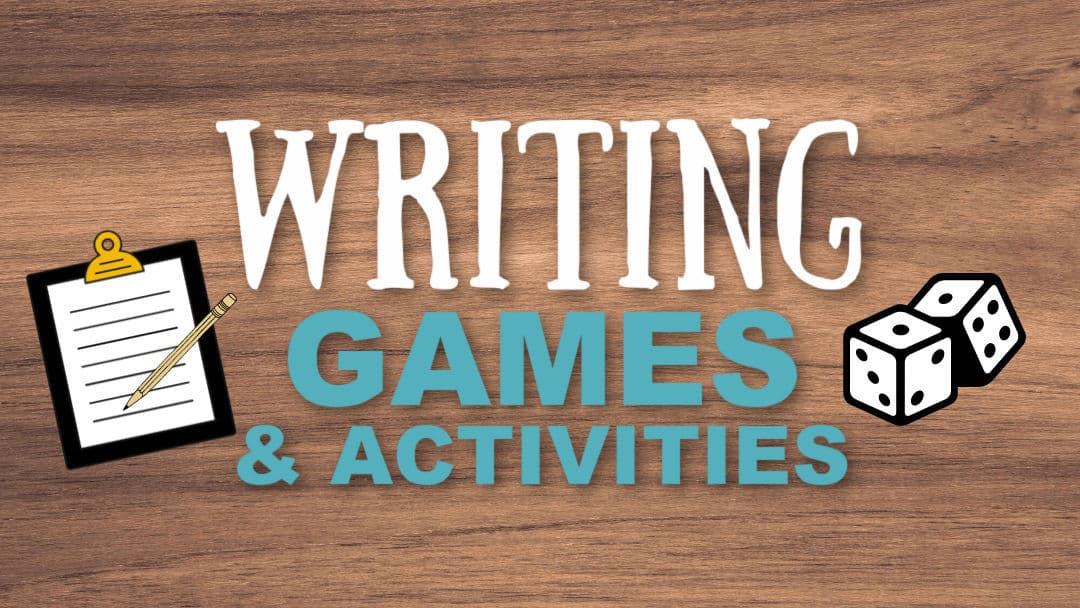
Sharing is caring!
Make writing fun with these games and activities for kids, families, and homeschoolers!
Practicing writing can be a daunting task for many kids, and let’s be honest, just people in general. Writing is such an important skill though! So how do we help our kids practice writing & keep it fun? We use writing games & activities!
In my family writing is incredibly important. Our kids know that my husband and I are writers in addition to other jobs we have. I write here on this blog and my husband is writing a book series that will be released in 2021. The kids see us write every single day . It is also a requirement for our kids to write something every day.
Just saying, “Go write something,” can be too broad or get boring after a while though.
There are so many fun ways to change it up and include writing in your day.
Writing Games for Kids
This is a brand new game that I made for you! We’ve played it as a family and my kids have really enjoyed it. It helps them flex their creativity and think outside the box.
The full game includes an instruction page, 3 pages of different genre themes, and a blank sheet to make your own dice tales in whatever theme you want! The full game is included in the Writing Games & Activities Printable Pack here .
How to Play:
Choose which genre sheet you want to use for Dice Tales.
Assign one color die to the top row and a different color die to the column.
Roll the dice 3 to 5 times to get story elements. Write each of them down. Write a story including each of the 3 to 5 elements you rolled.
This can be done as an individual activity or group activity.
Group Variations:
- Each person writes their own & then read them aloud.
- Write in a round, where 1 person starts, writes 1-3 sentences then passes to the next person.
- Could be done orally
You can get the instructions & 1 page of the game for FREE! Just fill out the form below & it will be emailed to you.
This post contains affiliate links. If you make a purchase after clicking a link, I will earn a commission. Disclosure policy
Writing Games & Activities Pack
This printable pack of writing games & activities will engage your kids & make writing fun! They can be used by a single person or as a group game.
These games and activities will engage both reluctant writers and budding authors. The games and activities have instructions for both individuals and groups.
Add these to your homeschool writing curriculum or a family game night.
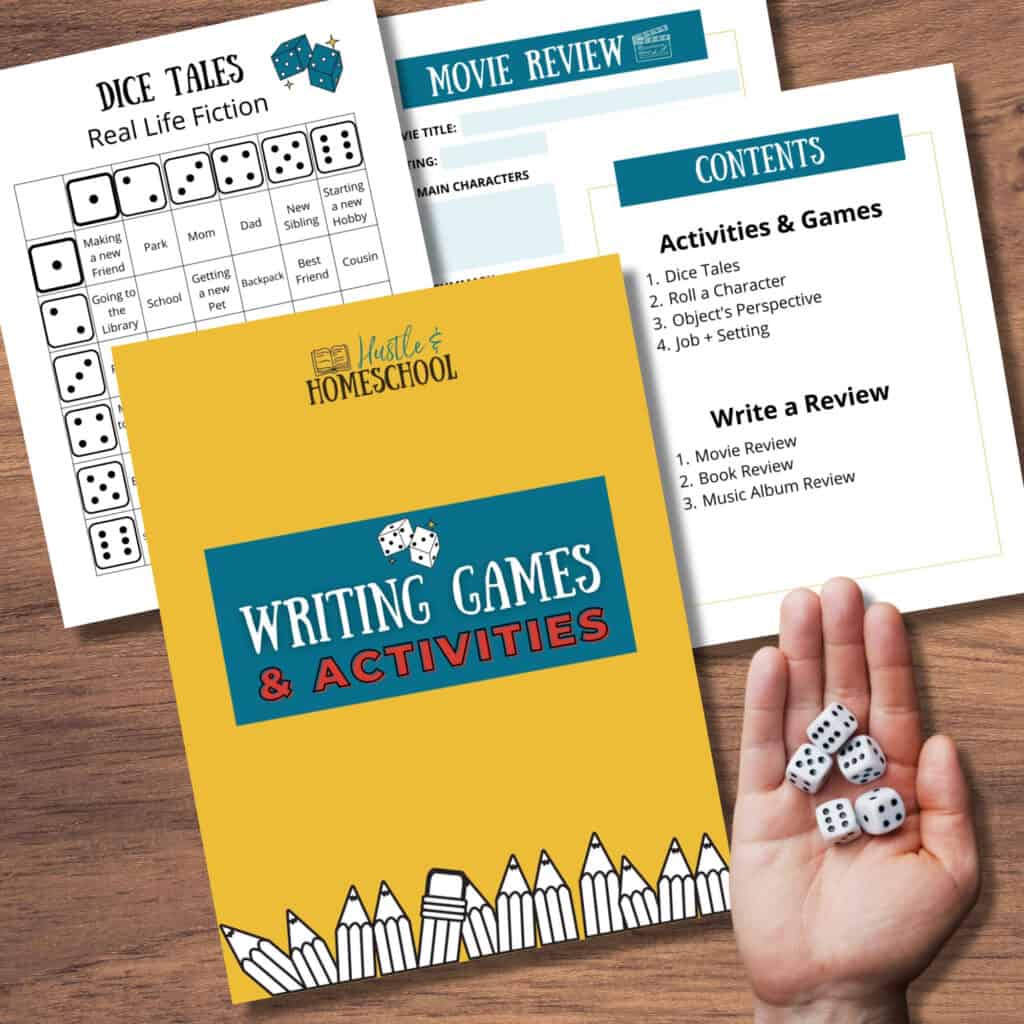
What’s included:
Games & Activities:
- Build a Character
- Object’s Perspective
- Job + Setting
Write a Review:
- Movie Review
- Book Review
- Music Album Review
Other Writing Games
There are tons of great card games and board games that are great for developing writing skills! Check out some of these games by clicking the links below. These are great additions to family game night and make great gifts for kids!
Always pair fun & education!
- The Storymatic
- Rory’s Story Cubes
- Tall Tales Storytelling Board Game
- Once Upon a Time Card Game
- Nanofictionary
- Scategories
Night Zookeeper
This is a really fun online writing game for kids ages 6 to 12. It’s engaging and also includes feedback on what they’re writing. It includes creative writing, spelling practice, and grammar instruction.
If your kids enjoy fantasy or animals, then they will like this game!
They have given my readers a 7 day free trial & 50% off a membership! Click here to get the discount on Night Zookeeper.
WriteShop Printables Mega Pack
This mega pack of printables includes over 600 pages of games and activities for kids from prewriters to teens. No matter how old your kids are, you’ll find writing activities that they can do!
Click here to get the Writeshop Printables Mega Pack.
Other Educational Games
- Best Games for Kindergarteners
- Best Games for 1st Graders
- Best Family Board Games
Pin it & Share
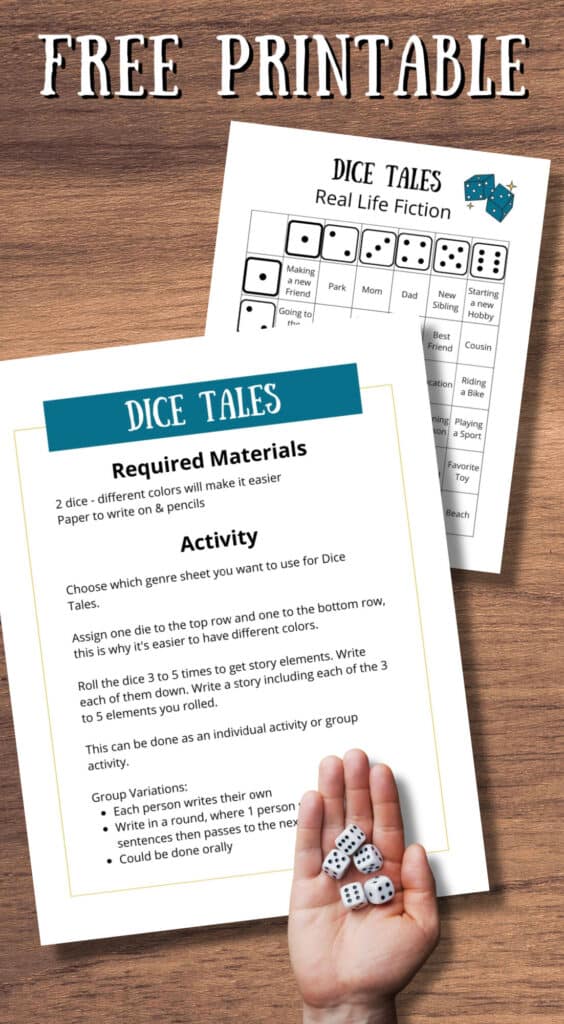
Related Posts

Set Goals to Achieve Success & Transform Your Life
February 11, 2019

Dinosaur Unit Study for Homeschool
March 4, 2019
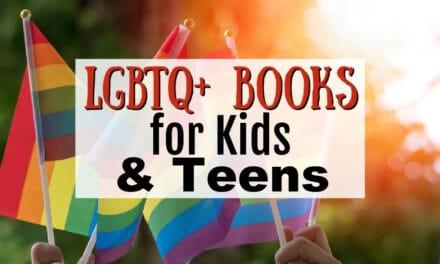
LGBTQ+ Books for Kids & Teens
June 1, 2021

Black Friday Homeschool Deals
November 20, 2022

Homeschooling Mom of 3 boys, photographer, and blogger. I’m all about helping other moms find balance while pursuing their passion, start businesses they love, and homeschool!
This website contains affiliate links. If you make a purchase after clicking a link, I will earn a commission. Disclosure policy
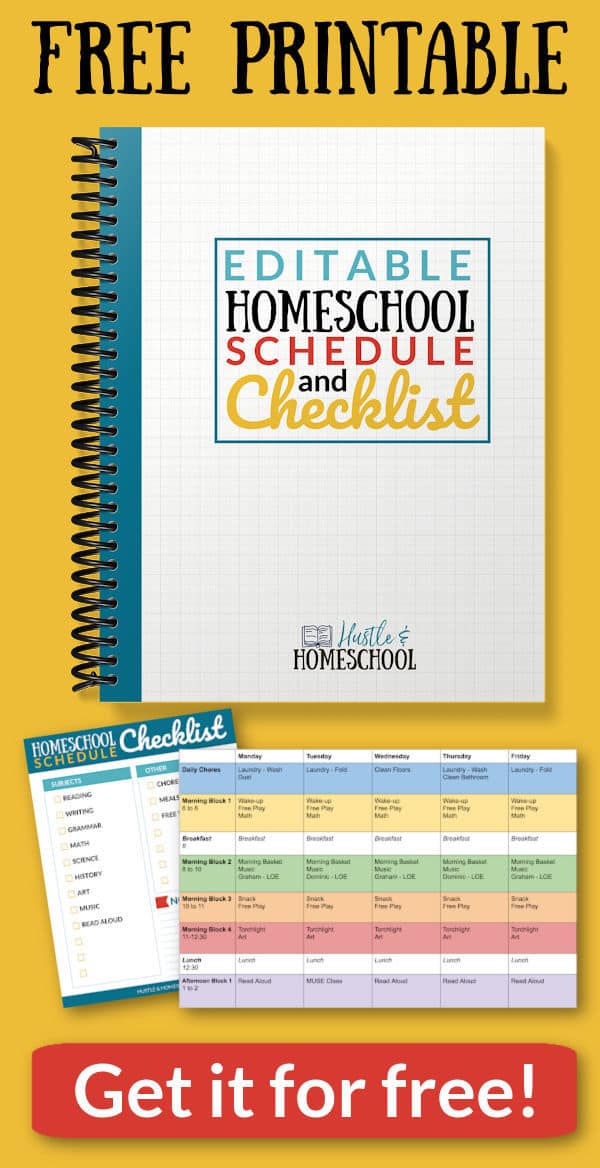
LitHouse Learning

Logic of English
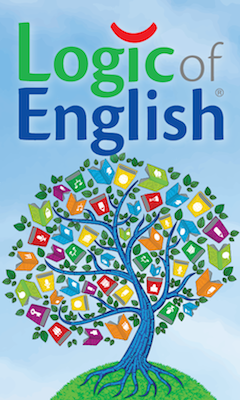
Pandia Press

Right Start Math
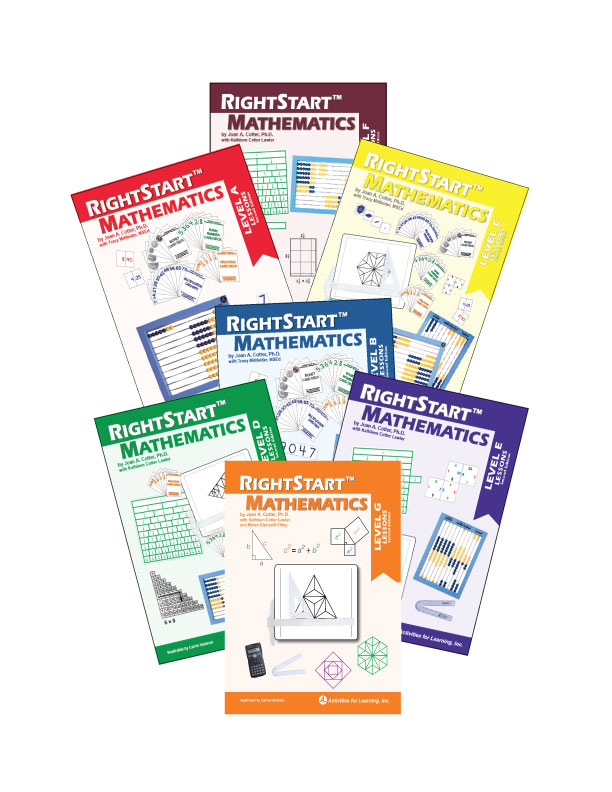
Big Life Journal

Recent Posts

Hustle and Homeschool is a participant in the Amazon Services LLC Associates Program, an affiliate advertising program designed to provide a means for sites to earn advertising fees by advertising and linking to Amazon.com.

10-Minute Writing Games to Play with Your Students
Jen Schneider Blog , Writing writing 1
Want some quick games to share with your students during transitions or as attention-getters. Play these fun games independently or with groups! Here are a few of my favorites 10-minute writing games to play with your students. This post uses some affiliate links. Purchases from these links result in a small commission to help sustain this site.

Word Association Game
Word association games are perfect for 10-minute writing games! Start by giving students a random word and ask them to write down the first word that comes to their mind when they hear it. Then, have them pass their paper to the person next to them and repeat the process with the new word. Set a timer for 10 minutes and see how far around the circle they can go, building off of each other’s words. This game is a blast for generating vocabulary words or words to use in future writing prompts or stories.
Writing Roulette
My students beg to play writing roulette! I give each student five different colored sticky notes (or use this FREE Jamboard template ).
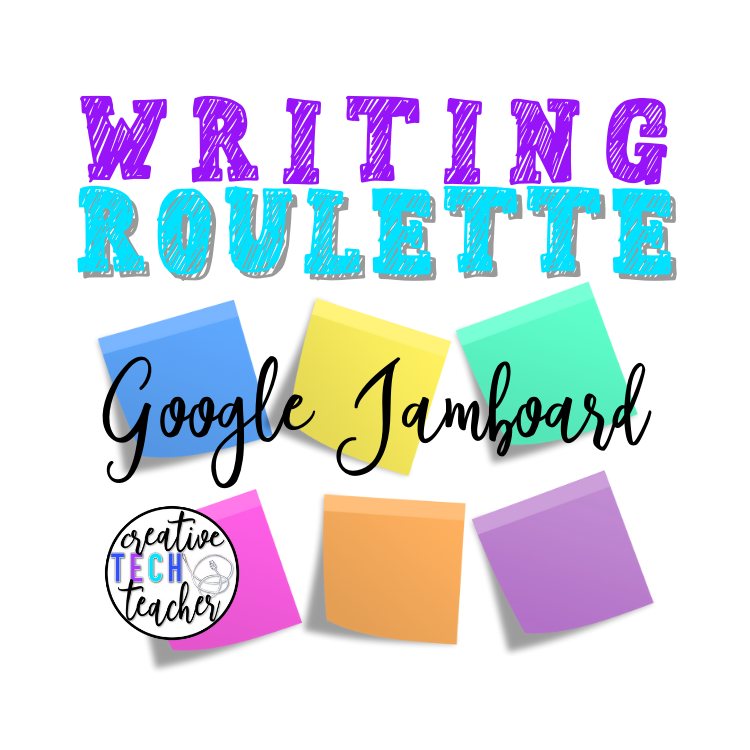
Each sticky note has a different topic. For example, here are the literary elements I use for my students. You can change these up depending on your grade level.
- Yellow: character
- Blue: quotation
- Pink: setting
- Green: conflict
- Orange: theme
Have your students each generate one of the literary elements on each colored sticky note. Make sure they write only one idea per note. Mix up the sticky notes, then give the students five sticky notes (one on each topic) to generate their own story. We LOVE sharing these with the class. As a bonus, expand on the quick stories and create a published, polished piece.
Literary Jenga
Literally playing a game when writing is so much fun! Write creative writing prompts on the sides of Jenga blocks (such as “Write a story in which the main character is an animal” or “Describe a place you’ve never been”) and stack them up. Students take turns pulling a block and then writing for 2-3 minutes based on the prompt they see. The game continues until the tower falls, and then students can read aloud what they’ve written.
Finish the Story Writing Game
This game is also called story or paper pass. I remember playing this writing game in school. I loved it then as much as I love it as a teacher! First, give students the first line of a story and have them write for 2-3 minutes. Then, have them pass their paper to the person next to them and that person continues the story for 2-3 minutes. Continue this process until everyone has contributed, and see how the story turned out in the end.
Random Word Stories
Use this random word generator to pick a fun, unique word. Have your students write a story using that word as a focus. You can have each student select their own word or use a class word.
Descriptive Writing Game
Many ELA curriculums have descriptive writing as an assessment. Why not teach descriptive writing skills with a 10-minute writing game! First, ask students to close their eyes and imagine a scene you describe to them, such as a beach or a forest. Give them 10 minutes to write a detailed description of what they see in their mind’s eye. Encourage them to use sensory language and descriptive adjectives to really paint a picture with their words. Share the stories, and as a bonus, have students illustrate their writing. You can also adapt this and share a picture as a writing prompt starter. Show students a picture or image and give them 10 minutes to write a story or poem based on what they see. Encourage them to be creative and use their imagination to build a story around the picture.
Character Creation Game
Students love creating their own characters! Have students brainstorm a character by answering questions about them, such as their name, age, occupation, likes and dislikes, fears, etc. Then, set a timer for 10 minutes and have them write a short story or scene featuring that character. You can add to the fun by having two characters team up together to create a new story or have a conversation with one another based on their characters’ backgrounds.
Six-Word Stories
Challenge students to write a complete story in just six words, such as “For sale: baby shoes, never worn.” Set a timer for 10 minutes and see how many six-word stories they can create.
Mad Libs Game
The old Mad Libs games are so much fun! I remember having paper Mad Libs books that my siblings and I giggled over with delight. Online Mad Libs games let students work independently to create funny stories. I love using Mad Libs online !
Fan Fiction
My students absolutely love writing fan fiction. This gives them a chance to explore stories on a deeper level, and change the outcomes to what they really wanted to happen in the book! Have students choose a favorite book or movie character and write a short story featuring that character in a new adventure or scenario. Set a timer for 10 minutes and see how well they can capture the voice and personality of the character in their writing.
Story Cubes
Use storytelling dice or story cubes with pictures on each side, and have students roll the dice to create a story. Set a timer for 10 minutes and challenge students to create a story that includes all of the pictures they rolled. Share the stories in small groups or with the full class.
Writing Prompts
Using writing prompts in the classroom is an effective way to encourage a love for writing in students. Here are five ways to inspire and engage middle school students:
Daily writing prompts
Start the day with a short 10-minute writing exercise that covers various genres and themes. Use this list of 25 daily prompts to get started.
Structured writing prompts
Use prompts as a starting point for more structured writing assignments such as essays or research papers. This encourages students to think critically and provides specific guidelines for the writing task. Use this list of 10 structured prompts to get started.
Group brainstorming
Encourage students to work together in small groups to generate their own writing prompts. This fosters collaboration and creativity.
Writing prompt dares
Students can create their own writing prompt dares or use these 15 writing prompt dare examples to get started. These are great for group brainstorming prompts.
Try out this 52 writing prompt workbook . You even get an editable Canva link to add your own unique prompts!

Get ready for 10-minute writing games to use in your classroom! These games can be scaffolded and differentiated for all grade levels. What writing games do you use in your classroom!
Creative writing games: A great way to unleash your creative side @
[…] technique of creative writing involves the creation of tales. The exploration of worlds, and the creation of people and situations that come to […]
Leave a Reply Cancel reply
Your email address will not be published. Required fields are marked *
Privacy Overview
CREATIVE WRITING BOARD GAME ACTIVITY -Writing Challenges & Literary Terms Review

Also included in
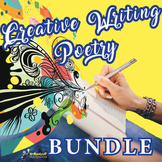
Description
Give your high school ELA and creative writing students a lesson they will always remember with this fun writing and literary terms review activity! Players race around the board, performing writing and speaking tasks, and answering literary terms questions. Goal? To get to the Amazon Bestselling Author Banquet with the most royalty payments. Students can never be quite sure when royalties will be lost or gained, or whether a path will provide them with a shortcut to the banquet or send them hurtling back again. This truly is a never bored board game!
Who is this game intended for?
Students aged 15-18 in English Language Arts classes - especially if they are taking a creative writing unit -will relish this game. Students in a designated Creative Writing course will also lap it up!
Purposes of the Never Bored Board Game
~ to provide writing practice.
~ to provide some incentive to learn literary terms; students will have to answer questions based on a list of 50 terms to be successful. The game could be used as either preparation for a test, or as a reward after one.
~ to reflect orally on the creative process.
~ to have fun- lots of it!
Game concept
Students are famous writers. The player who arrives at the Amazon Bestseller List Banquet with the most royalty payments wins. Players travel around the board from home to the banquet, picking up activity cards as they land on Literary Terms, Share and Dare squares. Players win royalties by answering literary terms questions, by verbally sharing their ideas on a creative topic for 30-45 seconds, and by performing Dare writing activities.
Dare questions involve creativity and daring: mini writing activities, such as writing haikus and limericks, have to be completed before the play returns back to the writer. The mini-writing piece is then read out to the group.
Travelling around the board, perils threaten – like forgetting their laptop or being accused of plagiarism. They will never be bored with this board game!
Numbers of players per board
This can vary between 4-7 students. Fewer than 4 is not as exciting or educational because the game ends quickly. A game for 6 players will last about an hour. For a class of 28 students you would need to photocopy 4 boards.
Items included in the game
All the components are designed for 8 x 11 size paper
The 4 quadrants of the board (they need to be taped together by the students) (PDF)
8 game pieces (PDF)
32 literary devices cards (8 to each sheet of 8 x 11) (1 PDF)
32 share cards (8 to each sheet of 8 x 11) (1 PDF)
32 Dare cards (8 to each sheet of 8 x 11) (1 PDF)
1 x 8 back design each for the share cards, the Dare cards, and device cards (PDF); these can easily be omitted and the back of the card left plain (PDF)
1 x 10 royalty payments sheet (PDF)
1 list of the literary terms and definitions students will need to know for the game (PDF)
An editable sheet of cards for teachers to create their own questions (Word document)
Assembly of the game
All of the items for the game- the board, the question cards, the royalty payments, and the game pieces- can be photocopied onto 8 x 11 paper. A color printer is not required. Apart from photocopying, the rest of the game can be assembled by the students. To save teacher time, the cards can be cut by the students, but they should be cut from the back of the card; looking at the side where the questions are will give them an advantage.
If you are sure you will use this game again with future classes, it is worth photocopying onto cardstock, or photo paper, or even laminating the board. That way, the game boards and cards will last for the rest of your career.
There must be one set of each type of cards (Share, Dare and Devices) and one sheet of game pieces for each board.
One dice per board is needed, or students can use a random dice throw generator on their phones.
Thanks so much for checking out my resources! Click HER E to make yourself a follower. You will receive notification of new resources and SAVE 50% off for the first 48 hours.
Never Bored Board Games:
Macbeth Board Game
Hamlet Board Game
Comprehensive, fun Creative Writing Resources:
Creative Writing Poetry Unit: 18 High School Lessons, PowerPoint and Workbook WINTER CREATIVE WRITING Fun Prompts and Activities Any questions? Please contact me at [email protected]. I would love to hear from you!
Questions & Answers
Brilliantly lit.
- We're hiring
- Help & FAQ
- Privacy policy
- Student privacy
- Terms of service
- Tell us what you think
- How To Get Pregnant
- Infertility
- Pregnancy Week by Week
- Second Pregnancy
- Giving Birth
- Post Pregnancy
- Breastfeeding
- Development
- Browse Names
- Play & Activities
- Coloring Pages
- Food & Nutrition
- Health & Fitness
- Style & Beauty Care
- Collaborations
- New Parents
- Single Parenting
- Relationships
- Baby Eye Color Calculator
- Online Pregnancy Test
- Chinese Gender Predictor
- Implantation Calculator
- hCG Calculator
- Period Calculator
- ovulation calculator
- pregnancy due date calculator
- Child Height Predictor
- Pregnancy Weight Gain Calculator
- Breast Milk Calculator
- Child Growth Percentile Calculator
- Baby Cost Calculator
- BMI Calculator For Kids & Teens
- Contraction Calculator
- Immunization Scheduler and Chart
- C-Section Checklist
- Online Twin Pregnancy Quiz
- Numerology calculator
- Child Blood Type Calculator
- Nakshatra Calculator
- Diaper Bag Checklist
- Baby Name Combiner
Home • Kid • Play And Activities
15 Creative Writing Games And Activities For Kids
Help your children develop their writing skills with the help of games and practice.
Elisa has 17 years of experience in early childhood education as a teacher and a director. With a passion to work with young kids, she did her post graduation in Education and received her online teaching certificate from California State University, East Bay. Read full bio of Elisa Yi
Harshita is a graduate in commerce and holds a PG Diploma in Patent and Copyrights Law from NALSAR University. She has also pursued CA and has more than three years of internship experience in auditing. Her love for travelling has taken her to various parts of the world, and writing the travelogues was what brought out her love for content writing. Read full bio of Harshita Makvana
Deepa Rachel Thomas holds a master’s degree in English from the English and Foreign Languages University, Hyderabad. She has done a certification course in Child Development and worked as a mentor for young children at an NGO that focuses on helping children develop their language and soft skills. Read full bio of Deepa Thomas
Nisha Bharatan is a writer with six years of experience. After completing her engineering from Savitribai Phule Pune University, she did content marketing courses to complement her interest in writing. Nisha discovered her passion for writing in 2016 when she started documenting her journey into motherhood. Read full bio of Nisha Bharatan
Mark Twain said, “Writing is easy. All you have to do is cross out the wrong words.” Although children may not find it that easy and entertaining, you can inculcate the habit through interesting writing games for kids . It is a fun and distinct way of piquing their interest in this skill by letting them enjoy it as they learn. In this post, we have a list of the best games and activities to help you engage your children in writing while having fun.
Fun Writing Games For Kids
Writing games need not be all plain, boring or intense. You can try some creative ways to make writing pleasant and enjoyable. Try these fun games for children to begin their lessons in writing.
1. Secret Pictionary
A game of Pictionary is fun to play when there are more than three players. You can play this game even without the Pictionary cards as all you need is a pencil and a blank paper.
- The first player writes a random phrase and passes it on to the next player.
- The second player has to draw an image based on his/her perception of the phrase written by the first player. Fold the first phrase, and pass it to the next player.
- Now the third player has to understand the drawing by the second player and write a line or a phrase based on the drawing. Fold the paper to cover the first phrase and the first drawing, and pass it on.
- This shall go on with the phrase and drawing alternately until it reaches the last player.
- Unfolding all the pages at the end of the game will reveal a very funny short story.
Charlotte Bismuth, a mother and an author, shares how pictionary brings her family together for a fun after-dinner entertainment. She says, “Last week, my husband and I played Pictionary with our little girls after dinner for three consecutive nights… The first night, I was just so happy we’d played. The second night, I thought it was just a lucky break. By the third night, I was ecstatic —we were on the brink of a family tradition! I couldn’t believe it was possible to anchor in something fun ( ⅰ ).’’
2. Telephone oracle
Image: IStock
Asking your questions to the Oracle is like sitting with a funny magic ball. Come up with wacky questions and gear up for equally wild answers.
- Every player has to write one question each which they want the Oracle to answer, at the top of the page.
- Now every player has to pass their papers to the person on their left.
- Each player has to answer the question according to their perception.
- Now the players have to conceal the question written on the top portion by folding it and then pass on the papers again to their left.
- This step is tricky but interesting. Every player has to write a possible question after reading the previous answer they see in their paper.
- Fold the paper such that only the latest question is visible and pass it to the left side player.
- The same rounds continue till the bottom of the page and end with an answer.
- At the end of the game, all the players unfold their papers to read their original question, the answers they have received, and everything in between. Kah-ray-zee! You will be surprised to see the crazy answers to your original question.
Free Worksheets and Printables for Kids
3. finish the story.
Your search for creative writing games for kids ends here. This is a delightful and engaging storytelling game you can indulge in during playtime.
- The first player writes two lines on a paper and folds the first line so that only the second line is visible to the next player.
- The second player has to guess the first line, read the second line, add another line to the story and fold the paper such that the first two lines are covered and only the last line is visible.
- All the players continue adding their lines to the story.
- The end result will be a very funny tale with no meaning at all.
4. Consequences
Image: Shutterstock
This incredibly enjoyable writing game will keep your child writing on new pages for multiple rounds. You will need a pen, paper, and a minimum of 6 players to play the game.
- The first player has to write the name of a male, on the paper. After writing, conceal the name by folding the paper.
- The second player has to write the name of a female and then fold it again, to conceal it.
- The next player has to write about where they met and fold the paper.
- The fourth player has to write about what he said and fold to conceal it.
- The fifth player writes what she said, and conceals it.
- The last player has to write about what happens in the end.
- Then, unfold the paper to read a very funny story .
- Note that children can write any name, be it their favorite hero or friends in the school, parents or just anybody.
Interesting Writing Activities For Kids
These activities can enhance writing skills and benefit the family’s daily life. Children can tap into their creativity beyond just playing board games and quizzes.
5. Grocery list writing
This is one of the fun writing activities for kids that requires minimal effort and helps them learn the names of many grocery items, such as types of bread, toiletries, and even spices.
- Grab a pen and paper, and head to the kitchen pantry.
- With the assistance of parents, kids have to note down each item and the quantity required.
- You can color code each item to make it easier for them to access.
- Make an elaborate grocery list and head out for shopping.
6. Writing letters
Writing letters is old school but is still relevant. So, why not introduce your kids to the old-world charm with this letter writing activity?
- Decide which form you wish to write — a formal letter or an informal one.
- Accordingly, choose whom to address the letter.
- Keep the letter content crisp if it’s a formal letter and give it an emotional feel if you are writing an informal one.
7. Advertisement writing
This writing activity can keep their creative juices flowing.
- Pick an item to write about. For example, children may choose to write an advertisement for their favorite candy.
- Let them write an entertaining advertisement to sell the product.
- Kids can get innovative and may design brochures, leaflets or even a hoarding style ad.
8. Dialogue writing
Dialogue is a conversation or interaction between two or more people. This activity can also improve their style of conversation. You can begin with simple dialogues.
- Write an introductory line to begin the activity.
- The next player has to reply to the previous line.
- Keep adding dialogues after each line. In the end, you will have your very own record of the conversation.
9. Written debate
This activity is similar to dialogue writing, but will have an argumentative tone. This writing activity will help in enhancing their conversational and presentation skills.
- Pick a subject and write down your first argument on the paper.
- Let your child reply to the argument, putting forth his/her point.
- It goes on like a debate but in a written format.
10. Writing instructions
Learn direct speech through this activity.
- Choose a subject to write instructions about. For example, an experiment on lighting a bulb.
- Kids must write about the tools required and elaborate instructions about how to light a bulb, in detailed steps.
- The style of writing must be communicative and simple to follow.
11. Writing a poem
Poetry knows no boundaries or age limits. Writing poems is a creative pursuit well-suited for children who love writing.
- Select a theme to write about.
- Kids can use rhyming words or just express their emotions in whichever poetic style they like.
12. Writing a message on the envelope
Be it a birthday greeting or a thank you note, this activity will help the child write short messages on cards and envelopes.
- Pick a card or envelope depending on the occasion.
- Write a short crisp paragraph to convey the message.
- Add a salutation, “To” address and a “From” address.
- If your child enjoys crafts, they can also make unique cards with meaningful messages.
13. Newspaper summary writing
This activity is ideal for older kids. It helps in understanding their level of reasoning and perception.
- Assign a newspaper headline for them to read and follow.
- Kids have to go through the entire news article, read and understand it in detail.
- Now the challenge is to write a summary about the same news article in their style.
14. Five lines about their hero
Children will enjoy playing this game for sure as it involves their favorite superhero.
- Find out who your child’s favorite superhero/ idol is.
- Ask them to write any five things about him/her, which they admire.
15. Drawing words
This activity does not involve writing directly but inspires to write and makes learning enjoyable for kids. Make their imagination run wild with this game.
- Choose a word to draw. It can be any word like sun, moon, precious, beautiful, mountain or anything.
- Let the child draw the word in their style. Do not insist on drawing it perfectly. They can create a doodle too if they want.
15. Starting a feelings journal
Children often find it difficult to express how they feel as expressing oneself is a learning process that develops gradually. This activity can serve as an amazing emotional outlet for your child and help you understand them much better.
- Printed journals are available that contain pictorial depictions of various feelings and emotions from which the child can choose daily.
- You may also DIY such a journal from a regular one by printing different pictures of emotions and telling your child to add a few words every day.
- Encourage them to write vivid descriptions of what they feel and the reason behind it for the activity to become more productive.
Frequently Asked Questions
1. How does writing help in the growth of a child?
Writing helps in a child’s growth by promoting language development, improving spelling knowledge, increasing communication skills, enhancing creativity, promoting critical thinking and problem-solving skills, and fostering emotional intelligence. It also helps children develop fine motor skills and self-discipline. Additionally, writing can serve as an outlet for children to express their thoughts and feelings, leading to increased self-awareness and self-esteem.
2. What are the benefits of writing games for kids at home and school?
Writing games for kids offers numerous benefits, such as improving language skills, encouraging creativity, boosting confidence, enhancing critical thinking, and developing fine motor skills. Writing games can help children develop their language skills, including vocabulary, grammar, and sentence structure. These games can also challenge children to think critically and encourage them to be imaginative in their writing, leading to a more positive attitude toward learning.
3. What age range are writing games suitable for?
Writing games vary for children of varying age groups, depending on the game’s complexity. For example, a game of writing a poem can be played by children over six years, while drawing games are ideal for toddlers. As your child grows, expose them to a variety of writing games.
4. Can writing games help children overcome writer’s block?
Writing games enhance critical thinking, improves language skills, and sparks creativity in children, enabling them to overcome writer’s block. Provide different prompts and challenges to your child to promote thinking abilities. Besides, you can invite their friends and organize a collaborative writing activity. Give feedback to everyone so that children can refine their writing.
5. Can writing games help kids develop their storytelling abilities?
Children engaging in writing while playing games boosts their imagination and creativity. They can also express their thoughts and emotions when playing writing games, thereby aiding in developing their storytelling skills. Encourage your child to explore various writing styles and create a unique composition.
6. How can technology be used for writing games for kids?
Technology provides opportunities to choose interactive games and apps containing several engaging learning experiences, capturing children’s attention and promoting creativity and inclusivity. Parents can choose age-appropriate writing activities and receive instant feedback and suggestions that help sharpen their writing skills.
Writing is an integral part of children’s education that helps them express themselves better. It is a life skill that relates to communication and allows children to better understand and remember a particular concept. Writing skills should be developed in children from a young age. However, many children are not enthusiastic about writing because they feel it is a difficult task. In such circumstances, you may introduce writing games for kids. Puzzles and games such as Secret Pictionary or Finish the Story and activities such as Dialogue Writing or Message Writing can help children learn about writing. Anagrams, crosswords, creating secret code puzzles, and the hangman are other good options that will help fine-tune their writing skills. Reading books and journaling are other activities that can help enhance a child’s self expression abilities.
Infographic: Fun Writing Games For Children
Illustration: Momjunction Design Team
Key Pointers
- Pique your children’s interest in writing by introducing Pictionary of secret phrases followed by drawing.
- “Finish the story” will enhance the child’s creativity as they take turns to add sentences to the story.
- Dialogue or advertisement writing, word drawing, etc., for your children as you scroll down.
Image: Stable Diffusion/MomJunction Design Team
Engage your kids in fun pre-writing activities! Learn how to help them develop their writing skills in a creative way.
Personal Experience: Source
MomJunction articles include first-hand experiences to provide you with better insights through real-life narratives. Here are the sources of personal accounts referenced in this article.
- Fact-checker
Elisa Yi Early childhood educator
Harshita makvana b.com, pg dip, deepa thomas ma (english), nisha bharatan b.tech, latest articles, 11 very interesting fun facts about tennis for kids, 22 very simple art and craft ideas for babies, 16 fun camping activities and games for teens, 16 fun picnic games and activities for kids, 10 cognitive activities for infants to boost development, 30 best educational games and activities for 8-year-olds, communication skills for kids: importance, tips and games, 43 easy learning activities for 2-year-olds, 45+ easy & colorful egg craft ideas for kids of all ages, 20+ interesting games for kids to learn english, 25 interesting and fun things to do with teens on weekend, 40+ engaging birthday party games for tweens.
- About 21st Century Writing
- Shop Story Coins
- Shop Digital Downloads
- Story Coins FAQ
- Latest Inspired to Enrich Podcast Episode
- Technology 💻
- Shop the Store
- Teaching Downloads You Need To Get Started
- Outschool Classes for Kids Can Support 21st Century Writing
- - Shop Story Coins
- - Shop Digital Downloads
- - Story Coins FAQ
- - Checkout
- - Latest Inspired to Enrich Podcast Episode
- - Giftedness
- - Shop the Store
- - Teaching Downloads You Need To Get Started
- - Outschool Classes for Kids Can Support 21st Century Writing
The Ultimate List of Creativity Games for Kids and Adults
Are you feeling stuck in a creative rut? Sometimes all it takes is a little game to get those creative juices flowing. Whether you’re looking for activities to do with your kids or just want to have some fun with friends, our list of creativity games has got you covered. Get ready to unleash your imagination and have some fun!

- Pictionary : Draw a word or phrase for others to guess, without using any letters or words.
- Scavenger Hunt : Create a list of items to find, and have players race to find them.
- Mad Libs : Fill in the blanks of a pre-written story with your own words, often leading to humorous or absurd results.
- Consequences : Each player writes a sentence on a piece of paper, then folds it over so the next player can’t see it. The next player writes another sentence, and so on, until a complete story is formed.
- Reverse Charades : Instead of one person acting out a word or phrase, the whole team acts it out for one person to guess.
- Sculpture : Use clay, play-doh, or other materials to create a sculpture inspired by a theme or prompt.
- Design Challenge : Set a prompt, such as designing a new product or redesigning an existing one, and challenge players to come up with the best solution.
- Coloring Books : Adult coloring books can be a great way to relax and tap into your creative side.
- Photography Scavenger Hunt : Create a list of items or prompts, and then go out and take pictures that fit each one.
- Collage Creation : Use magazines, newspapers, and other materials to create a collage that represents a theme or idea.
- Doodle Challenges : Give yourself a time limit, and then challenge yourself to create a doodle based on a prompt or theme.
- Board Game Creation : Design your own board game, complete with rules and pieces.
- Mindfulness Exercises : Practice mindfulness exercises like meditation or deep breathing to clear your mind and tap into your creativity.
- Creative Writing Prompts : Use writing prompts to spark your imagination and explore new ideas. Buy a set of Story Coins and take writing to the next level!
- Mixed Up Masterpiece : In this game, players take turns writing or drawing parts of a figure or scene, without knowing what the others have done before them.
- Mind Mapping : Start with a central idea, and then brainstorm related ideas and connections using branches and sub-branches.
- Improv Games : Play games like “Yes, and” or “Fortunately/Unfortunately” to build improvisation skills and encourage creativity.
- Blind Drawing : One player describes an object to another player, who draws it without looking.
- Doodle Quotes : choose a favorite quote and illustrate it with related doodles and designs.
- Going to the Market …: One person starts by saying, “I’m going to the market to get a ____”. They can fill in with any word, but the next person who goes must state what the player before gets plus what they get. Use the alphabet letters for inspiration or choose a theme for the objects.

Enjoy this blog? Please spread the word :)
FREE shipping when you spend $40! Dismiss
15 Fun and Creative DIY Board Game Ideas

If you don’t have any board games at home, that doesn’t mean you can’t join in on the fun! Did you know you can easily make your own DIY board games? While it’s relatively easy to make a board game on your own, the difficult part is thinking of a DIY board game idea!
So, to make it easier for you, here are 15 creative DIY board game ideas from which you should take inspiration. This is also a great summer activity you can do with your kids to keep them entertained. Half of the fun is making the board game, after all, not just playing it!
1. PUZZLE GAME
Who hasn’t played a puzzle game at some point in their lives? Thankfully, puzzle games are relatively easy to make. Here’s how to make your own!
HOW TO MAKE IT
You’ll need:
- Pencil or marker
- Coloring pencils, pens, or markers
To start, you’ll need two pieces of cardboard. Cut them into square or rounded square shapes and make sure they fit perfectly together. Take one of these cardboard squares, draw a smaller square inside of it and cut it out. Mark this cut-out square into nine smaller squares. In the meantime, glue the rest of this square (the border of the cut-out square) onto the other complete square or rounded square. This makes the board of the puzzle game.
Then, draw a picture on a piece of paper to fit into this smaller cut-out square and glue it on. Cut out this square into the 9 smaller pieces as previously marked. Take out the first of these little squares that is, the one in the top left corner. You won’t need this square.
Place the rest of the 8 smaller pieces within the board.
HOW TO PLAY
The puzzle game is relatively easy to play but difficult to master. To play, shuffle the 8 smaller pieces around the board, using the one free space to move the pieces around. After everything is shuffled around, try to move all the pieces back to complete the original drawing by moving the pieces up, down, right, or left, one by one!
2. MARBLE RACE
Have a bit of marble fun with a marble race! Part of the fun of this game is setting it up. Be as creative as you want about creating the maze for your marbles.
- Lots of cardboard
- Craft sticks
First, set up the board. Grab a larger piece of cardboard to make the back board. If you need to, tape up extra pieces of cardboard to create one longer piece. Create edges on the two longer sides of the board to stop the marbles from jumping off the board on the way down. To create the edges, use some more cardboard and tape. Then, hot glue some paper cups on the bottom of the board. These cups will catch the marbles when they reach the bottom so that you don’t end up chasing your marbles all throughout your house! Cut off the rim of the cups to allow the cups to sit flush against the board.
And now for the fun part! Use craft sticks and hot glue to create a trail for the marbles. Ensure many of these craft sticks are placed diagonally so that the marbles can roll down easily instead of getting stuck on a ledge.
Have you set up a course for your marbles? Now, you’re ready to play! Place the board on a slight incline, for example, leaning on a sofa. Then, ready your marble at the top of the track and on the mark, get rolling with one marble per player! Watch the marbles roll down the track and see who wins the race!
3. DIY CANDYLAND
Candyland is one of the most classic board games. Whether you don’t have the game at home or simply want to make your own, here’s everything you need to know to create your own simplified board game!
To make this DIY board game, grab a large piece of cardboard that will be the base of the Candyland board. Then, glue some paper on top of it so that you can draw on the board with a blank white canvas. Once the glue dries, you can be as creative as you want and draw the road to Candland (with spaces, of course!). Make sure to curve the road around to utilize the most of your board space! We highly recommend using a pencil to do this so that you can easily fix any mistakes.
Decorate the board with markers of different colors and write down rules on some of the game spaces. Examples of rules include:
- Go back 3 spaces
- Skip a turn
- Go back to start
You’ll also need to create your game pieces. To do so, use a bit of cardboard and glue some paper to draw something fun on each of them! Even better, have each of the players make their own game piece!
Players place their game pieces at the start tile. Then, players take turns rolling the die to see how many spaces they move. The goal of the game? Get to the finish before anyone else! But be wary of landing on some tiles that may cause you to go back a few spaces or even go all the way back to the beginning! Yikes!
4. TRIVIA JEOPARDY
Who doesn’t love a bit of trivia? Test your knowledge with a game of Jeopardy, which you can easily make at home. While players will generally need to give their answers in the form of a question, you can also make this a simple trivia game in a Jeopardy format, which is what we will describe here. If you want to make this a standard Jeopardy game, simply switch up the questions and answers.
- Poster paper
- Post-it notes
Before you make the board itself, you need to think of 6 categories. Each of these 6 categories must have 5 questions and answers. Check out our full list of 400+ trivia questions and answers if you’d like some ideas! Organize the questions into categories and levels of difficulty from 1 to 5. Once you’ve written down the questions and answers on your phone or a notebook in order, you’re ready to start making the board.
Draw six columns that make up the six categories and place 5 Post-it notes underneath each category. Make sure to write the category name at the top of each column. The first Post-it note under each category is worth $100, the second $200, the third $300, the fourth $400, and the fifth $500. Or, if you want to play with real money, you can have the first row worth $1, the second $2, and so on.
Write down the answers to each of the questions underneath the Post-it notes, according to category and ascending level of difficulty.
Now you’re ready to play some Jeopardy! The first player from the first team goes first by choosing a category and dollar amount. Then, the organizer must read out the question. The first player to raise their hand gets to answer first. If they are correct, they win that dollar amount and get to choose the next question. If they are incorrect, the other players race to raise their hands again to get a chance to win the amount!
The player with the most money at the end wins.
5. CONNECT 4
Another classic board game you can easily DIY at home is Connect 4 . This is a simple game that requires no introduction. While we will provide one way to create your own Connect 4 board, you can be as creative as you want.
- A big piece of cardboard
- Colored tape
- Velcro strips
- Disposable plates in two colors
On a big piece of cardboard, use a pencil to guide where to put the colored tape to create spaces on the board for the Connect 4 pieces. Pro tip: Use the disposable plates to see how big you need to make each space. To replicate a true Connect 4 board, we recommend drawing 7 spaces horizontally and 6 spaces vertically.
Once you’ve drawn the guide with a pencil, use colored tape or a marker to mark the spaces for the game. Place one side of a Velcro strip on each of the disposable plates and the other side on each square on the board.
The goal of this game is to get four plates of one color in a row, vertically, horizontally, or diagonally. Two players play against each other in this game, with each player playing with one color.
Players take turns placing one of their plates onto a space on the board. But just like a normal Connect 4 game, start with the bottom spaces first. Players keep taking turns until one player manages to connect 4 of their plates in a row!
6. BALL MAZE GAME
You’ve probably played this popular carnival game at some point in your life! Bring this game back to life and into your backyard by making your own. And don’t worry; it’s super simple.
- Ping pong ball
- Two shower curtain hooks
Making this game is pretty easy and fun. Grab a large piece of cardboard, ideally taller than wide. Then, cut up several holes in the cardboard to create little barriers and a maze for the ball on the way up. There should be a hole at the top of the cardboard, which is the hole the ball must make it to without falling into the other holes on the way. Make sure each of these holes is big enough that a ping pong ball could go through. Feel free to decorate the board however you want to make this even more fun to play and look at.
Place two shower curtain hooks on the two top edges of the board. You may need to punch some holes in the cardboard to get the hooks through.
Now, grab a paper bowl deep enough to hold a ping pong ball inside. Cut open the bottom so that only the edges of the round bowl remain. Then, glue a long piece of yarn on opposing sides of the bowl. Hook the other ends of the yarn through the shower curtain hooks. Make loops at the end of the strings to make them easier to grab.
Use the two looped ends of the yarn to slowly maneuver the ball up the board to the very top and through the hole at the top! But try not to let the ball fall through the other holes.
7. LIFE-SIZE TILE BOARD GAME
This is a super fun DIY board game for kids to play. It’s super fun to set up and play, as you can hop around the room, racing to the finish line!
- Large interlocking foam tiles
Set up a life-size board game using interlocking foam tiles. Be as creative as you want to use up as much of the room space as possible. Of course, don’t forget to determine the starting tile and the ending tile.
On some of the tiles, use a piece of paper to write a rule down. Don’t forget to tape it down. Examples of rules include:
- Go back one space
- Miss a turn
- Jump up three spaces
If you have older children, you can even challenge them by writing questions like:
- What is 3 times 5?
- What color do yellow and red make?
- Who is the first President of the United States?
Players take turns rolling the die to race to the finish line. If a player lands on any of the tiles with a rule or question on it, they must follow it or answer it! If it’s a question tile, if they fail to answer it correctly, they must miss their next turn.
The first player to get to the last tile wins!
8. BALANCE BASKETBALL
You may not throw balls in this DIY board game, but you still get the balls inside the “hoops” in order to make points. Try to get the most points possible to win this deceptively difficult game!
- Pool noodles
Cut out a piece of cardboard into a big circle. Then, grab your hot glue gun and perfectly glue a pool noodle around the edge of the circle. If needed, use a second pool noodle to complete the edge of the circle. Now, grab some paper cups and glue those lying down with the opening facing toward the middle of the circle. Glue these paper cups around the circle with the bottom of the cups flush against the pool noodle edge.
Assign a point value to each of the cups. Use a marker to properly mark each of the cups and the space right in front of the cups so that the players can see the point value as they balance the board. Point values should be 1 through 8, but make sure to mix them up so as to make the game more difficult.
Players take turns holding the cardboard circle. The goal of this game is to win as many points as possible by getting a ping pong ball into one of the cups. But remember: each of the cups has a value from 1-8, so ideally, you will want to get the ball into the 8 cup every time!
Play a predetermined number of rounds or until a player reaches a predetermined number of points.
9. FLIP CAP
A super fun board game you can make with the help of your recycling is Flip Cap. The best thing about making this board game is that you don’t have to go out of your way to find craft materials. You should already have everything lying around!
- Small cardboard box
- Plastic bottle caps in two different colors
- 2 craft sticks
This game is super easy to make! Just grab a small empty cardboard box and cut out a circle in the middle. Then, get your 2 craft sticks and slightly stick them in at either end of the box so that they are secured. If needed, you may need to cut a slit on the edge of the box to fit the sticks through.
And that’s it! Now, you’re ready to get playing!
Divide the plastic bottle caps evenly between two players. Even better if you can find bottle caps in two different colors (feel free to decorate them so that it’s easier to differentiate between the two).
Players race to get all of their bottle caps in the box. To do this, players must place a bottle cap at the end of their craft stick and press it down. The stick will then flick up, causing the bottle cap to fly into the box! The first player to get all of their plastic bottle caps into the hole wins the game.
10. POPSICLE STICK TRIVIA
Who doesn’t enjoy a good game of trivia? Prepare for the perfect trivia game night with the help of these trivia popsicle (or craft) sticks!
- 100+ popsicle (craft) sticks
The most difficult about making this board game is figuring out the trivia questions. You’ll want to prepare at least 100, but ideally 200+ trivia questions for this game. But don’t worry. We’ve done all the hard lifting for you. Here is our list of 400+ trivia questions and answers !
Once you’ve got the questions and answers sorted, print them out in the right size to glue them onto your popsicle sticks. Glue the questions on one side and the answers on the other. If you don’t have access to a printer, you can write the questions and answers directly onto the sticks.
When all the sticks are ready, pop them into a jar, ready to play!
Play a casual game of dinner party trivia. Take turns grabbing one stick out of the jar and reading the question out loud. Every other player must then try to answer the question. The person who gets it right gets the stick and one point. Whoever has the most sticks at the end of the night wins!
11. LEGO RACE
If you want to incorporate legos into your DIY board game, this is the perfect game for you to make. Plus, you can make it in a matter of minutes, making it one of the simplest games to make on this list!
On a piece of cardboard, make a board game track or playing area with a marker. Feel free to curve around the track to make use of the entire cardboard. Divide the track into sections, and in each section, write down one of the following:
- Take # lego(s)
- Lose # lego(s)
# is replaced by a number of your choice, ranging from 1 to 5. We recommend having more sections to take legos at the beginning of the track and more sections to lose legos at the end of the track.
Every player starts at the beginning of the track with a single lego block. Take turns rolling the die and moving the appropriate number of places. Wherever the player lands, they must either take or lose the number of legos mentioned. Keep rolling the die as you gain and lose legos. The player with the most legos at the end of the race wins!
12. EGG PONG
A big fan of games like Beer Pong but looking for something more family-friendly? This is a great alternative that everyone will enjoy!
- 2 egg cartons
- Ping pong balls
Simply set up this game on a long table. On one short end, place the two egg cartons side by side. Then, place the bowls of ping pong balls side by side on the other end.
Two players compete against each other in this game, trying to fill up all 25 egg slots of the carton with their ping pong ball. On the mark, players throw their ping pong balls from one end of the game to the other, aiming for the cartons. The first player to fill up their carton wins!
13. ROCK TIC TAC TOE
Tic Tac Toe might not be the most complicated board game to make, but this is a great craft to get the kids involved while teaching a basic board game everyone must know!
- Small rocks
- Paintbrushes
Collect some small rocks and paint them in various colors. Each of the rocks may need multiple coats before they are the right shade, but the effort is worth it! When the paint is dry, use black paint to paint X’s and O’s onto the rocks. Try to have an even number of X’s and O’s!
As the rocks are drying, use a paintbrush and black paint to paint a grid on a wood slice. But if you don’t have a wood slice, don’t worry; you can use any surface to play Tic Tac Toe.
Two players play this game, one playing O and the other X. The two players take turns placing a rock inside the grid, with the goal of completing a line of O’s or X’s, depending on which rocks they are playing. This line of three can be horizontal, vertical or diagonal. The player who manages to create a line of three X’s or O’s wins!
14. MINI BASKETBALL
Did you know you can still play basketball even if you don’t have a proper basketball or hoop? Play a mini version of the game with this DIY mini basketball game!
- Plastic or paper cups
Grab a large piece of cardboard, which will be the backdrop of the game. Hot glue 5 plastic or paper cups onto this piece of cardboard in a 2-1-2 formation. Decorate the board with the help of some markers, and designate points to the 5 cups glued onto the board.
Players stand around 10 to 15 feet away. Then, take turns throwing ping pong balls into the mini basketball board. If someone manages to shoot a ball into one of the cups, write down the points! See who can win the game by gaining the most points or getting to a predetermined number of points (such as 100) first.
15. BATTLE SHOTS (A DRINKING GAME)
If you want to play a DIY drinking game, we’ve got you covered! Battle Shots is a pretty common drinking game that involves elements of the popular board game Battleship . Ready to have some fun with your friends?
- Plastic shot cups
- Two pizza boxes
Set up two pizza boxes facing away from one another. On each, draw an 8×8 battleship grid on the bottom, with numbers 1 to 8 on the side and A through H on the top. Create another grid to place on the top of the box to keep track of your movements while playing the game. You can either use a printed grid that you can replace after each game or use a reusable one with some Velcro and circular markers that you can place onto the Velcro grid after each movement.
As this is a smaller version of the actual battleship board, each player will have just four ships. One ship worth one shot cup, another ship worth two shot cups, a third ship worth three shot cups, and a fourth ship worth four shot cups!
Fill up the shot cups with alcohol.
Play battleship as you normally would. Players face against each other and place their four ships onto the bottom grid, placing a shot cup per grid, either vertically or horizontally. Once the shots are lined up, it’s time to play!
Players take turns trying to sink their opponent’s ships by picking a letter and number that corresponds with a space on the board. If there is a shot cup in that space, the opposing player must say it’s a hit, and that player must remove the cup from the grid and drink the corresponding shot! If there is no shot cup, it’s a miss. And if a player manages to sink the entire ship, the opposing player must say when the entire ship is sunk.
Keep taking turns targeting the ships. The first player to sink all four of the opposing player’s ships wins!
- Recent Posts
- 15 Fun and Creative DIY Board Game Ideas - June 23, 2024
- 30+ Perfect Baby Shower Game Prizes - June 20, 2024
- 50 Fun Team Building Games and Activities for Work - June 18, 2024

- Gift Guides!
- Our 2023 Gaming Year in Review
- Comparing the Top Board Game Mats
- Everdell Board Game Review
- 20+ Cooperative Board Games
- All Reviews
- Kid Games by Age
- Board Games Like ___
- Great Board Games for Date Night vol 5
- Board Game Travel Case
- Dice Games You Can Play Right Now
- 7 Tips to Help Sore Losers
- Tips for Hosting a Board Game Night
- All Our Lists
- Amazon Storefront

20+ Board Games for Boosting Reading Skills in Kids
Learning to read is a journey, and board games can be powerful tools to help emerging readers. They can take the process of learning to read and help turn it into a fun and exciting experience.
I’m a big believer in finding ways to make learning fun, particularly through play. Reading is one of those skills that comes to each child in their own time and their own way. For some children it clicks early and without much effort, for others that’s not the case. For those that are struggling, it can particularly be a hit to the confidence. Finding ways to incorporate play to both boost their self-esteem and create a dynamic learning environment can be essential to a child’s reading journey.
Consistent, dynamic exposure to reading is the best path towards success. Spend time reading aloud as a family; listen to audiobooks; take your flashcards outside for a change of scenery; and, when it makes sense, play some games!
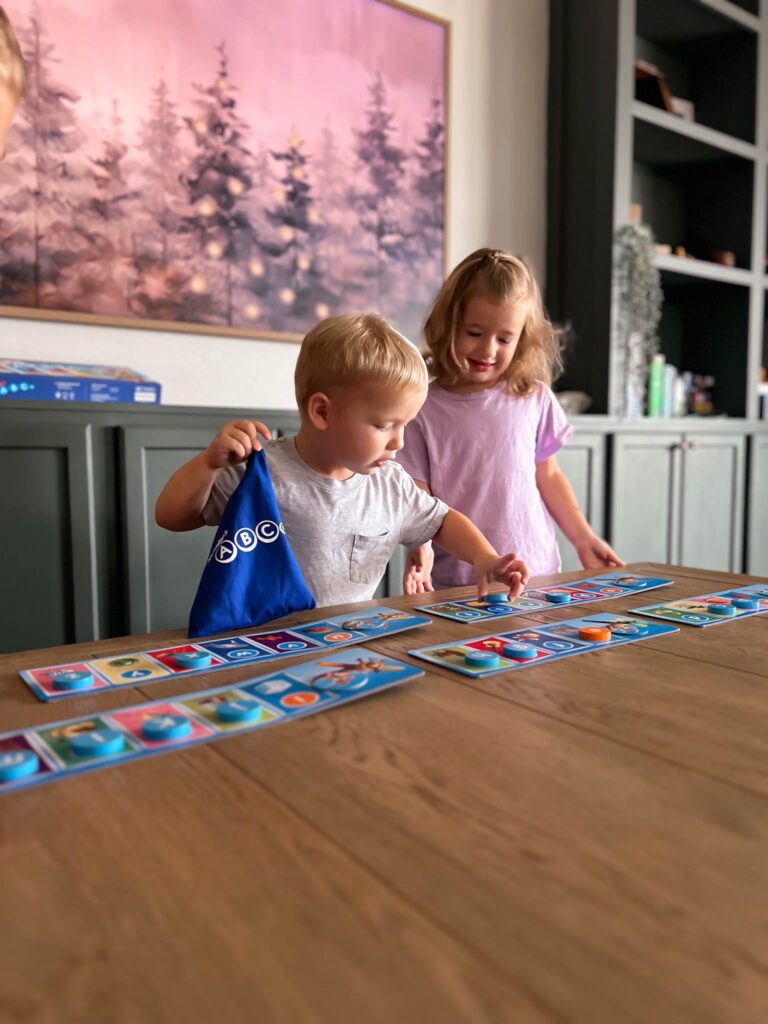
If you want to get right to our board game suggestions for emerging readers, you can skip this next session. But I want to first break down some of the key foundational skills emerging readers are progressing through that are key to their lifelong reading ability and literacy skills.
Foundational Reading Skills
- Phonemic Awareness Identify and Manipulate individual sounds Recognize rhyming words, initial, medial, and final sounds
- Print Awareness Understand that words are read left to right and top to bottom
- Phonics Decode words by blending letter sounds together
- Alphabet Knowledge Recognize upper and lower case letters Know the names and sounds of each letter
- Sight Word Recognition Memorize frequently used words by sight Develop sight word vocabulary for fluency
- Vocabulary Build a strong vocabulary through exposure to a large variety of words.
- Comprehension Make sense of what is read Create connections between text and prior knowledge
- Fluency Read with accuracy, speed, and expression
While all board games can provide a benefit, you’ll want to consider these foundational skills and which ones your child might need the most help with when choosing a board game with the intention to provide an engaging learning experience.
Here are some great board games we recommend to help emerging readers boost their reading skills.
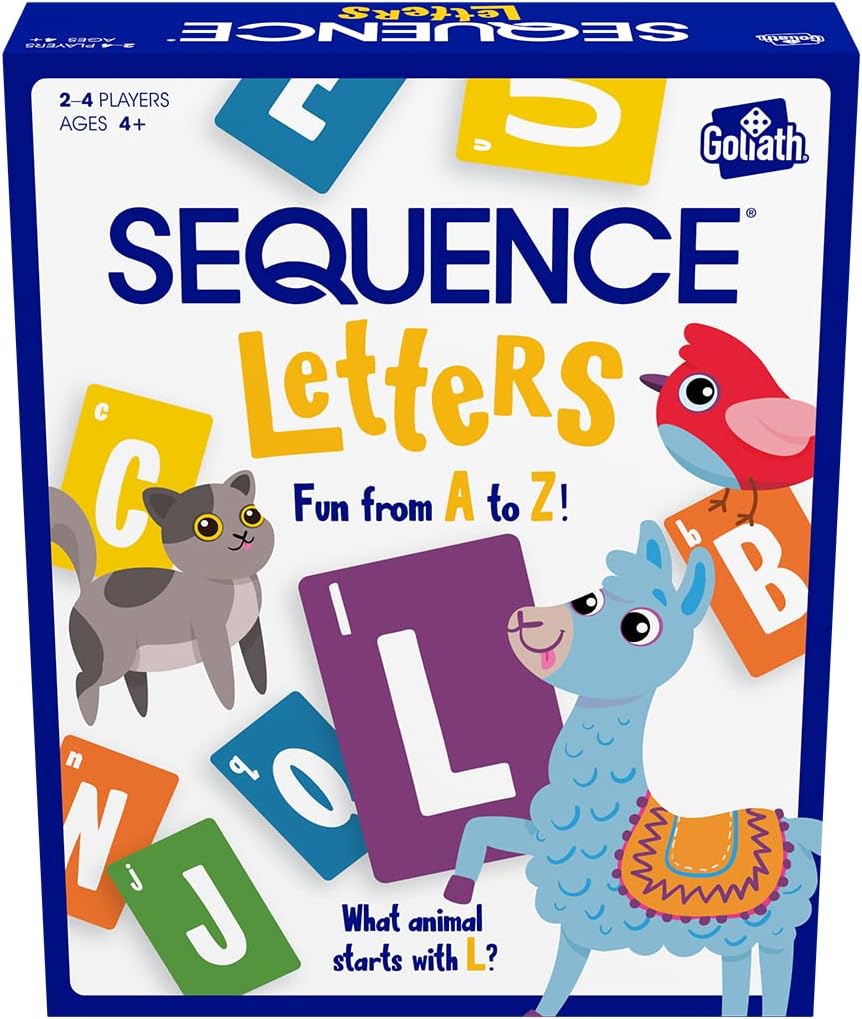
Sequence Letters
Great for younger learners to practice their letter recognition. Encourage students to practice sharing the sound(s) each letter makes during the game.
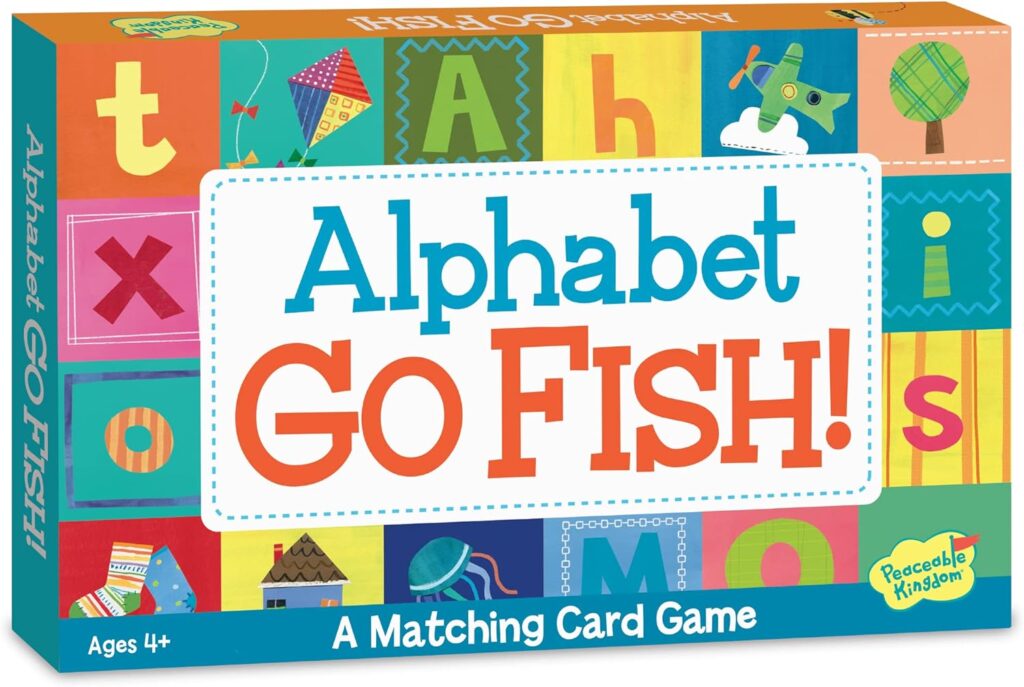
Alphabet Go Fish
We use this in our homeschool all the time. The oversized cards are great for little hands and the clear letters perfect for becoming familiar with letters at a young age.
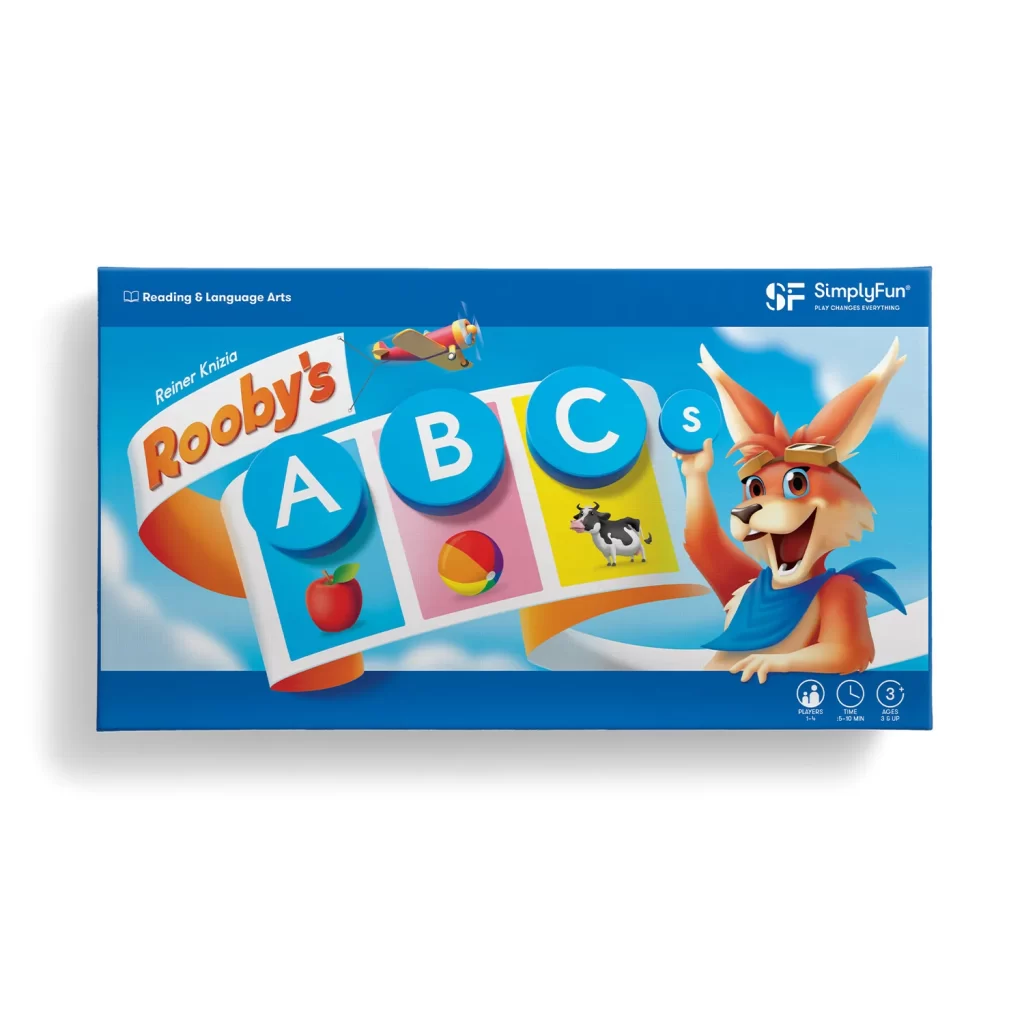
Rooby’s ABCs
So much of early literacy work requires consistent and dynamic exposure to the alphabet. I love Rooby’s ABCs for my younger learners to practice both upper and lowercase recognition. The materials are well made and the game is versatile for multiple types of play.
These classic games are also great for alphabet and spelling practice: My First Bananagrams, Banangrams , Scrabble , Boggle ,
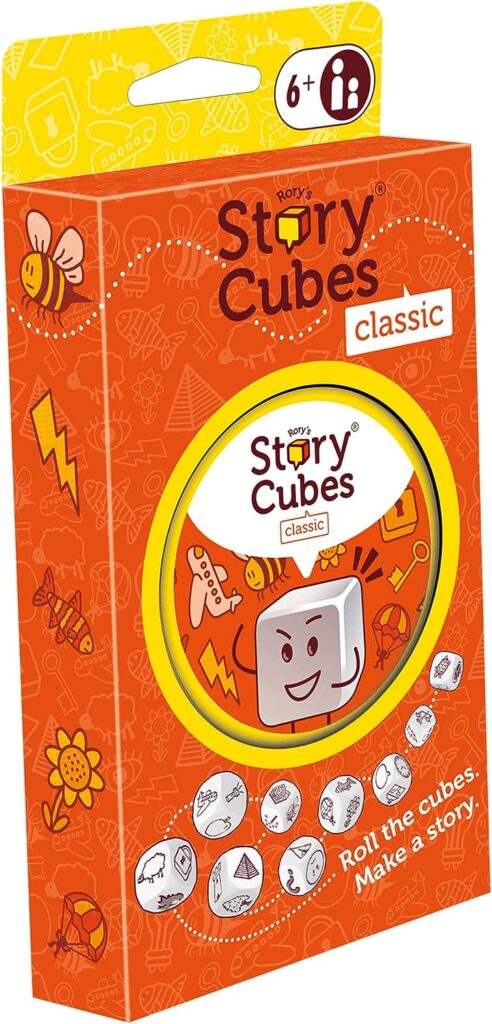
Story Cubes
While there are not actual words or letters in this game, learning to tell stories is a great way to increase vocabulary skills and comprehension. We also use our story cubes for creative writing lessons for our older children. They are incredibly versatile and great for all ages. We have multiple themed sets to create all sorts of stories that interest our kids.
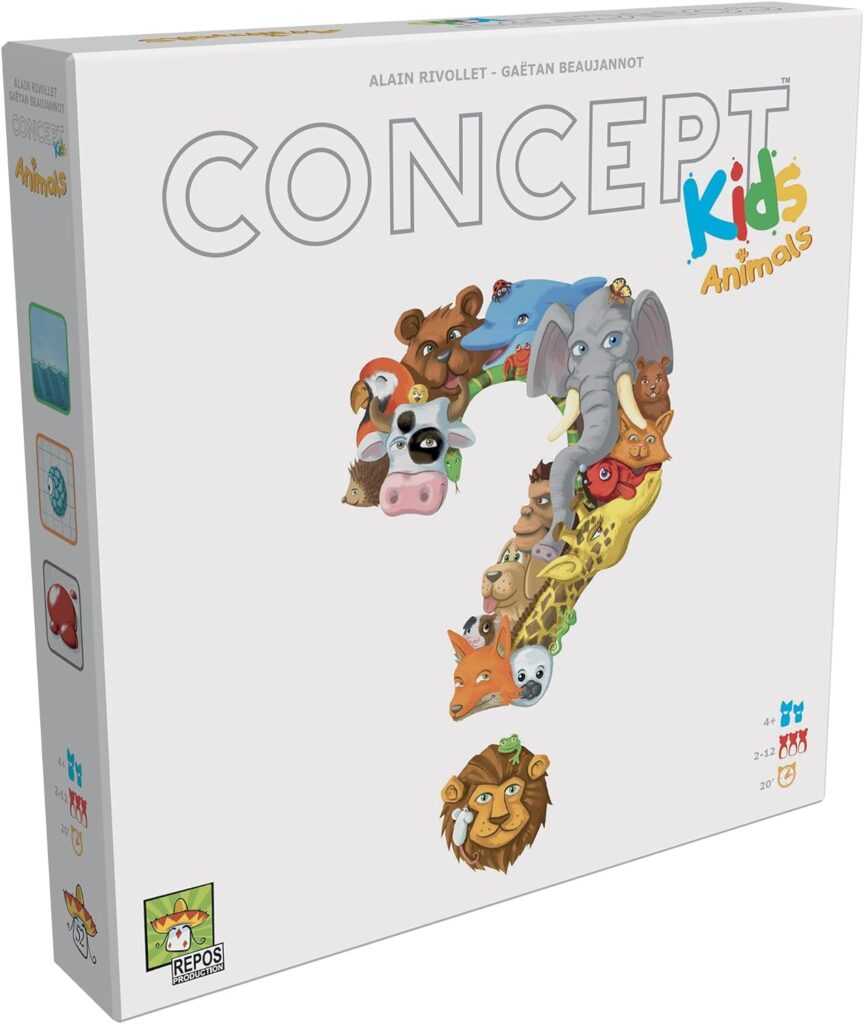
Concept Kids
This game helps kids build associations between animals and the icons on the board. The use of descriptive language, connection building, and vocabulary will help work on multiple key foundational skills. The lack of words will also be well received if you have any kids that are particularly averse to anything that even remotely looks like reading practice.
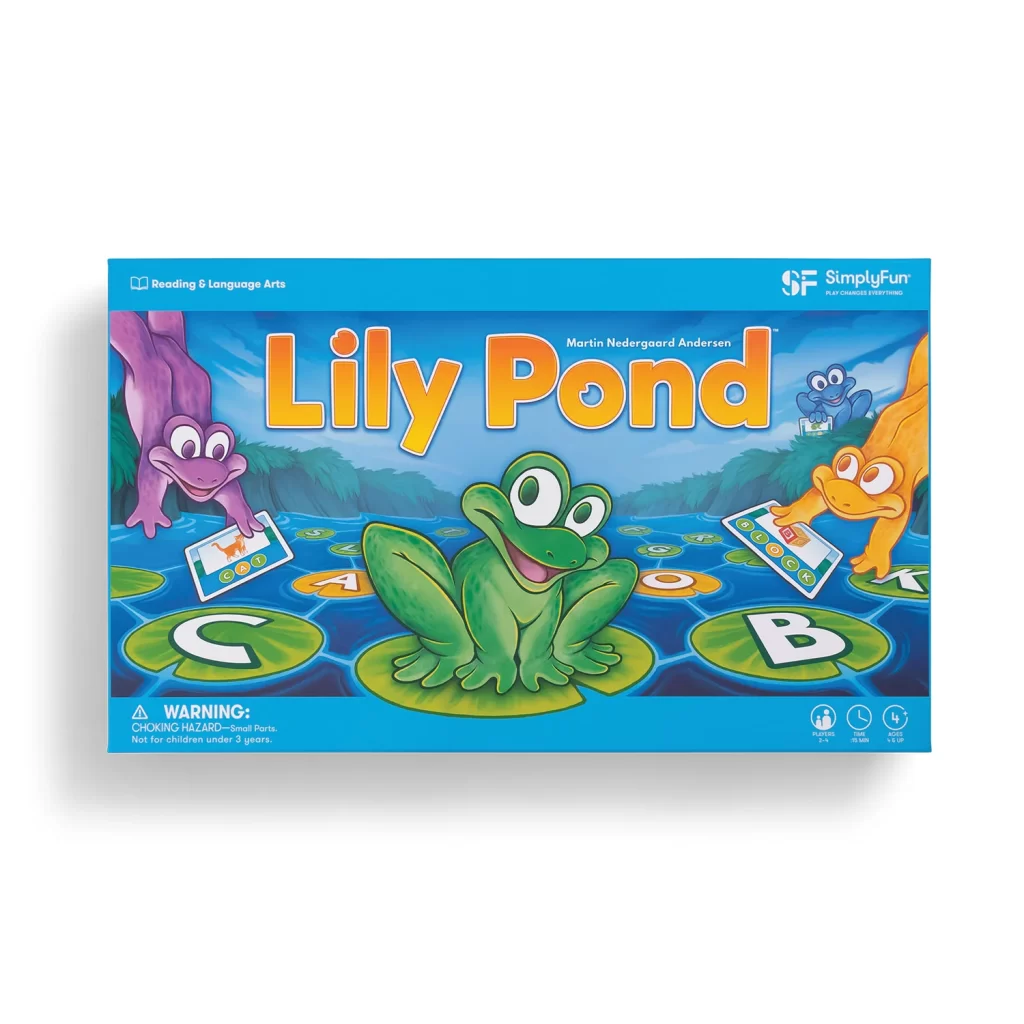
This game introduces kids to early spelling while engaging their critical thinking skills as they plan ways to get to the letters they need. This is a great game to work on phonetic blending, print awareness, and distinguishing vowels and consonants.
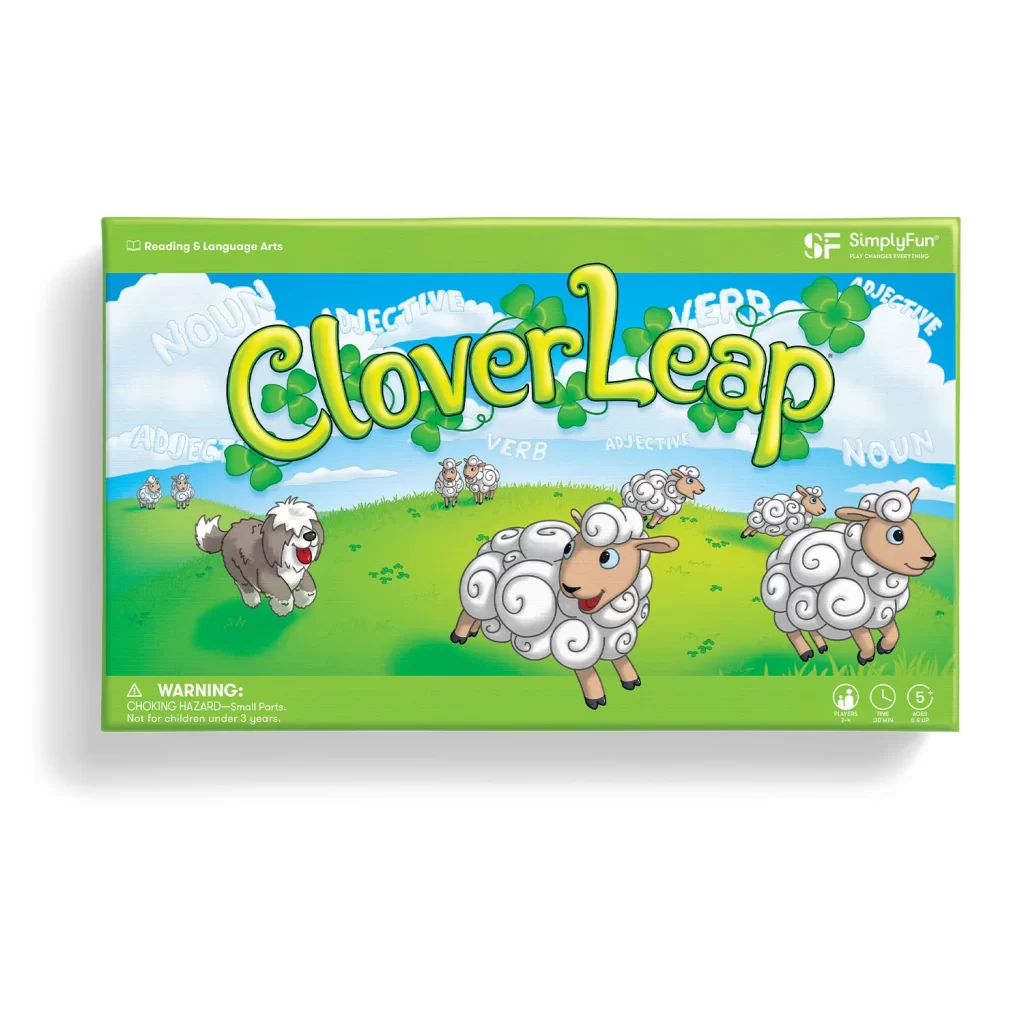
Clover Leap
Clover Leap offers a fun way to learn sentence structure, increased vocabulary, and fluency as you form silly sentences. This game has been an absolute hit for my struggling readers — they love getting the make up the silliest sentences so much that they don’t even realize they’ve been reading and rereading the words on the tiles.
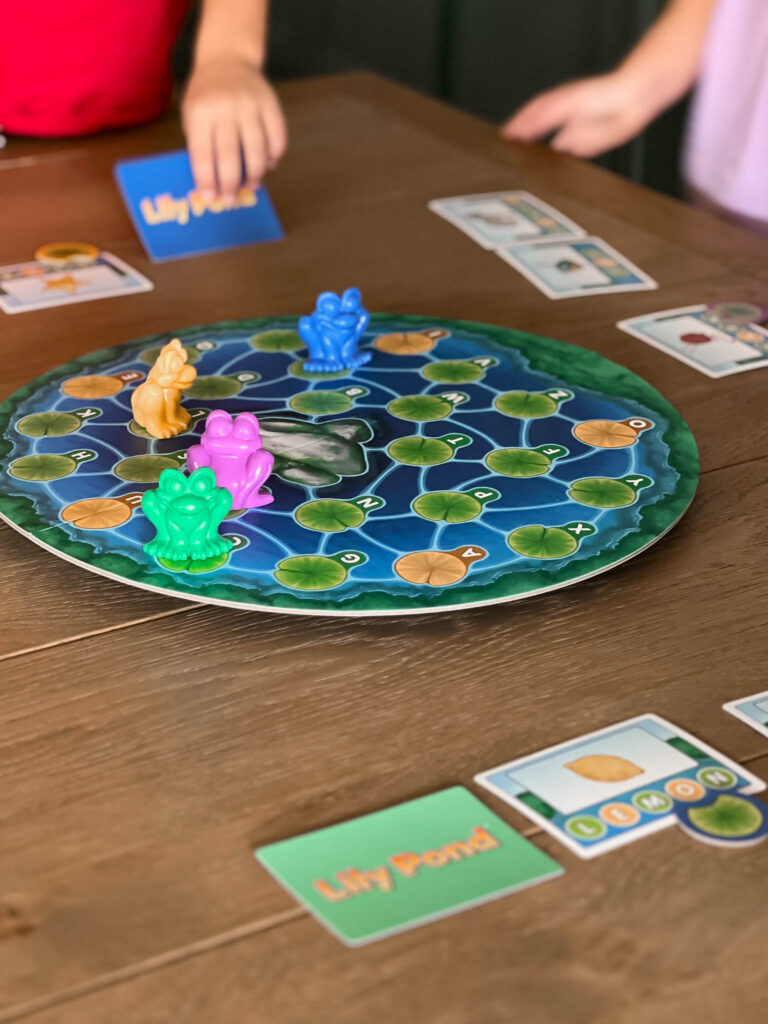
Just like Concept Kids above, but now for your upper elementary and beyond learners. This game introduces cards with words and phrases on them as well as a more complex icon board that will both challenge and improve reading and comprehension skills.
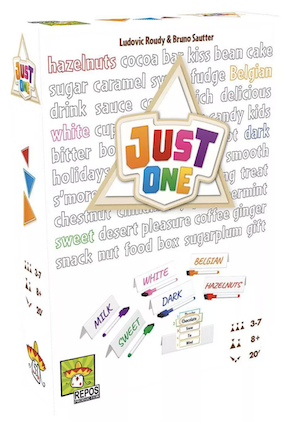
I love this game for reading practice! Perfect for kids to join in on and without a huge level of fluency required. Some words on the cards might stretch their abilities, but since its cooperative, you can help them decode words as needed and they can practice their spelling and writing when giving clues.
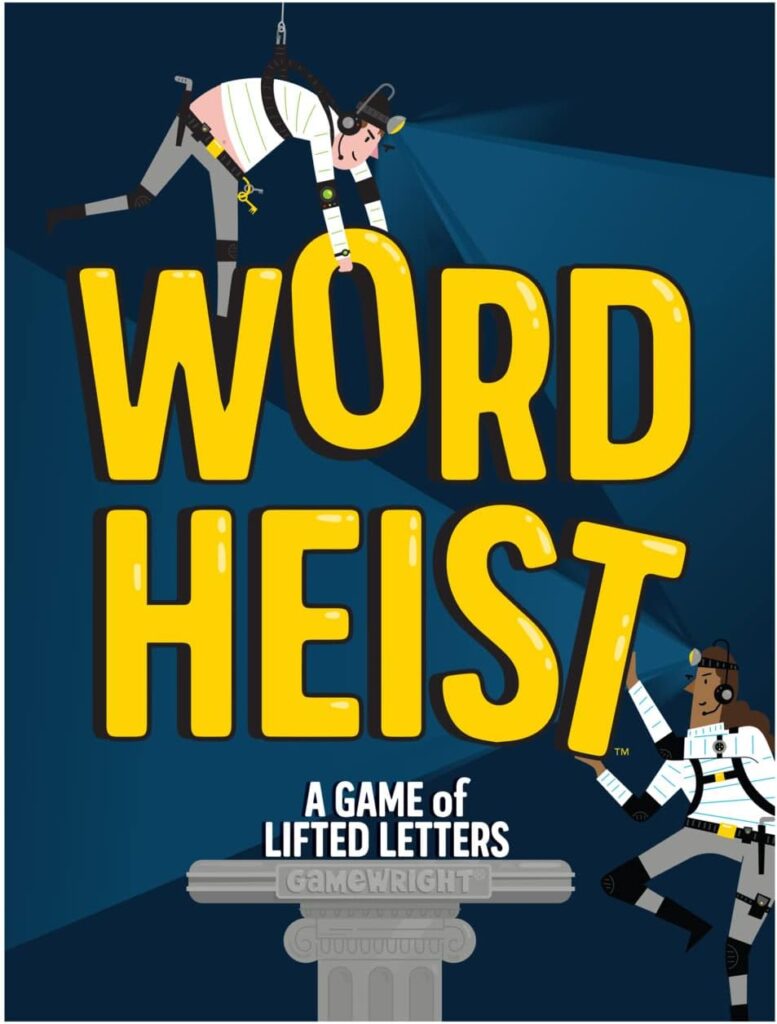
Excellent for spelling practice and dynamic manipulation of limited letters. This will engage their critical thinking and challenge them to use letters and words creatively. It’s also a great option for players who in general love word games.
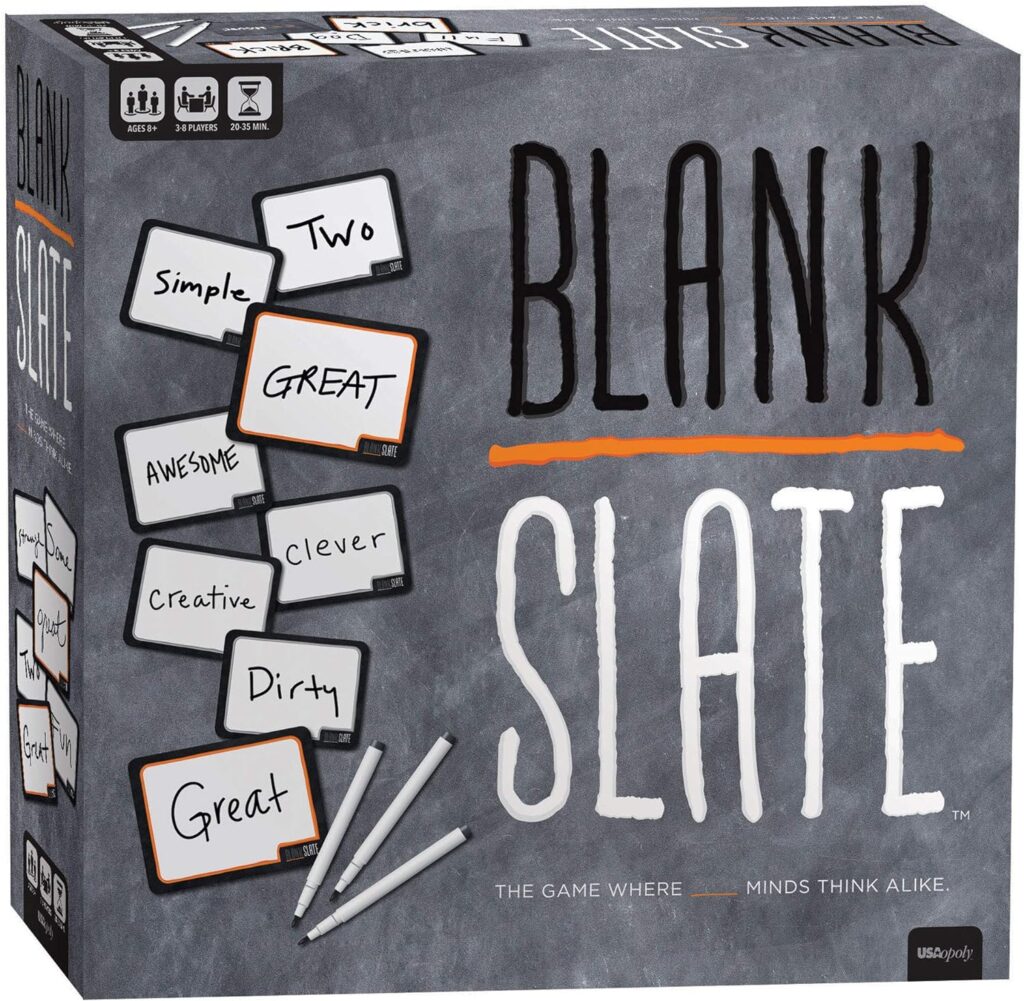
Blank Slate
Practice comprehension, connection building, spelling, and critical thinking! Blank Slate is top tier party game and great for helping emerging readers in upper elementary stretch their skills in a fun and engaging way.
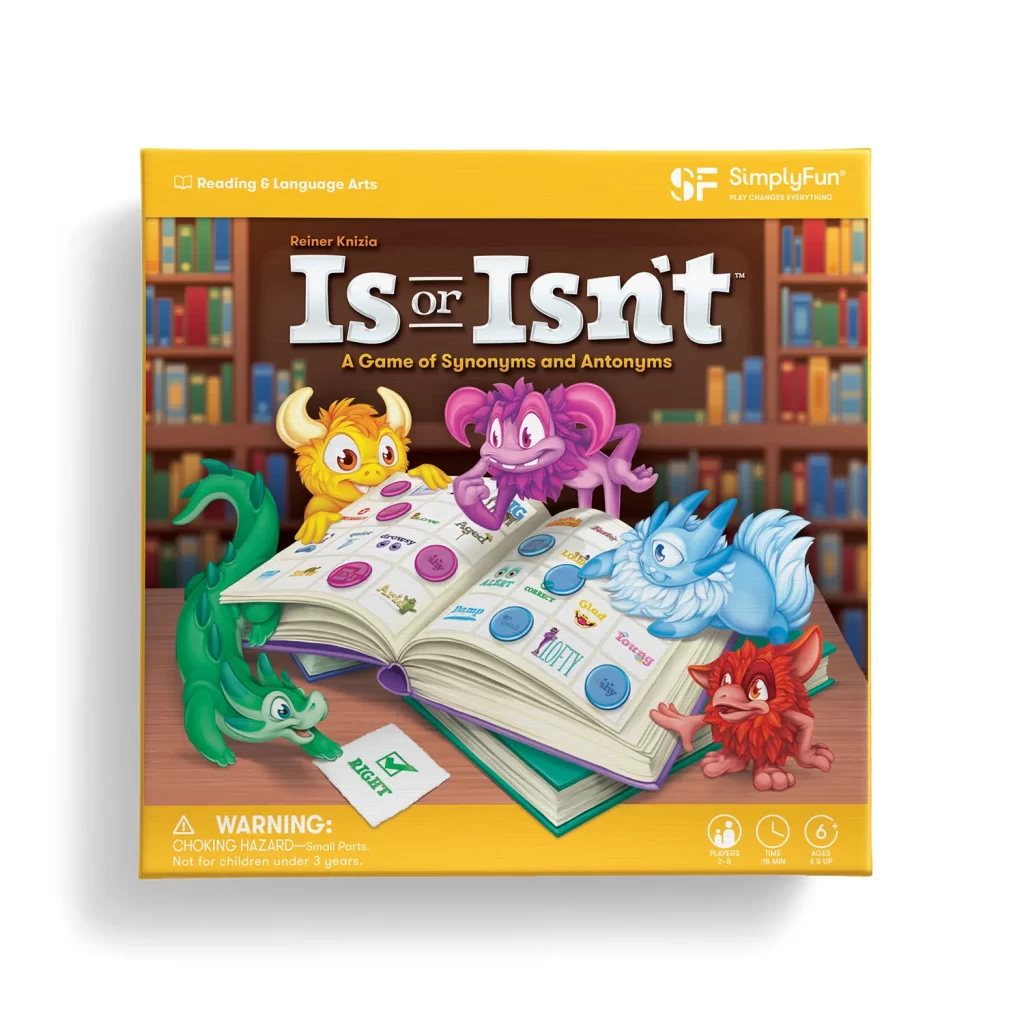
Is or Isn’t
Players will learn synonyms and antonyms in this cute game. Is or Isn’t provides many opportunities for kids to increase their vocabulary and word recognition.
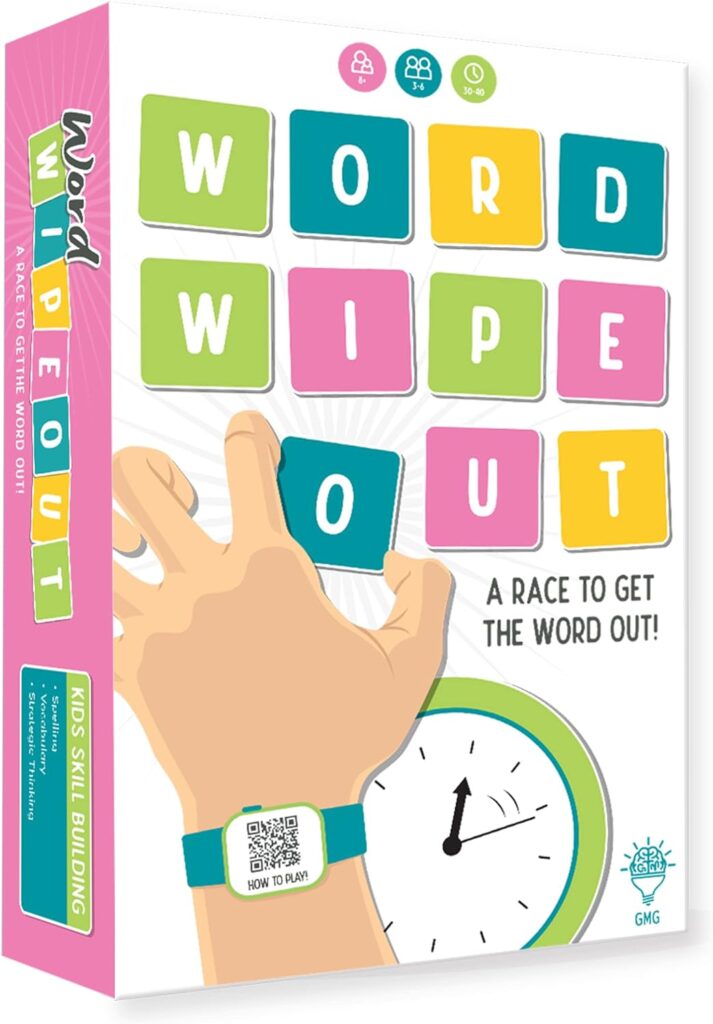
Word Wipeout
Great for spelling. Players will use the letter cards to spell out words that relate to the subject card. The longer the word, the more points you score. Use the timer for those that are ready to spelling under pressure, or play without to allow players a less stressful play environment.
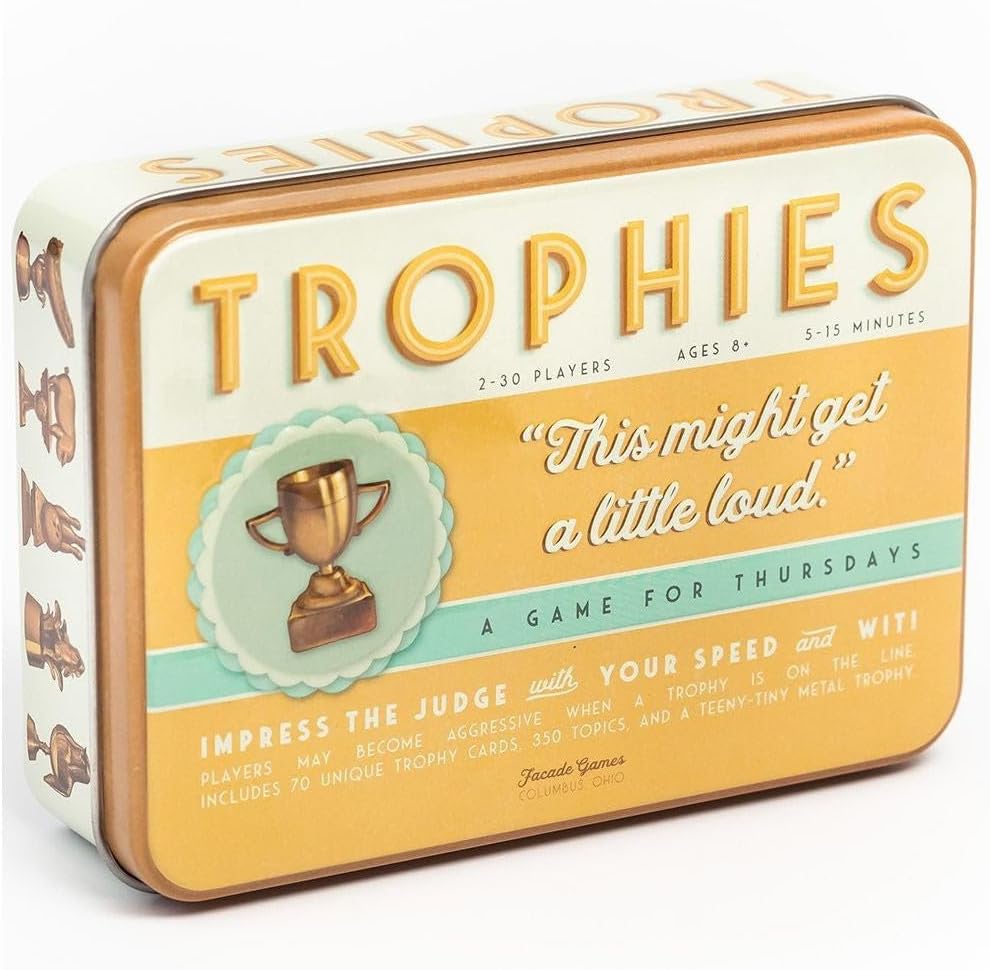
A fun party game but also a great way to incorporate phonics and sound blending! Players are given a topic and a letter, they must say words that begin with the letter that relate to the topic. Practice sounds, making connections, and quick thinking.
Narrative & Storytelling Games Board Games for Reading
In Storytelling games, players are often presented with a narrative situation where they will have to make a choice that impacts where the narrative takes them next. These can be great for igniting a love of stories and an interest in exploring books. There are many games in this style, here are a few of our favorites:
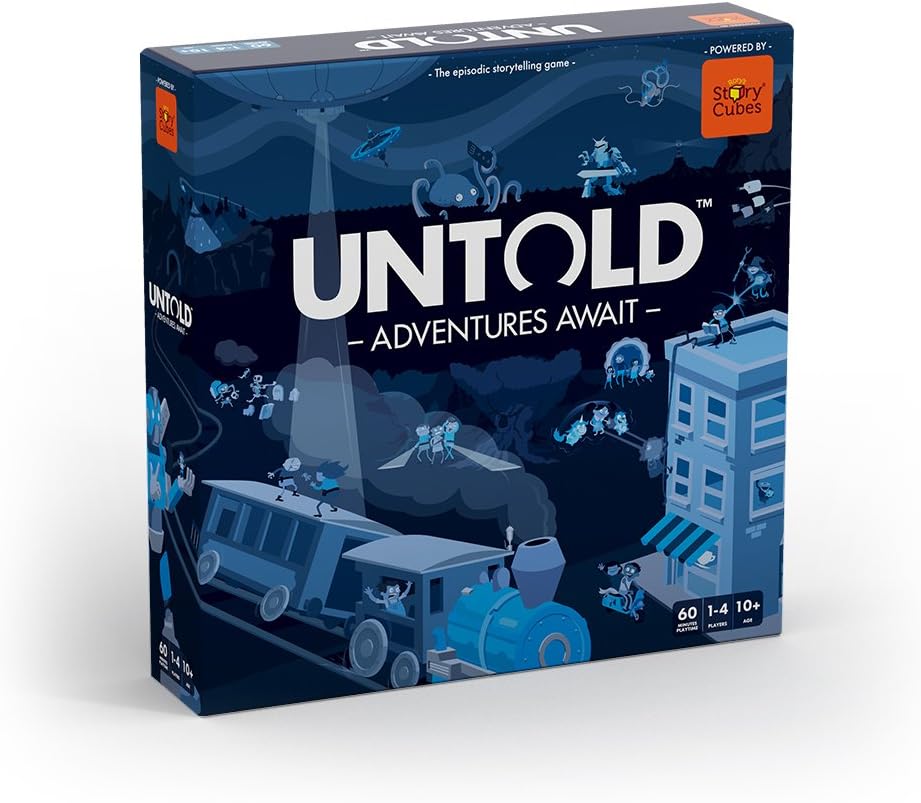
Untold: Adventures Await
This is a customizable storytelling game powered by Rory’s Story Cubes. Players craft their own collaborative story through multiple episodes story arcs, and work on character development. This is a must for older students who are ready to test their creative storytelling in a unique way.
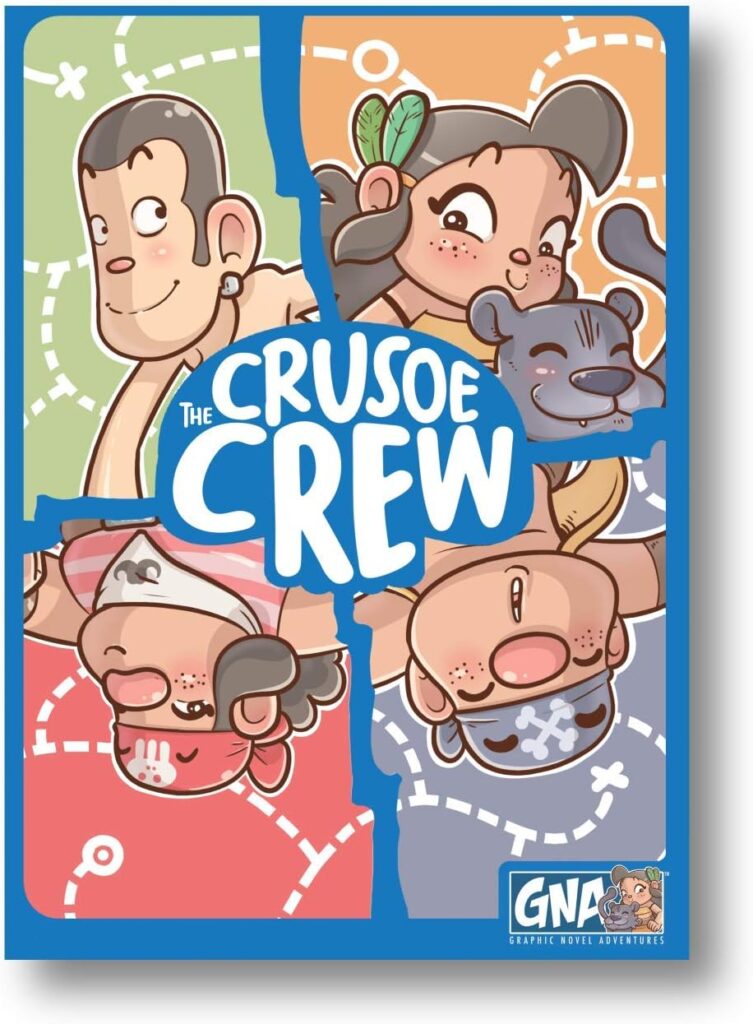
The Crusoe Crew
Combines a comic book style story with a role-playing game. This is a very clever graphic novel adventure where each player has their own book but must work together to make use of each characters abilities and progress through the story. There’s lots of reading throughout and players will read aloud from their graphic novel to the group.
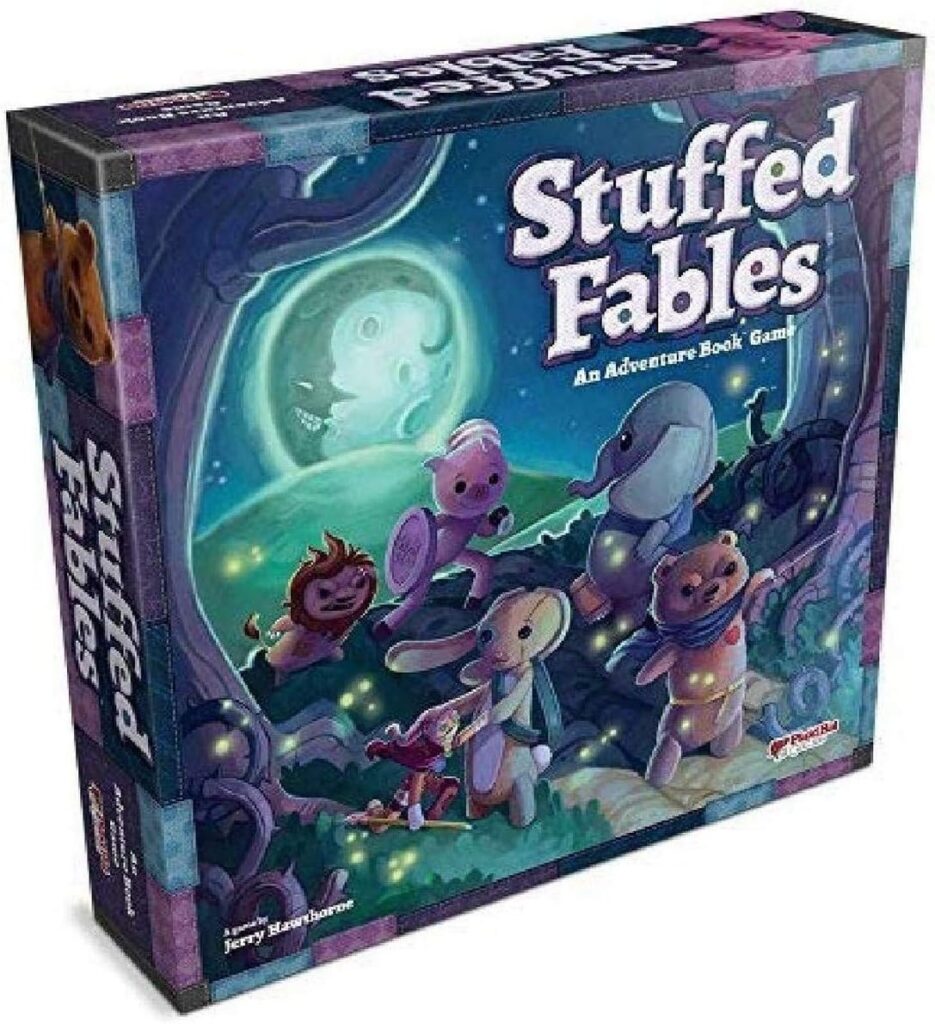
Stuffed Fables
Stuffed Fables offers the fun of a dungeon crawler with an all in one book that guides you through each new step in the story. This is great for comprehension, vocabulary, oral reading practice, and more.
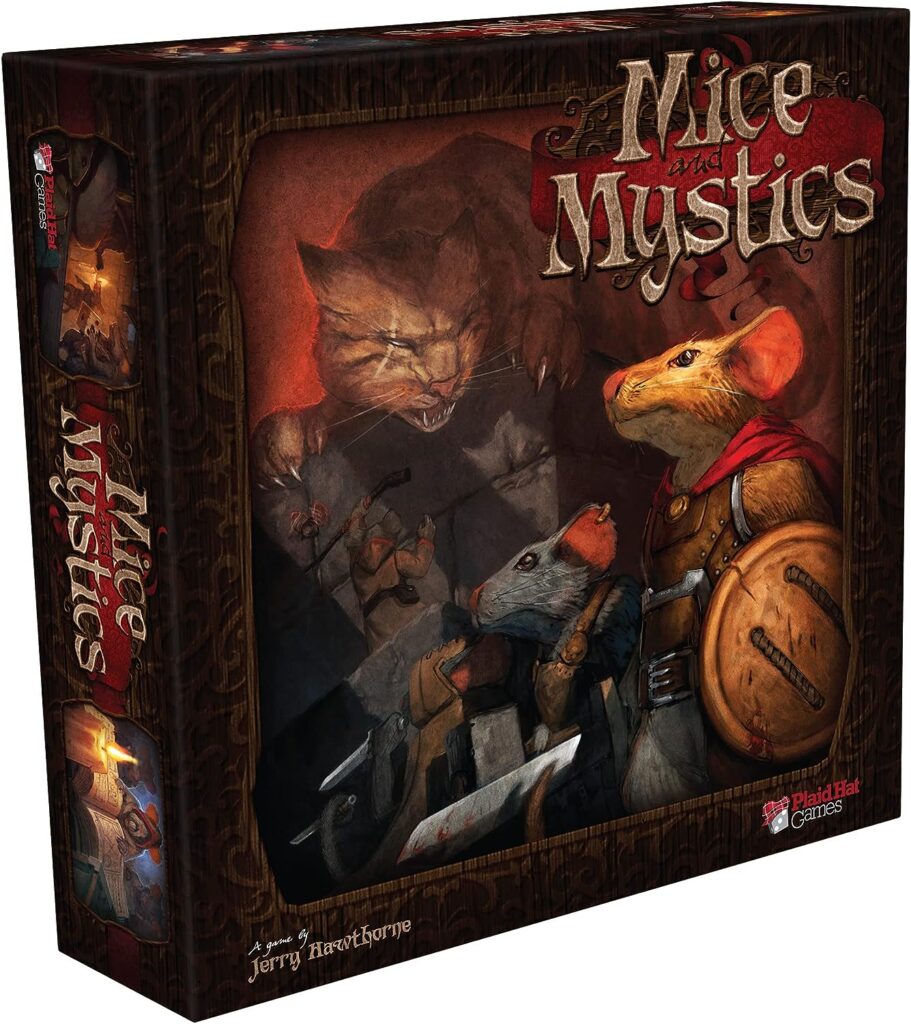
Mice and Mystics
Mice and Mystics is a cooperative dungeon crawler adventure game with an exciting narrative that immerses players into the story. You’ll play as mice racing through a castle to save the kingdom. This is great for comprehension, vocabulary, oral reading practice, and more.
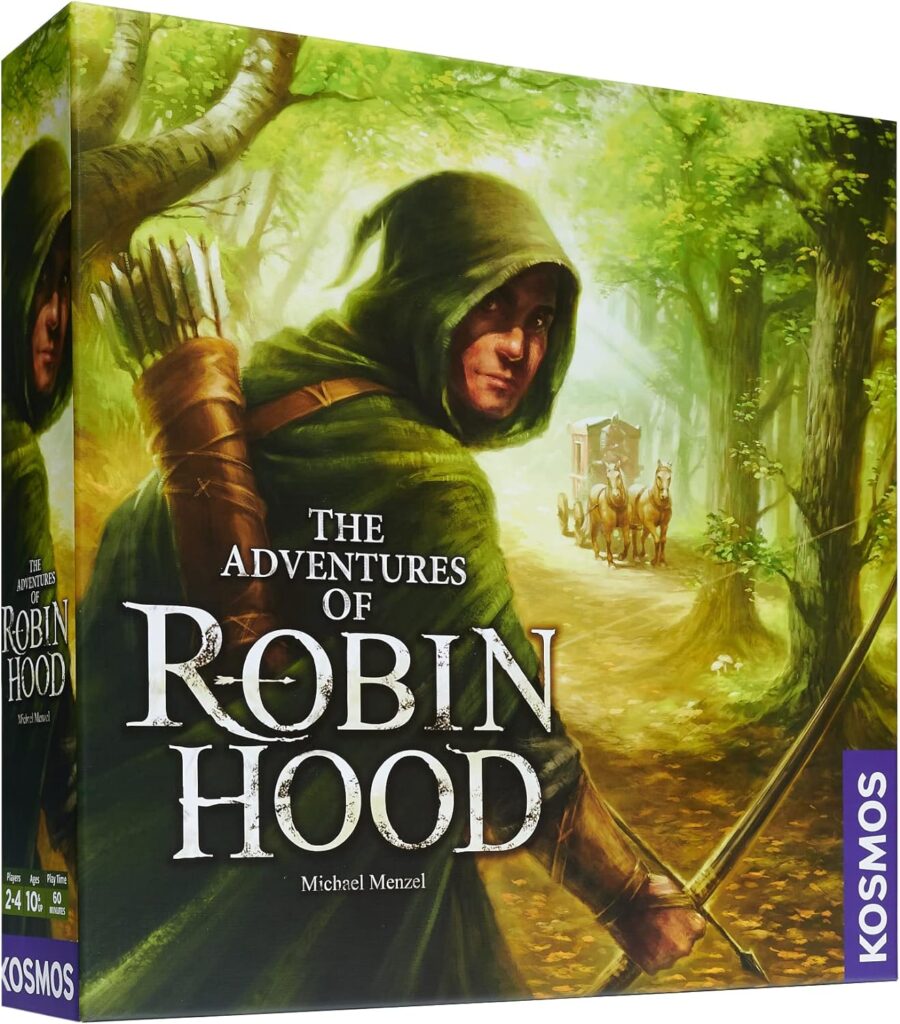
The Adventures of Robin Hood
Players will take on the role of Robin Hood and his companions. The game plays out on a living board which will change throughout each session. This is one of the more perfect blends of immersive storytelling and innovative game play that our family has tried. There is extensive reading required throughout. The game comes with a large hardcover book that tells the story; players can take turns as the narrator for excellent reading practice.
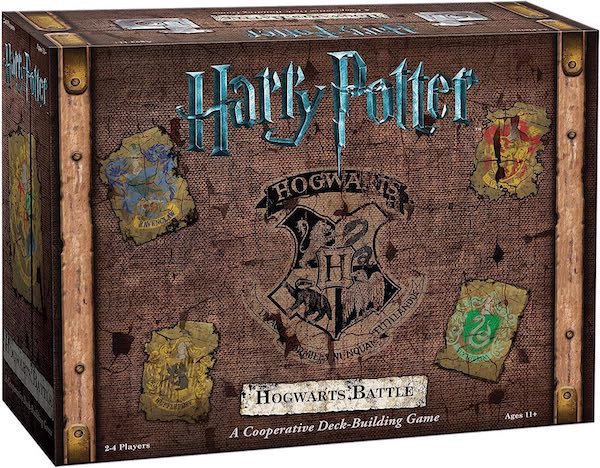
Harry Potter: Hogwarts Battle
This isn’t quite a narrative game like those above, but we think there’s enough reading and comprehension skills required to make it a good fit for readers learning to stretch their skills. We’ve been playing it in tandem with our family read-a-loud journey through all 7 novels and it has provided a great way to retell the story, practice reading through the in-game text, and motivate our children to dive back into the novels.
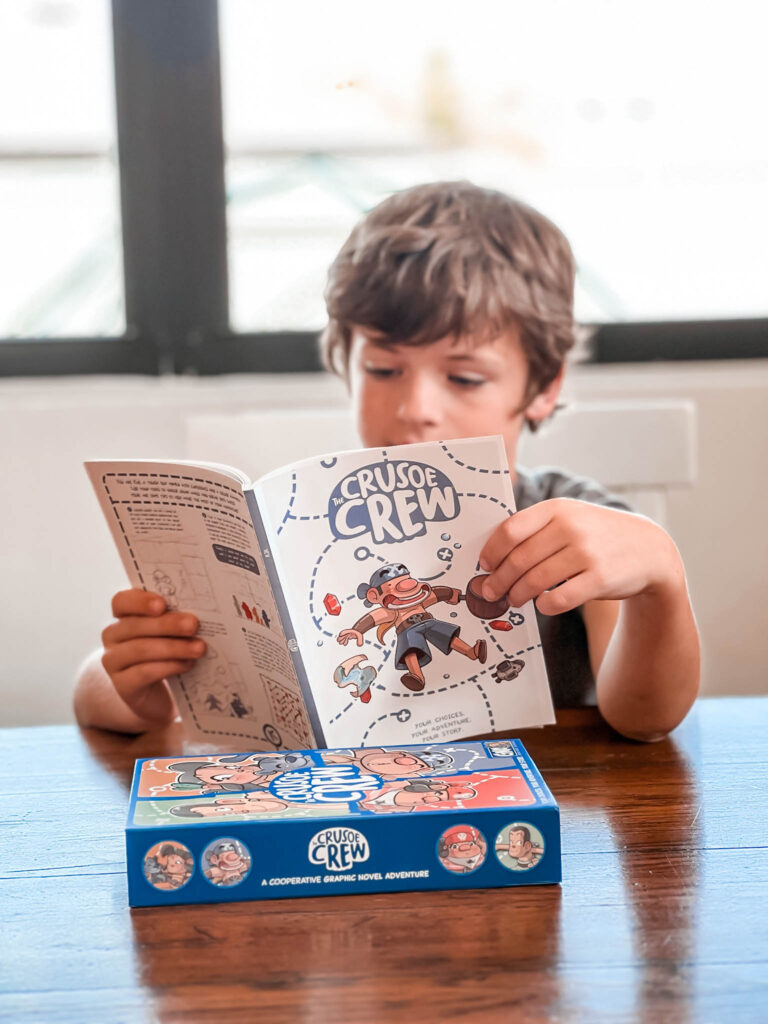
If you enjoyed this post on board games for reading, you may also like
15+ Board Games that Help Teach Math Educational Games for Summer Break Board Games for Kids by Age
Related Posts
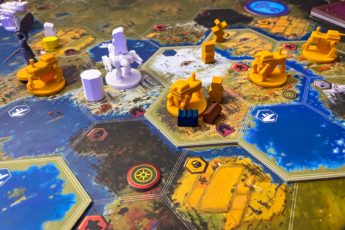
5 Expansions Under $25
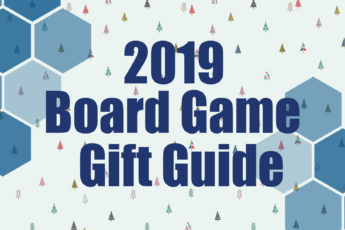
2019 Board Game Gift Guide
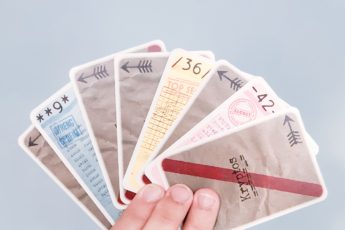
10 Great Deduction Board Games
Comments are closed.

Adam + Kelsey
Hey there! Thanks for being here! We’re Adam and Kelsey and we, along with our seven kids, love to play board games! Here you’ll find all our top game recommendations so you and your family can play only the best games together!
Amazon Associates Disclosure
The Tabletop Family is a participant in the Amazon Services LLC Associates Program, an affiliate advertising program designed to provide a means for sites to earn advertising fees by advertising and linking to amazon.com.
Instagram Feed

tabletopfamily

Popular Posts
Teaching with games: the magic labyrinth, first orchard by haba, why we play boardgames.

Microsoft Copilot
Microsoft copilot is your everyday ai companion that helps you to be smarter, more productive, more creative, and more connected to the people and things around you. whether you want to learn how to code, plan an influencer level vacation, or just need a little help writing a hard email, your everyday ai companion is there to help you get the job done like a pro. if you missed that meeting and need a quick recap or can’t figure out the tax code for your new side hustle, copilot is there to sprinkle some ai pixie dust on the problem. there when you need it, copilot works smoothly, seamlessly, and securely across your microsoft apps to elevate everything you do. speed up tasks, get more personalized answers and useful information, or find new creative inspiration. and you can do it all by asking for what you want the way you naturally write and speak. it doesn’t care if the task is big or small, it’s just there to help you get the job done. copilot empowers you to achieve anything you can imagine., 4/25/2024 3:53:49 am.

IMAGES
VIDEO
COMMENTS
1. The storyteller picks a card from their deck and describes it any way they want to. 2. The other players choose a card that they think also fits that description. 3. The cards are turned over and the players must pick the card that they believe to be the storyteller's. How it helps writers:
Spying Parts of Speech Board Game. Grammar is an important part of writing. You want your kids to have written language skills that make their writing easy to understand. This educational board game helps them get a better handle on the parts of speech they'll use as they write. How to Play.
Roll badly and you could find yourself writing a truly horrible bit of correspondence. Luke's Take. This game is so good for writers, and it offers some really amazing worldbuilding opportunities. You could assume the roll of a character within your world and actually write correspondence as them.
Published by: Create Press www.createpress.com P.O. Box 2785 Carlsbad, CA 92018-2785 760-730-9550 $44.95 plus S&H Online Teachers Manual available at website Ages 5-99 (adult assistance is requ…
Case Study 1: Impact on Writing Style and Creativity. Meet Sarah, a 12-year-old aspiring writer. She loved to write, but her stories were often flat and lacked creativity. Then, she started playing a storytelling game called "Story Cubes". After playing the game for a few weeks, Sarah's writing began to change.
105 creative writing exercises to get you writing again. Try these short, 10-minute creative writing exercises to beat writer's block. ... Board Games (3) Book Quotes (18) Book Reviews (5) Bullet Journals (7) Buying Guides (7) Christmas (18) Creativity Techniques (8) Dr. Seuss (3) Dragons (8) Easter (3) Freebies (19) Fun Word Lists (4) Guest ...
Make it a handwriting game: You'll need to add some time to the clock to make this into a handwriting game. Challenge kids to write their 3 answers instead of calling them out. Decrease the length of time for more of a challenge or add more time to the clock to make it a little easier. Change how many items they have to write down in the ...
Here are some popular creative board games: Dixit: This game tests your ability to think creatively and interpret others' ideas. Mice and Mystics: It's a game where players are turned into mice and must navigate through a castle's many dangers. Betrayal at House on the Hill: This game offers a new spooky storyline every time you play.
Board games can be much more than a simple pastime activity. They can teach, inspire, and motivate us to create. Each board game is a whole new world to explore. You can learn from it and learn based on it. Hopefully, these three games will show you how diverse, beautiful, and creative board games can be. So choose your game and have fun!
Endless stories, endless educational uses. StoriumEDU is a "Swiss army knife" that supports an impressively wide range of educational goals. You can use story cards and curricular content from our growing library , created by teachers just like you. You can also easily create your own cards to support your own unique classroom needs.
It certainly got me writing and I based my story on the game, Operation. Here it is: Mike lowers his tweezers into the ankle. I hold my breath. He slowly takes the broken bone out. I release my breath with a frustrated hiss as Mike sighs with relief and drops the bone into his pile. He leans back on his chair, satisfied.
The last player unfolds the paper and uses the answers to tell the story. 6. Mad Libs. Mad Libs have been around for decades and are still pretty popular. Now only is it a fun storytelling adventure, it's also a chance to each your kids grammar and sentence structure. Start by working your way through a couple books.
Advisory Board WI Poet Laureate Commission Support BJ Hollars. November 29, 2020. Featured. 5 Fun Writing Games to Play While You're Waiting for Inspiration to Strike. BJ Hollars. November 29, 2020. Featured " Creative people often get stuck in their heads about their projects and it's difficult to escape that spiral, especially when a ...
Telephone Pictionary Game. Another brilliant creative writing activity is the Telephone Pictionary Game. The basic idea behind this game is to write a story collaboratively with your team using drawings and phrases. Together as team members take turns to write/draw something down.
Welcome to Team Scriber. Team Scriber is an interactive creative writing game. Readers: think create your own story on a large scale; writers: think x-factor for authors. It's a competition and everyone gets a vote - even non-contributors. The end result is a dynamic co-created narrative. Team Scriber is an interactive creative writing game.
First, decide on the theme of the game. In this example, we'll be matching antonyms, or opposite words. Start by cutting a sheet of paper into eight different pieces. In four of the pieces, write down your original words, and in the remaining four pieces, their opposites. Once all your words are ready, ask your child to match each word to ...
10 Best Games for Nurturing Creativity. - Dixit (recommended age 7+) features 84 cards with whimsical paintings, full of symbolic meanings and allusions. Usually, each session of this game starts and ends with players, looking through cards and marvelling at the imagination that produced them. In my opinion, it is one of the most beautifully ...
This is a really fun online writing game for kids ages 6 to 12. It's engaging and also includes feedback on what they're writing. It includes creative writing, spelling practice, and grammar instruction. If your kids enjoy fantasy or animals, then they will like this game! They have given my readers a 7 day free trial & 50% off a membership!
Word Association Game. Word association games are perfect for 10-minute writing games! Start by giving students a random word and ask them to write down the first word that comes to their mind when they hear it. Then, have them pass their paper to the person next to them and repeat the process with the new word.
This no-prep creative writing bundle will immerse grade 10-12 students in poetry writing for 6 engaging weeks of vibrant lessons, crammed with activities and games! This 30% off bundle will inspire students' love of poetry, give them weeks of writing in a variety of genres, and even help them to rev. 5. Products. $13.75 $19.69 Save $5.94.
Try these fun games for children to begin their lessons in writing. 1. Secret Pictionary. A game of Pictionary is fun to play when there are more than three players. You can play this game even without the Pictionary cards as all you need is a pencil and a blank paper.
Board Game Creation: Design your own board game, complete with rules and pieces. Mindfulness Exercises: Practice mindfulness exercises like meditation or deep breathing to clear your mind and tap into your creativity. Creative Writing Prompts: Use writing prompts to spark your imagination and explore new ideas.
So, to make it easier for you, here are 15 creative DIY board game ideas from which you should take inspiration. This is also a great summer activity you can do with your kids to keep them entertained. Half of the fun is making the board game, after all, not just playing it! 1. PUZZLE GAME
Learning to read through play with board games. Gift Guides! Home; Reviews. Our 2023 Gaming Year in Review; Comparing the Top Board Game Mats; Everdell Board Game Review ... We also use our story cubes for creative writing lessons for our older children. ... you can help them decode words as needed and they can practice their spelling and ...
Microsoft Copilot is your everyday AI companion that helps you to be smarter, more productive, more creative, and more connected to the people and things around you. Whether you want to learn how to code, plan an Influencer level vacation, or just need a little help writing a hard email, your everyday AI companion is there to help you get the job done like a pro.